How to Make a Resume in 2024 | Beginner's Guide

For most job-seekers, a good resume is what stands between a dream job and Choice D. Get your resume right, and you’ll be getting replies from every other company you apply to.
If your resume game is weak, though, you’ll end up sitting around for weeks, maybe even months, before you even get a single response.
So you’re probably wondering how you can write a resume that gets you an interview straight up.
Well, you’ve come to the right place!
In this guide, we’re going to teach you everything you need to know about how to make a resume, including:
- The 8 Essential Steps to Writing a Resume
- 11+ Exclusive Resume Tips to Up Your Resume Game
- 27+ Real-Life Resume Examples for Different Professions
….and more!
So, let’s dive right in.

How to Make a Resume (The Right Way!)
Before we go into detail about how you should make a resume, here’s a summary of the most important steps and tips to keep in mind:
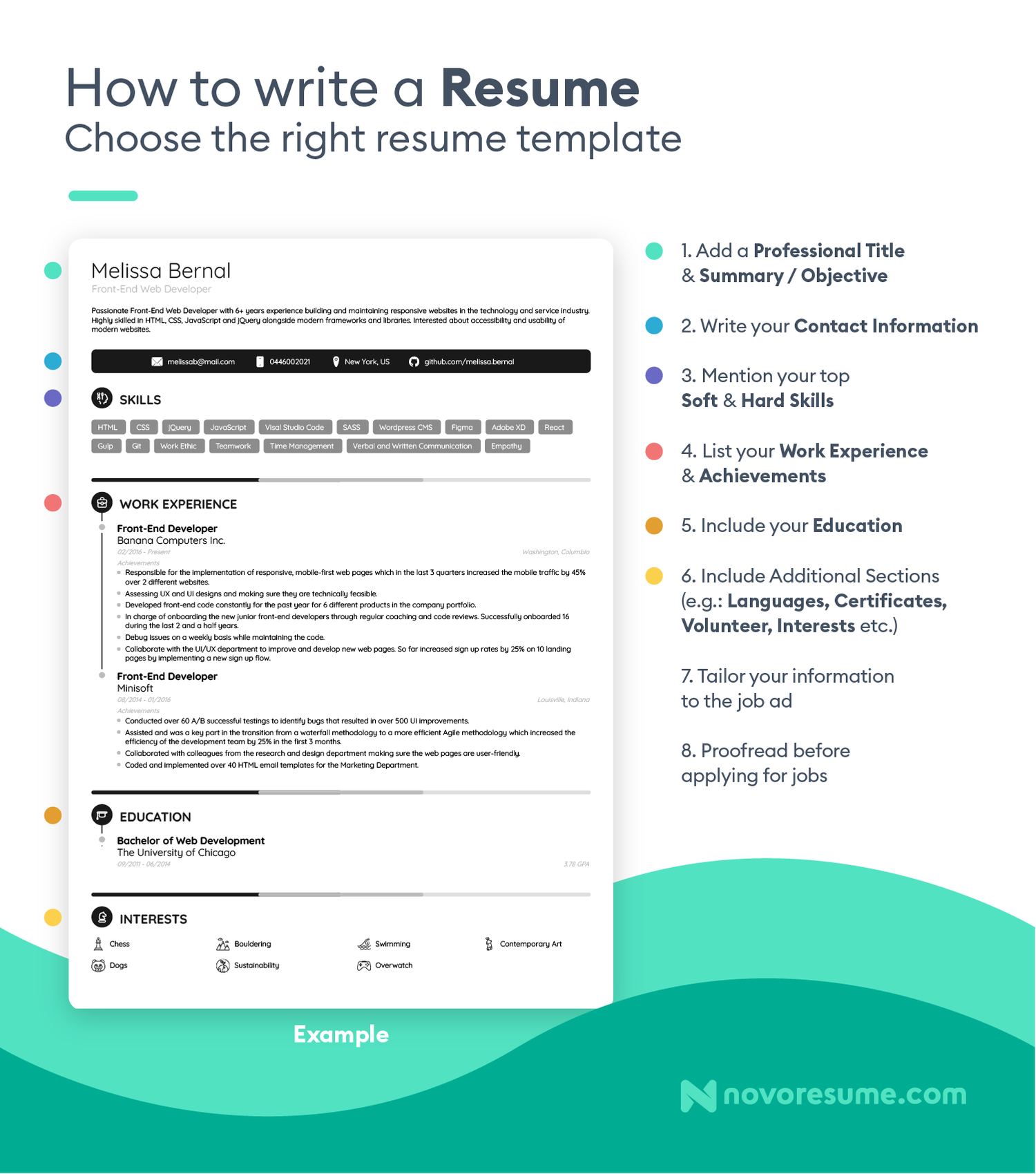
- Choose a resume format carefully. In 99% of cases, we recommend the reverse-chronological format .
- Add the right contact details. Leave your headshot out and make sure to include your job title , a professional email address, and any relevant links. (E.g.: your LinkedIn profile , online portfolio, personal website, etc.).
- Write an impactful resume summary. Unless you’re an entry-level professional, always go for a resume summary. If you do it right, it’s your chance to get the hiring manager to go through the rest of your resume in detail.
- Pay attention to your work experience section. Take your work experience section from OK-ish to exceptional by tailoring it to the job ad, making your achievements quantifiable, and using action verbs and power words.
- Add the right skills for the job. Keep this section relevant by only including the hard and soft skills that are required for the position.
- Keep your education short and to the point. Your most recent and highest degree is more than enough for a strong education section. You only need to add more details here if you’re a recent graduate with barely any work experience.
- Leverage optional resume sections. Optional sections like languages, hobbies, certifications, independent projects, and others can set you apart from other candidates with similar skills and experience.
- Include a cover letter. That’s right, cover letters matter in 2024, and the best way to supplement your resume is by adding an equally well-crafted cover letter to your job application. To make the most of it, check out our detailed guide on how to write a cover letter .
To get the most out of our tips, you can head over to the resume builder and start building your resume on the go as you read this guide.
New to resume-making? Give our ‘7 Resume Tips’ video a watch before diving into the article!
#1. Pick the Right Resume Format
Before you start filling in the contents of your resume, you have to make sure it’s going to look good.
After all, the first thing hiring managers notice is what your resume looks like, and then they start reading it. So, this is your best chance to make a great first impression.
Start by choosing the right resume format.
There are three types of resume formats out there:
- Reverse-chronological. This is by far the most popular resume format worldwide and, as such, it’s the best format for most job-seekers.
- Functional. This resume format focuses more on skills than work experience. It’s a good choice if you’re just getting started with your career and have little to no experience in the field.
- Combination. The combination resume format is a great choice for experienced job-seekers with a very diverse skill set. It’s useful if you’re applying for a role that requires expertise in several different fields and you want to show all that in your resume.
So, which one should you go for?
In 99% of cases, you want to stick to the reverse-chronological resume format . It’s the most popular format and what hiring managers expect to see. So, in the rest of this guide, we’re going to focus on teaching you how to make a reverse-chronological resume.
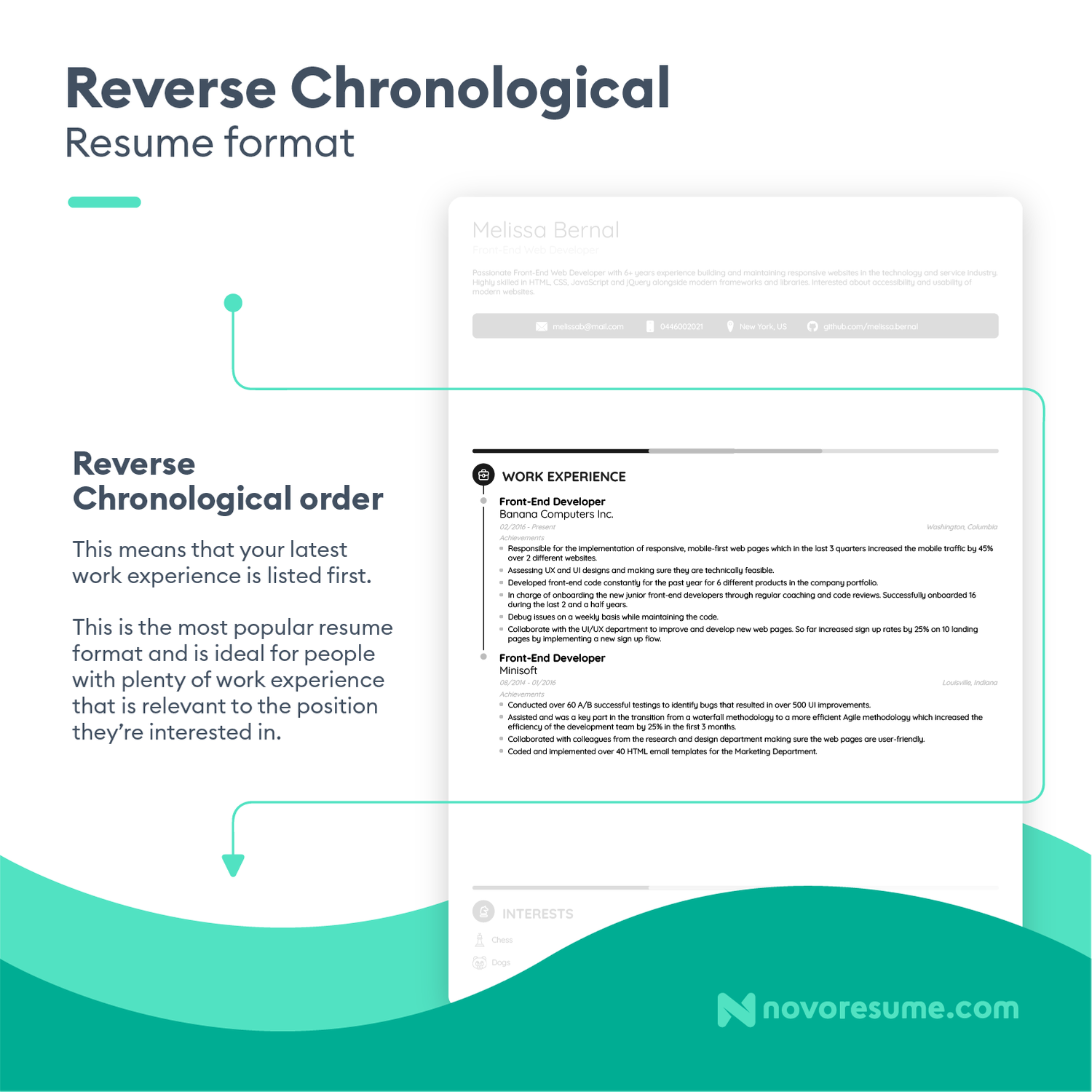
Fix Your Resume’s Layout
With formatting out of the way, let’s talk about your resume’s layout , which determines the overall look of your resume.
Does it look organized or cluttered? Is it too short or too long? Is it boring and easy to ignore, or is it reader-friendly and attention-grabbing?
Here are some of the best practices you should apply:
- Stick to one page. You should only go for a two-page resume if you have decades of experience and you’re sure the extra space will add significant value. Hiring managers in big companies get hundreds of applications per job opening. They’re not going to spend their valuable time reading your life story!
- Add clear section headings. Pick a heading and use it for all the section headers so the hiring manager can easily navigate through your resume.
- Adjust the margins. Without the right amount of white space, your resume will end up looking overcrowded with information. Set your margins to one inch on all sides so your text fits just right on the page.
- Choose a professional font. We’d recommend sticking to a font that’s professional but not overused. For example, Ubuntu, Roboto, or Overpass. Avoid Times New Roman, and never use Comic Sans.
- Set the correct font size. As a rule of thumb, go for 11-12 pt for normal text and 14-16 pt for section titles.
- Use a PDF file. Always save your resume as a PDF file, unless the employer specifically requests otherwise. Word files are popular, but there’s a good chance they’ll mess up your resume’s formatting.
Another thing you need to consider in terms of your resume’s layout is whether you’re going for a traditional-looking resume template or something a bit more modern :
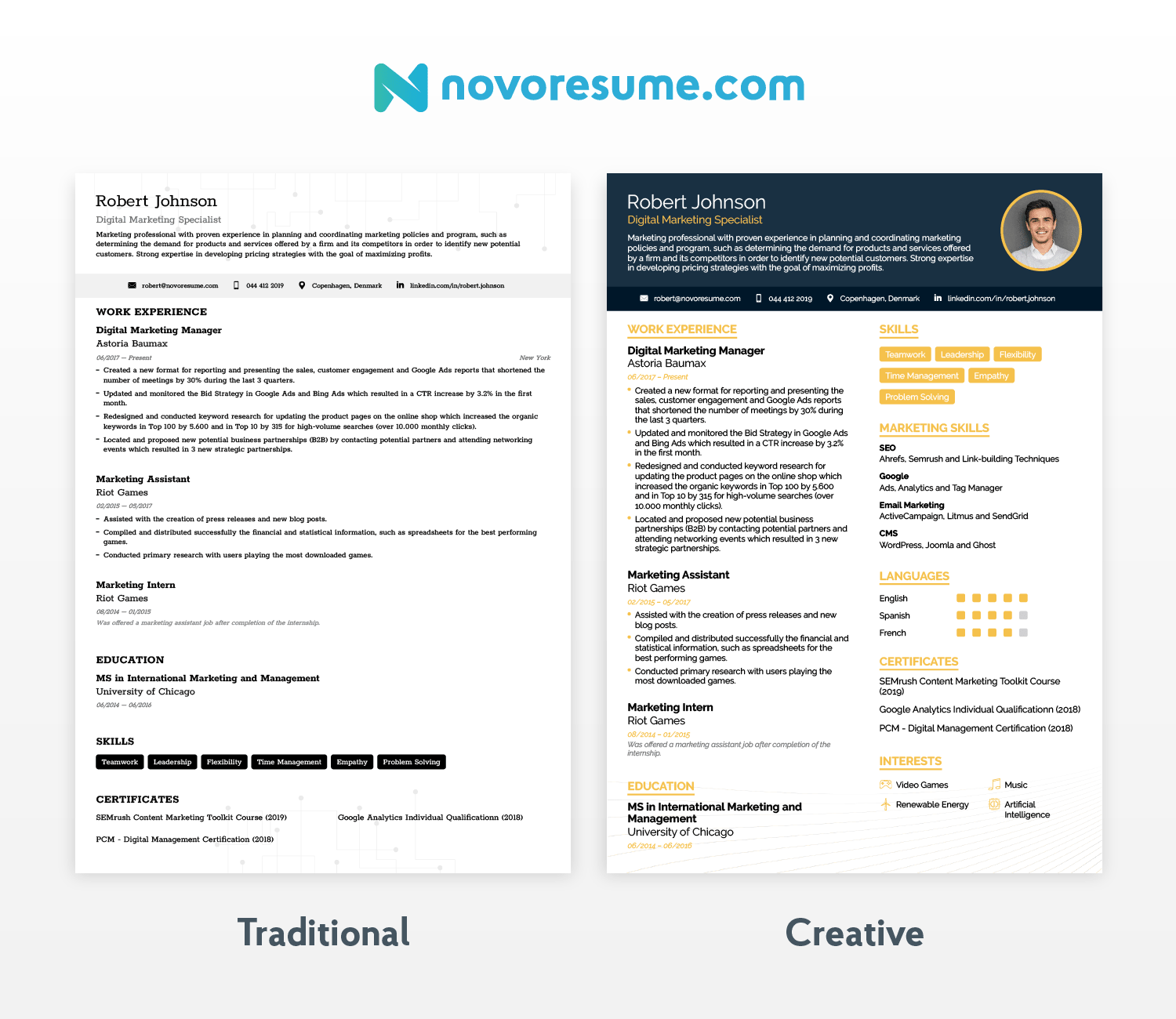
If you’re pursuing a career in a more traditional industry, like law , banking , or finance , you might want to stick to the first.
But if you’re applying to a tech company where imagination and innovation are valued, you can pick a more creative resume template .
Want to Save Time? Use a (Free) Resume Template
Anyone who’s ever tried creating a resume from scratch knows how boring the formatting can be.
Before you can even start filling in the contents, you need to tweak the margins, adjust font sizes, and make sure everything fits into one page while still looking good.
What if you could skip past all that and still create a compelling resume?
Try one of our free resume templates . They’re pre-formatted, so all you have to do is fill in the contents.
They’re also created in collaboration with recruiters from around the globe, ensuring that the templates are visually appealing and ATS-friendly!
See for yourself how one of our templates compares to a resume created in a standard text editor:

#2. Add Your Contact Information
Now that we’ve got all the formatting out of the way, let’s get into what your resume is all about— the information you put on it .
The first thing you want to do when filling out the contents of your resume is to add your contact information .
This section is pretty straightforward but crucial. Your contact details belong at the top of your resume in a designated resume header , so the hiring manager can easily find them.
Even if everything else about your resume is perfect, that all flops if you misspell your email address or have a typo in your phone number. If the hiring manager can’t contact you, it’s a missed opportunity.
So, double-check, and even triple-check your contact information section and make sure everything is factually correct and up-to-date.
Must-Have Information
- Full name. Your first and last name should stand out at the top of your resume.
- Email address. Stick to an address that’s professional and easy to spell, like a combination of your first and last name. (E.g.: [email protected])
- Phone number. Add a reliable number where the hiring manager can easily reach you.
- Location. Add your city and state/country. If you plan to relocate for the job or want a remote position, specify it on your resume.
Optional Information
- Job title. Add your professional title underneath. Write it down word for word, whether it’s “Digital Marketing Specialist” or “Junior Data Scientist.” Just don’t make up job titles like “Marketing Wizzard” or “Data Manipulator.” They’re not quirky; they’re just unprofessional.
- LinkedIn profile . We recommend that you include a link to your updated LinkedIn profile since over 77% of hiring managers use the platform when evaluating a candidate.
- Relevant links. Include links to personal websites or any social media profiles that are relevant to your field. For example, a developer could include a Github profile, while a graphic designer could link their Behance or Driblle account, and so on.
- Date of birth. Unless this is specifically required in the job ad, the hiring manager doesn’t need to know how old you are. It’s not important for their decision-making, and at worst, it might lead to age-based discrimination.
- Unprofessional email address. Your quirky, old high school email address doesn’t belong on your resume. Instead of [email protected] , go for a [email protected] type of address.
- Headshot. (USA, UK or Ireland) Depending on the country where you’re applying, it might even be illegal to include a picture of yourself on your resume . While it’s the norm to include a picture in most of Europe and Asia, always check the regulations for each specific country or industry you’re applying to.
All clear? Good! Now, let’s look at what a great example of a resume's contact information section looks like:
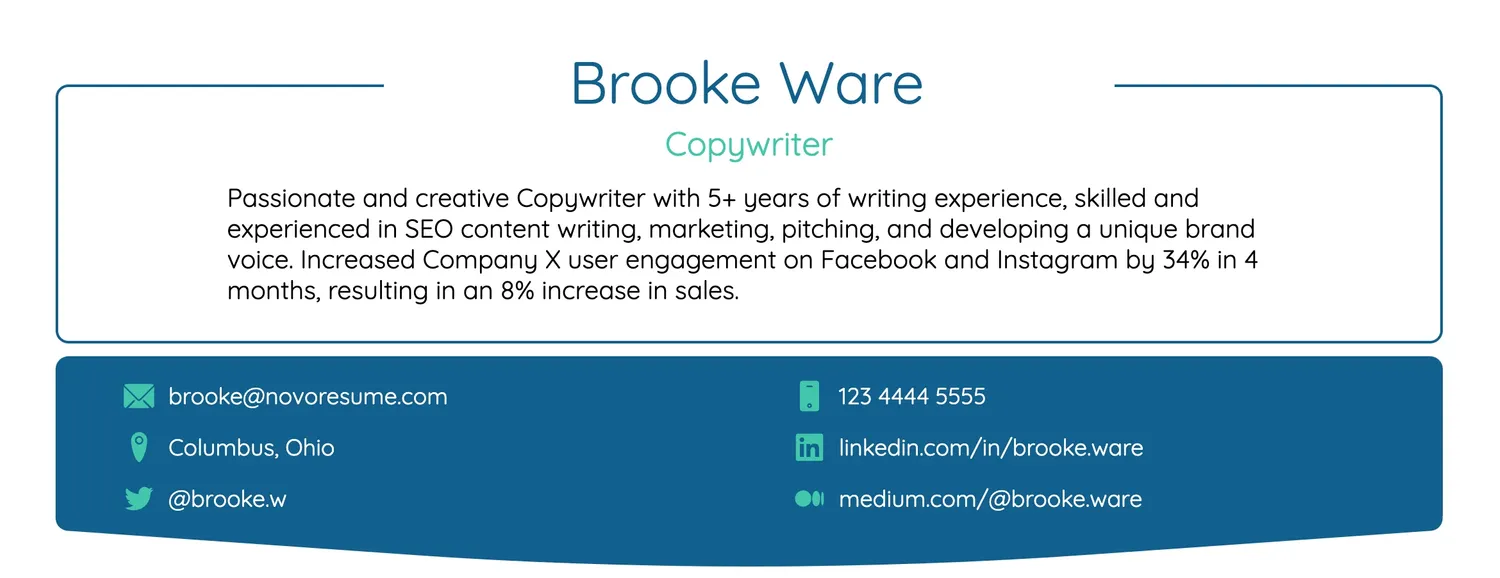
#3. Write a Resume Headline (Summary or Objective)
It's no secret that recruiters spend an average of less than seven seconds on a resume .
When you receive hundreds, if not thousands, of applications daily, it's physically impossible to spend too much time on each.
So, what the hiring managers do to go through resumes more effectively is to skim through each resume and read it in depth only if it piques their interest.
This is where the resume headline comes in.
Placed right next to (or underneath) your contact information, this brief paragraph is the first thing the hiring manager is going to read on your resume.
Now, depending on how far along in your career you are, your resume headline can be either a resume summary or a resume objective.

So, how do you choose between a resume summary and a resume objective? Here’s all you need to know:
Resume Summary
A resume summary, as the name suggests, is a two to three-sentence summary of your career so far. If done right, it shows that you’re a qualified candidate at a glance and gets the hiring manager to give you a chance.
Here’s what your resume summary should include:
- Your job title and years of experience.
- A couple of your greatest professional achievements or core responsibilities.
- Your most relevant skills for the job.
Here’s an example of a well-written resume summary:
Experienced Java Developer with 5 years of experience in building scalable and efficient applications. Contributed to a major project that enhanced application performance by 25%. Strong background in Spring Framework and microservices. Aiming to apply robust coding skills to develop innovative software solutions at XYZ Tech Solutions.
Unless you’re a recent graduate or amid a career change, we recommend you stick to a resume summary. Otherwise, a resume objective might be a better option for you.
Resume Objective
A resume objective is supposed to express your professional goals and aspirations, academic background, and any relevant skills you may have for the job.
It communicates your motivation for getting into a new field, so it’s the go-to headline for recent graduates and those going through a career change. As with a resume summary, a resume objective should be brief—around two to four sentences long.
So, here’s what it would look like if you’re a student:
Hard-working recent graduate with a B.A. in Graphic Design from New York State University seeking new opportunities. 3+ years of practical experience working with Adobe Illustrator and Photoshop, creating illustrations and UX/UI design projects. Looking to grow as a designer and perfect my art at XYZ Design Studio.
Or, on the other hand, if you’re going through a career change, it might look more like this:
IT project manager with 5+ years of experience in software development. Managed a team of developers to create products for several industries, such as FinTech and HR tech. Looking to leverage my experience in managing outsourced products as a Product Owner at Company XYZ.
#4. Prioritize Your Work Experience
The most important part of your resume is your work experience.
This is where you get to sell yourself and show off your previous accomplishments and responsibilities.
If you manage to master this section, you’ll know most of what’s there to know about how to make a resume.
There are plenty of good practices for writing your work experience . But before we dive into all the nits and grits, let's start with the basics.
The standard format for each work experience entry is as follows:
- Job title/position. Your job title goes on top of each work experience entry. When the hiring manager looks at your resume, you want them to know, at a glance, that you have relevant work experience for the job.
- Company name/location/description. Mention the name of the employer and the general location, such as the city and state/country where you worked. In some cases, you may also want to briefly describe the company, like when the organization isn’t particularly well-known.
- Dates employed. Add the approximate timeframe of your employment at each company. You don’t need to give exact dates since the standard format for this is mm/yyyy.
- Achievements and responsibilities. This is the core of each work experience entry. Depending on your field, you want to list either your achievements or responsibilities. List them in bullet points instead of paragraphs, so they’ll be easier to read.
Here’s a real-life example:
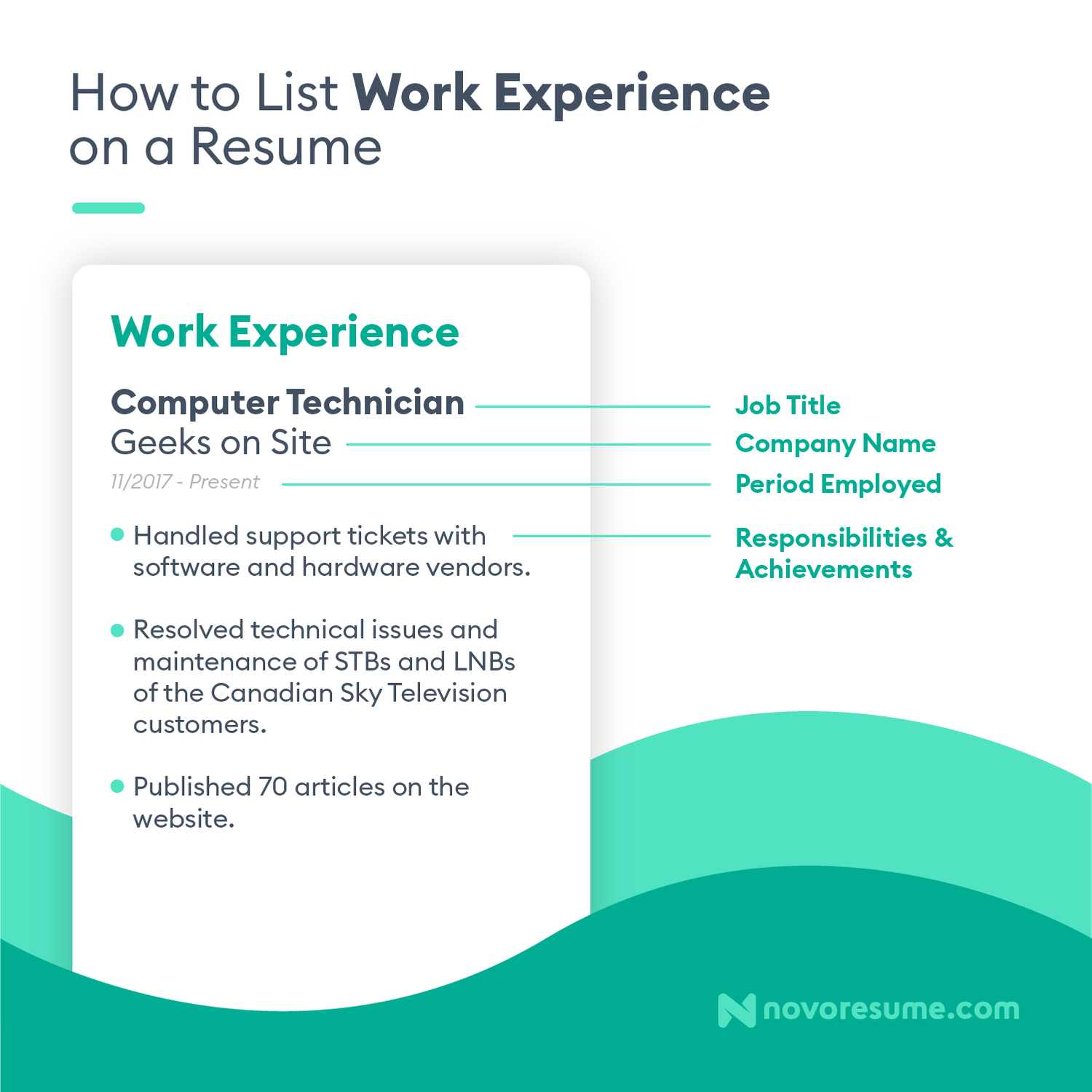
Your work experience entries should always be listed in reverse chronological order , starting with your most recent job and working your way back into the past.
Now that you know how to list your experience, we’re going to show you how to write about it in a way that makes you stand out from the competition, starting with:
Are you a student with no work experience? We’ve got you covered. Check out our guide to writing a resume with no experience here.
Focus on Achievements Whenever Possible
One of the most common resume mistakes is only listing responsibilities in your work experience section.
Here’s the thing—in most cases, the hiring manager knows exactly what your job responsibilities are.
For example, if you’re a sales manager, your responsibilities would be:
- Reach out to potential clients over the phone or email.
- Maintain relationships with existing company clients and upsell relevant products.
- Tracking and reporting on leads in CRM.
Coincidentally, this is also the same list of responsibilities for every sales manager out there. So, 90% of all other resumes probably mention the same thing.
To stand out from the competition, you want to focus on writing achievements in your resume instead. These can be how you helped your previous company grow, reach quarterly quotas, and so on.
Let’s compare how responsibilities hold up next to achievements for the same job:
- Exceeded sales team KPIs by 30%+ for 3 months straight.
- Generated over $24,000 in sales in 1 month.
- Generated leads through cold-calling
- Managed existing company clients
Keep in mind, though, that in some fields, there just aren’t that many achievements you can mention. Let’s say you’re a warehouse worker .
Your day-to-day responsibilities probably include:
- Loading, unloading, and setting up equipment daily.
- Packaging finished products and getting them ready for shipping.
- Assisting in opening and closing the warehouse.
In fields like this, it’s pretty hard to distinguish yourself through achievements, so it’s okay to stick to responsibilities instead. You can still make them shine by following the rest of our advice about listing your work experience.
Keep in mind, though, that in some fields, there aren’t that many achievements you can mention. Let’s say you work in a warehouse. Your day-to-day responsibilities probably involve:
- Loading, unloading and setting up equipment on a daily basis.
- Package finished product and get it ready for shipping.
- Assist in opening and closing the warehouse.
In such fields, it’s pretty hard to distinguish yourself, so it’s totally OK to stick to responsibilities instead.
Tailor Your Resume to the Job
Tailoring is what sets an amazing resume apart from an okay one.
Hiring managers don’t need to know about every single job you’ve ever worked at or every single skill that you have.
They only want to know about your jobs, experiences, or skills that are relevant to the role you’re applying for.
For example, if you’re applying for a job doing Google Ads, you don’t need to talk about your SEO internship from eight years ago.
By focusing your resume on whatever is important for the specific role, you’re a lot more likely to stand out and catch the hiring manager’s attention.
Let’s take a look at an example of a job ad:
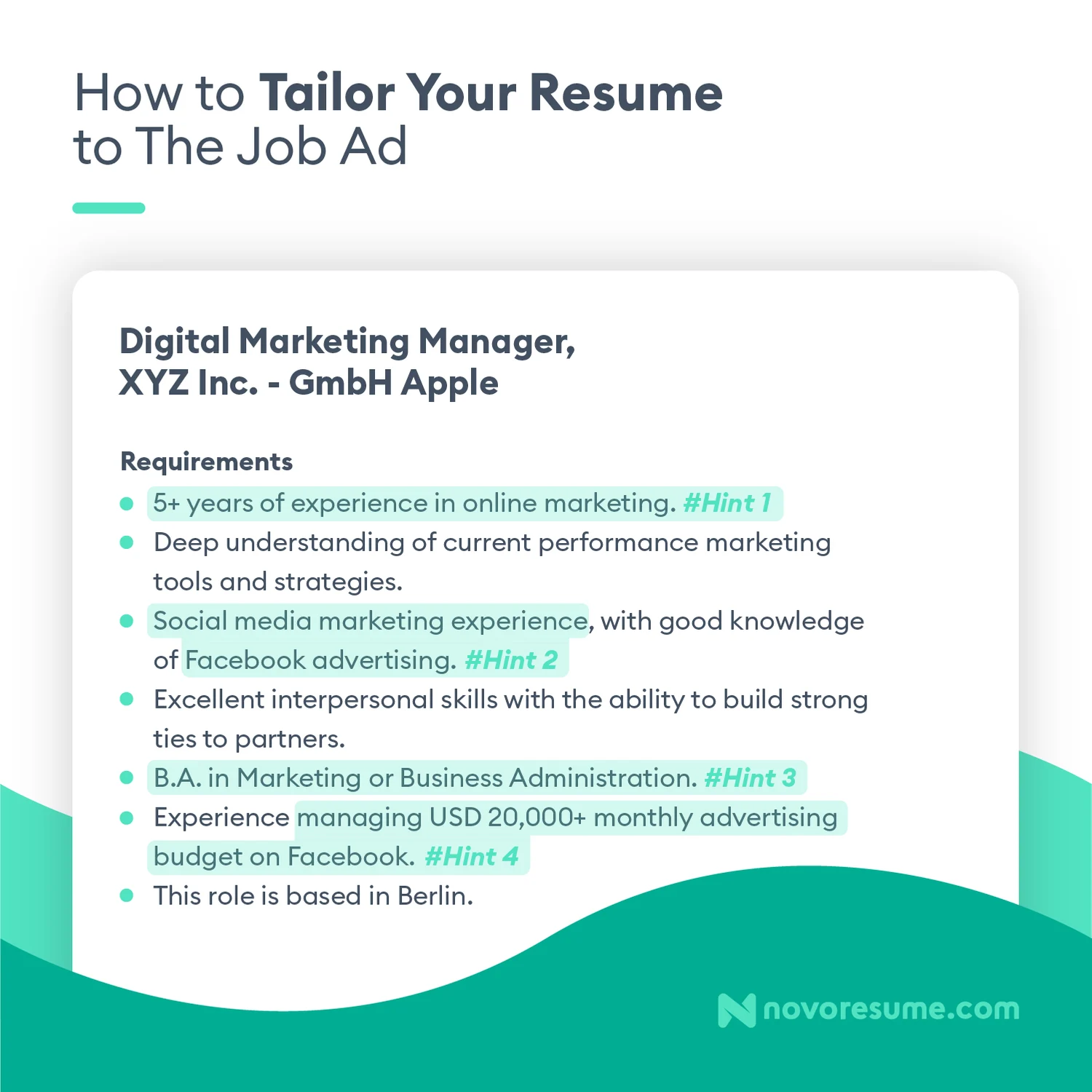
As you can see, we’ve highlighted the most important requirements.
To tailor your resume accordingly, you just need to mention how you meet each of these requirements in your resume.
You can highlight your relevant achievements and qualifications in different parts of your resume, such as:
- In your resume summary, where you should recap your years of experience.
- Throughout your work experience section, where you should list achievements and responsibilities that reflect your social media marketing experience.
- In your education section, where you can let the hiring manager know you have the degree that they’re looking for.
Include the Right Amount of Work Experience
If you’ve got over a decade’s worth of work experience, you’re probably wondering whether all of it belongs on your resume. In most cases, you’d end up writing a novel if you listed everything you’ve ever done, and that’s not how long a resume should be .
If you’re new to the job market, on the other hand, you probably don’t have any experience, and you’re wondering what you could even add to this section.
So, here’s how much information your resume should include, depending on your level of experience:
- No experience. If you’re looking for your first job , you won’t have any work experience to fill this section with. So, you can either keep it empty and focus on all the other sections or fill it up with any experience gained in student organizations, extracurricular activities, volunteering, and other projects.
- Entry-level. List all your work experience so far. While some of it won’t be relevant, it can still show the hiring manager that you do have some actual work experience.
- Mid-level. Only mention relevant work experience to the position you’re applying for. There’s no need to waste space on jobs that aren’t related to what you’re after.
- Senior-level. List up to 15 years of relevant work experience, tops. If your most recent experience is as a marketing executive , the hiring manager doesn’t care how you started your career as a junior marketing specialist 23 years ago.
Consider Applicant Tracking System (ATS) Software
Did you know that over 70% of resumes don’t even make it to the hiring manager ?
Most companies these days use ATS to evaluate hundreds of resumes instantaneously and automatically filter out the ones that don’t meet their criteria.
For example, if a resume doesn’t mention a specific skill or isn’t formatted correctly, the ATS will automatically reject it.
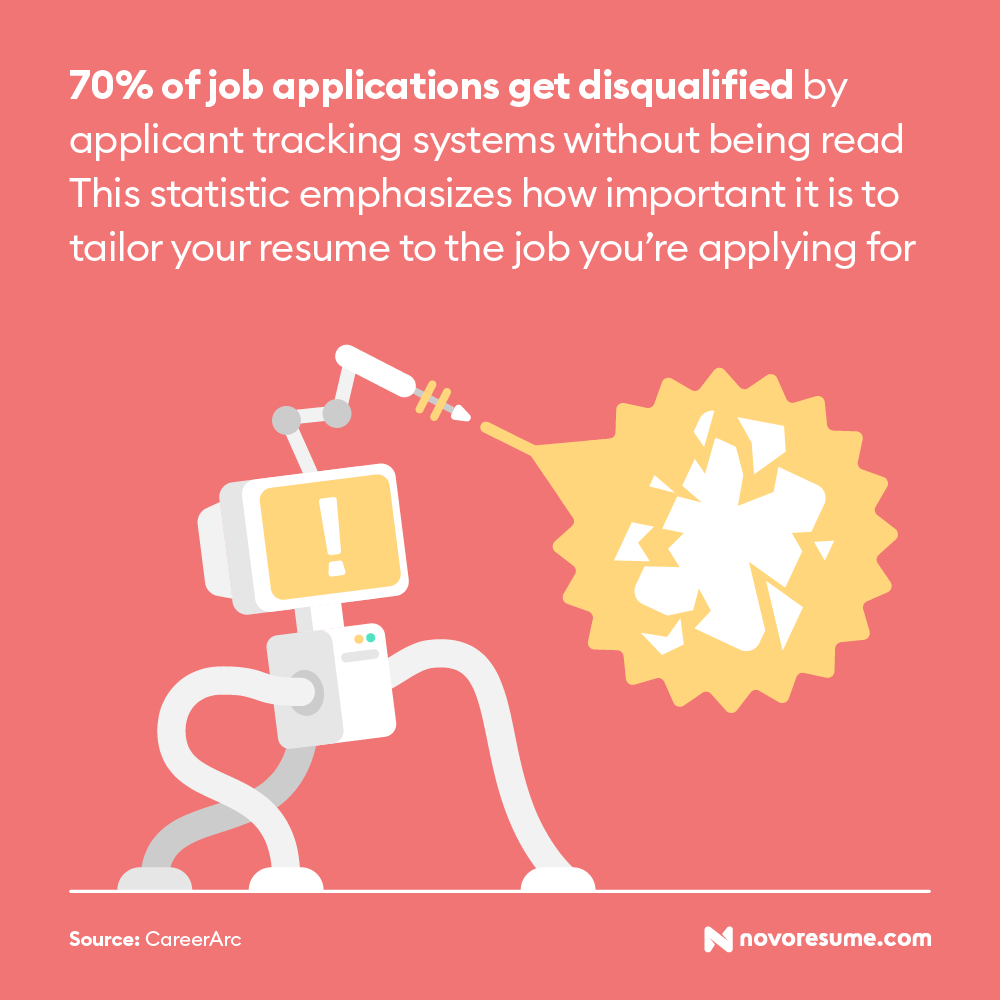
Fortunately, there are some easy ways to make an ATS-friendly resume .
Here are a couple of tips to help you get past those pesky robots:
- Stick to one page. Sometimes employers set a limit on how long a resume should be. This means that if your resume is longer than one page, it might get automatically disqualified.
- Incorporate keywords. Tailoring your resume to the job helps a ton with beating the ATS. Just carefully read the job description to find hints for what the ATS will be looking for. Then, whenever you find keywords related to your responsibilities and achievements, make sure to include them in your work experience section.
- Use an active voice. Passive voice is too vague and unclear, so make sure to use active voice as much as possible when describing your previous jobs. (E.g.: “Managed a team of ten people,” instead of “ A team of ten people was managed by me.” )
- Leverage powerful action words. Instead of starting each of your sentences with “was responsible for," make your work experience impactful by using words that can grab attention. Saying that you “spearheaded” or “facilitated” something sounds a lot more impressive than “helped.”
Want to make sure your resume formatting passes the ATS test? Choose one of our tried and tested ATS-friendly resume templates , and you’ll be good to go!
#5. List Your Education
The next section on your resume is dedicated to your academic qualifications. Let’s start with the basics!
Here’s how you should format the education section on your resume :
- Program Name. Your major and degree type should be listed. (E.g.: “B.A. in Business Administration” )
- University Name. Add the name of the institution. (E.g.: “New York State University” )
- Dates Attended. Use a mm/yyyy format for the dates you attended. (E.g.: “08/2008 - 06/2012” )
- Location. If your university is less well-known, you can also add the location. (E.g.: “Stockholm, Sweden” )
- GPA. Use the appropriate grading system for the country you’re applying to work in. (E.g.: In the USA, it would be “3.9 GPA” )
- Honors. Add any honors and distinctions you’ve been given. (E.g.: Cum Laude, Magna Cum Laude, Summa Cum Laude )
- Achievements. You can mention interesting papers you’ve written, projects you’ve done, or relevant coursework you’ve excelled in.
- Minor. “Minor in Psychology”
Pretty simple, right? Now let’s see what an education section looks like in practice:
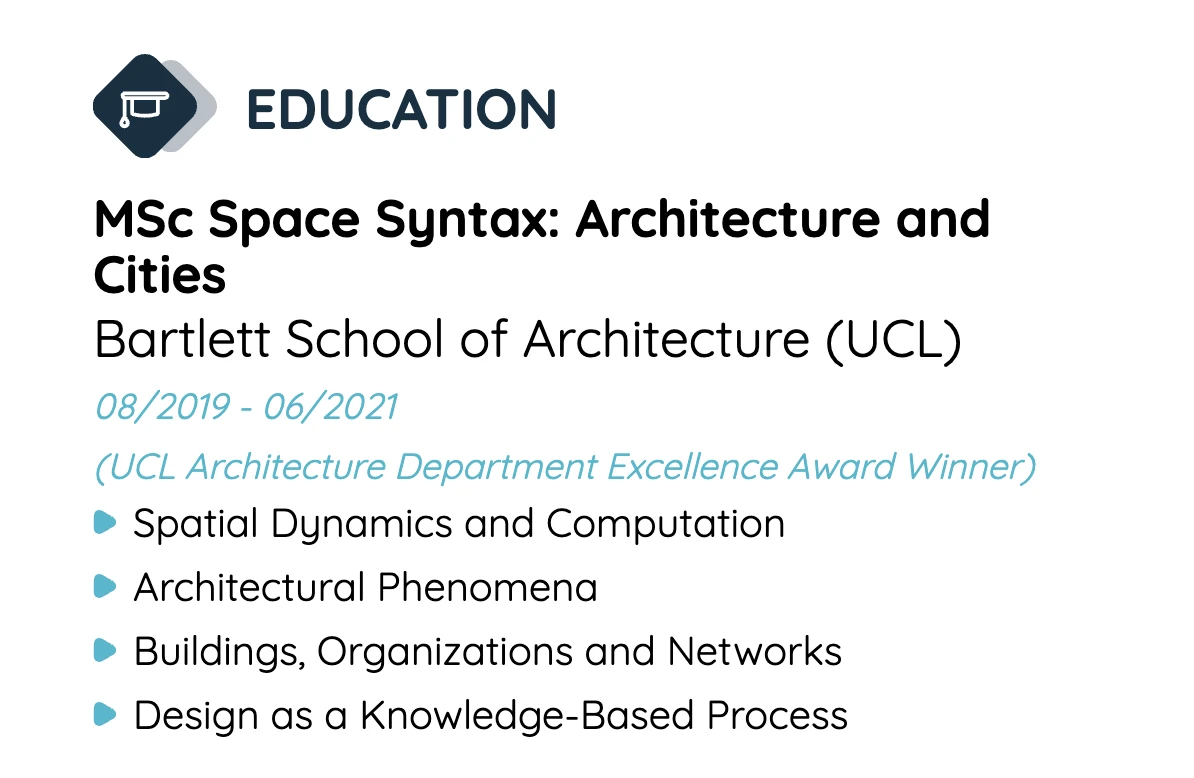
This example includes all the necessary information, plus an eye-catching award and relevant classes this candidate has taken.
Resume Education Tips
Now that you know how to list your education on your resume, let’s take this section to the next level.
Just follow these expert tips:
- If you’re making a resume as a student and don’t have any work experience yet, you can list your education section at the beginning of the page instead of work experience.
- You can add your expected graduation date if you’re still pursuing your degree.
- If you already have relevant work experience, just keep this section short and sweet. Recent graduates can expand on their education more and add optional information like projects, classes, academic achievements, etc.
- Always list your degrees in reverse chronological order, starting with your highest degree on top. Your highest and most recent degree is usually enough, so if you have a Master’s degree that’s relevant to the job, there’s no need to mention your earlier degrees.
- Don’t add your high school degree to your resume if you already have a university degree. It doesn’t have as much weight, and you can use the space for something else.
- Only mention your GPA if you had an impressive academic career. Anything below a 3.5 GPA doesn’t need to be on your resume.
Are you in the process of applying for college? Check out our guide to writing a college application resume to wow that admissions officer!
#6. Emphasize Your Know-How in the Skills Section
After your work experience, your skills are the first thing the hiring manager is going to look for. In fact, together, work experience and skills make up 90% of the hiring decision .
So, this is the place where you want to mention all the know-how that makes you the perfect candidate for the job.
There are two types of skills you can include when writing your resume:
- Hard Skills. These are measurable abilities. What you can list here can be anything from coding in Python to knowing how to cook Thai cuisine.
- Soft Skills. Also known as personal skills, these are a mix of communication skills , personal traits, career attributes, and more. They can include leadership, critical thinking, and time management , just to name a few.
Your resume should always cover both hard skills and soft skills . Here’s an example in action:
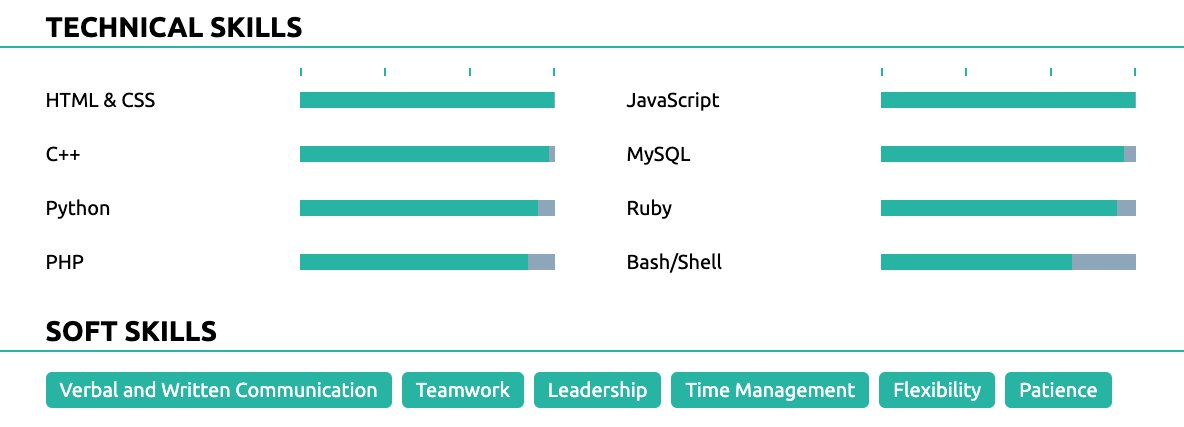
Now, let’s discuss how you should list your most important skills on your resume.
There are a few essential steps you need to follow:
Always List Hard and Soft Skills Separately
Your resume should be easy and neat to navigate. The hiring manager shouldn’t have to waste time looking for a specific skill because you didn’t separate it into the appropriate subsection.
So, just create separate categories for your hard and soft skills.
Depending on your field, you could customize the name of your “hard skills” subsection to something like “technical skills," “marketing skills," or something else related to your field.
Let’s look at an example of what skills look like on a project manager’s resume :
Methodologies & Tools
- Agile Methodology
- SCRUM Framework
- Waterfall Project Management
- Microsoft Project
- Critical Path Method (CPM)
- Earned Value Management (EVM)
- Risk Management
Soft Skills
- Team Management
- Conflict Resolution
- Negotiation
Tailor Your Skills to the Job
You might have some awesome skills, but the hiring manager only needs to know about the ones that are relevant to the job.
For example, if you’re applying for a job as an accountant, your gourmet chef skills shouldn’t be on your resume.
Look at the job ad and list at least two to three essential skills you have that are required for the role. Remember—there’s no need to list every skill you have here; just keep it relevant.
Qualifications:
- Bachelor’s degree or higher in Graphic Design or a related field.
- Tech-savvy, with some background in CMS systems such as WordPress.
- Thrives in a stressful environment and juggles multiple tasks and deadlines.
- Strong organizational and time management skills.
- Excellent communication skills.
- Self-reliant, with the ability to manage their own work.
- A can-do attitude and an outside-the-box thinker.
- Proficient in Adobe Photoshop, InDesign, Illustrator, Keynote, and Pages.
- Basic understanding of Office software such as Microsoft Word, Excel, PowerPoint, and Outlook.
So, the must-have hard skills here are Photoshop, InDesign, Illustrator, Keynote, and Pages. Other good computer skills to have are WordPress or similar CMS systems.
While you can also mention Word, Excel, PowerPoint, and Outlook, it’s pretty much assumed that you know how to use them since they’re required for most office jobs.
List Hard Skills with Experience Levels
For each hard skill you list on your resume, you should also mention your proficiency level. This tells employers what they can expect from you and how much training you might need.
- Beginner. You have some experience with the skill, whether it’s from some entry-level practice or classroom education.
- Intermediate. You’ve used the skill in a work environment with good understanding.
- Advanced. You’re the go-to person for this skill in your office. You can coach other employees, and you understand the skill at a high level.
- Expert. You’ve applied this skill to more than a handful of different projects and organizations. You’re the go-to person for advice about the skill, not just in your office but even amongst some of the best professionals in your field.
Just make sure to never lie about your actual skill level. Even if you get the job, once you need those skills you exaggerated, it will be pretty awkward for both you and your employer.
Include Transferable Skills
These are the types of skills that are useful for almost any job out there.
Transferable skills can be both soft skills (e.g.: teamwork, creativity, problem-solving skills, and others) and hard skills (MS Office Suite, HTML, writing, etc.)
Whatever job you’re applying to, chances are you have transferable skills from your experience that can come in handy one way or another. So, feel free to include them, even if they’re not specifically required for the position.
Not sure which skills to mention on your resume for your specific field? Check out our list of 101+ essential skills for inspiration!
#7. Leverage Optional Resume Sections
The sections we’ve covered so far are must-haves for any resume. They’re the bread-and-butter for any job application, and if you get them right, you’ll land any job you apply to.
But if you have some leftover space, there are a few optional sections you can choose from to give your resume a boost!
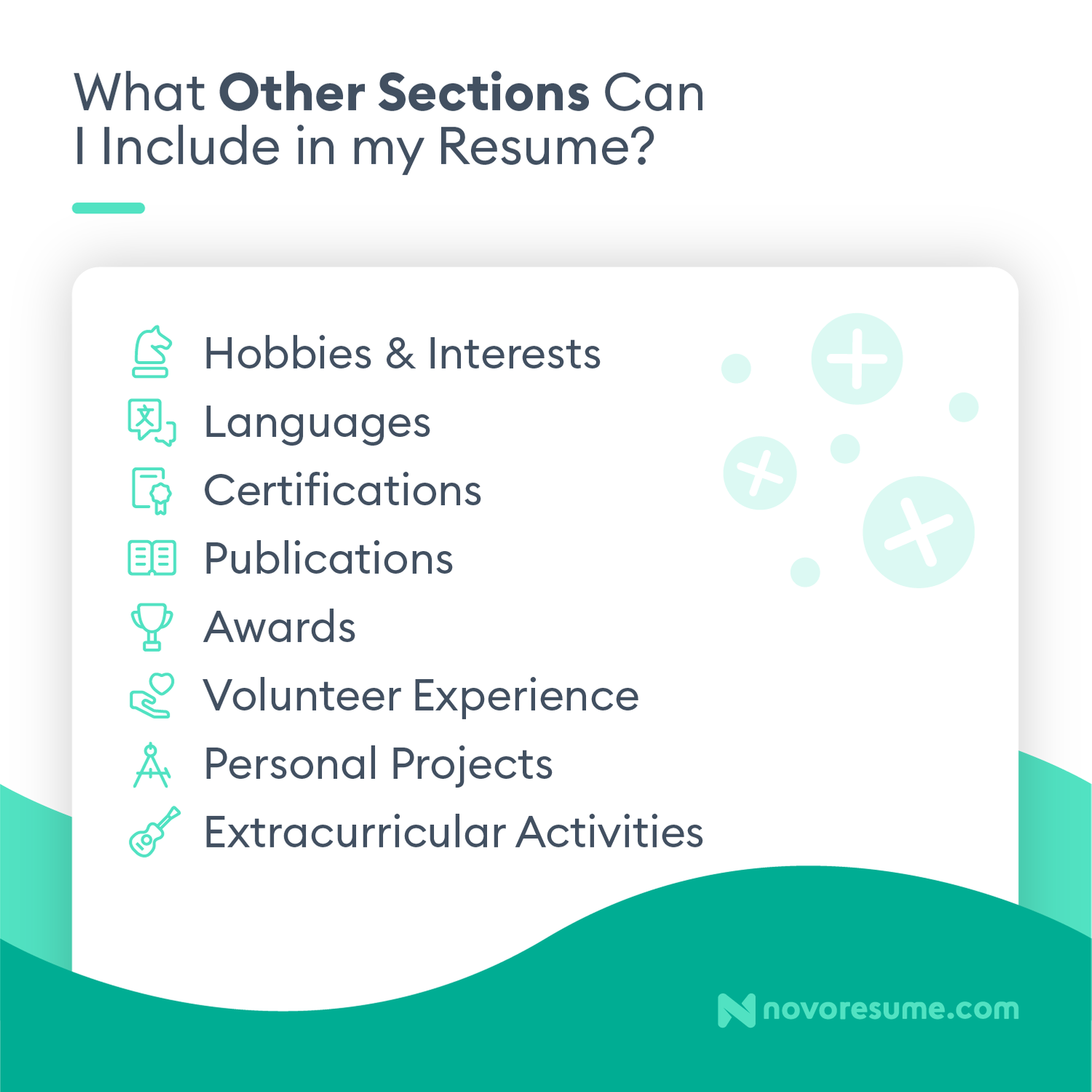
Are you bi-lingual? Or even better – multi-lingual? You should always mention that on your resume!
Even if the position doesn’t require you to know a specific language, it can still come in handy at some point. At the end of the day, it’s always better to know more languages than less.
To list languages in your resume , just write them down and assign them the appropriate level:
- Intermediate
You can also use the Common European Framework of Reference for Languages (CEFRL) or the American Council on the Teaching of Foreign Languages (ACTFL) proficiency scales.
As a given, you should never lie about your language skills. You never know—your interviewer might turn out to be fluent in the language or even be a native speaker!
Hobbies and Interests
If you want to spice up your resume, hobbies and interests could be just what you need.
While this section isn’t a game-changer, it can help the hiring manager see who you are as an individual.
For example, if you listed “teamwork” as one of your skills, hobbies like team sports can back up your claim.
And who knows? Maybe you and your interviewer have some hobbies or interests in common!
Volunteering Experience
If you’re the type of person who devotes their free time to helping others while expecting nothing in return, chances are that you’re the type of employee who’s in it for more than just the money.
Seeing volunteer experience on your resume tells hiring managers that you’re a loyal employee who’s after something meaningful.
Several studies show that listing your volunteer experience can boost your chances of getting hired, especially if you have little to no work experience.
Certifications
Hiring managers love candidates who invest in themselves, and that’s exactly what they see when you list certifications on your resume .
If you value continuous learning and strive to expand your skill set, that’s always a plus.
Certifications can also show employers how much expertise you have.
For example, if you’re a Microsoft Cloud Engineer and you specialize in Microsoft Technologies, you should definitely include all essential certifications on your resume, such as the Azure Solutions Architect Expert one.
Awards and Recognitions
There’s no harm in showing off a little on your resume. After all, you want to be a candidate that shines above the rest.
So, if you’ve received any awards or recognitions that make you stand out in your field, make sure to add them.
For example, if you’ve been recognized for your contributions to data science or received a hard-to-come-by scholarship , mention it in your resume. Just keep your entries here relevant to the field you’re applying to.
Publications
Whether you’re a freelance writer or a distinguished academic, publications are always impressive.
If you have any published works (online or in an academic journal), you can add them to your resume. Just make sure to include a link so the hiring manager knows where to check your work!
Are you looking for a career in academia? Check out our guide to writing the perfect academic CV to get started!
Working on side projects can show off your passion for your field. Whether they’re university class projects or part-time entrepreneurial endeavors, they’re relevant.
For example, if you worked on a mock software product as part of a university competition, it shows you went through every step of product creation, from ideation to creating a marketing strategy.
This project also shows off your organizational skills , and if you mention it in your resume, you stand a better chance of landing the job you had your sights set on.
But projects can also be personal, not academic. For example, you might manage an Etsy store where you sell hand-made arts and crafts to customers online. This is a great opportunity to highlight your creativity, management, and customer service skills .
Overall, hiring managers love employees who do cool work in their free time, so projects are always a great section to add to your resume.
Looking to kickstart your career? Check out our guide on how to get an internship for useful tips and real-life examples!
Extracurricular Activities
Every college freshman knows that extracurricular experience can make a difference in their application.
Especially if you don’t have a lot of experience outside of school, extracurricular activities are a great way to show potential employers your skills and give them insight into you as a person. Different clubs and after-school projects can help you gain real-life skills and considerably increase your chances of landing your first job after college.
For example, joining a student government organization can hone your leadership skills and teach you how to work as part of a team.
For example, if you’re part of a student government or public speaking club, these activities can help you hone your leadership and presentation skills.
11+ Expert Resume Tips
You’ve got the gist of how to make a resume. Now, it’s time to make it really stand out from the crowd!
Follow these exclusive resume tips to take your resume game to the next level:
- Match the professional title underneath your name to the job title of the position you’re applying for. Hiring managers often hire for several roles at once, so giving them this cue about what role you’re after helps things go smoother.
- Mention any promotions from your previous jobs. Use the work experience entries for them to focus on the achievements that helped you earn them.
- Describe your achievements using Laszlo Bock’s formula : accomplished X as measured by Y by doing Z . This way, your work experience can go the extra mile and show the hiring manager what you can bring to the table.
- Always list your achievements and responsibilities in concise bullet points. This makes your resume more reader-friendly, and it’s more likely that the hiring manager will see your impressive achievements at a glance.
- Don’t use personal pronouns like “I” or “me,” and don’t refer to yourself by name. Stick to a slightly altered third person, like “managed data integrity at XYZ Inc.” instead of “he managed data integrity at XYZ Inc.”
- Name your resume sections correctly, or it might get rejected by the ATS. Swapping out quirky names like “career history” or “expertise” for “work experience” and "skills" makes it easier for the hiring manager to find what they’re looking for, too.
- Prioritize important keywords instead of adding all of them. Make sure the relevant skills, qualifications, and experiences you add all make sense in context, too. Your goal is to get past the ATS and impress the hiring manager.
- Focus on transferable skills if you don’t have a lot of relevant work experience. Any extracurricular activities or personal projects can help you stand out here.
- Add a strategic pop of color to headings, bullet points, or key elements you want to highlight. It can help your resume stand out, but don’t overdo it—you want the information to be more impressive than the color palette.
- Don’t include the line “references available upon request.” Hiring managers already know they can request a list of references from you, so there’s no need to waste valuable space on it.
- Make sure your resume is optimized for mobile viewing. Most hiring managers use their mobile phones as often as desktop computers, so save your resume to a PDF file and make sure your formatting stays intact across any device.
- Rename the resume file you plan to send so it includes your name and the name of the position you’re applying for. It’s a small detail that can turn into a crucial mistake if you forget it.
- Read your resume out loud when you’re done. This is a great way to catch awkward phrases or spelling mistakes you might have missed otherwise.
- Use a tool like DocSend to track your resume. You’ll get a notification any time someone opens your resume, and you can see how long they spend reading it.
FREE Resume Checklist
Are you already done with your resume? Let’s see how it holds up!
Go through our checklist for perfecting your resume and see where you stand!
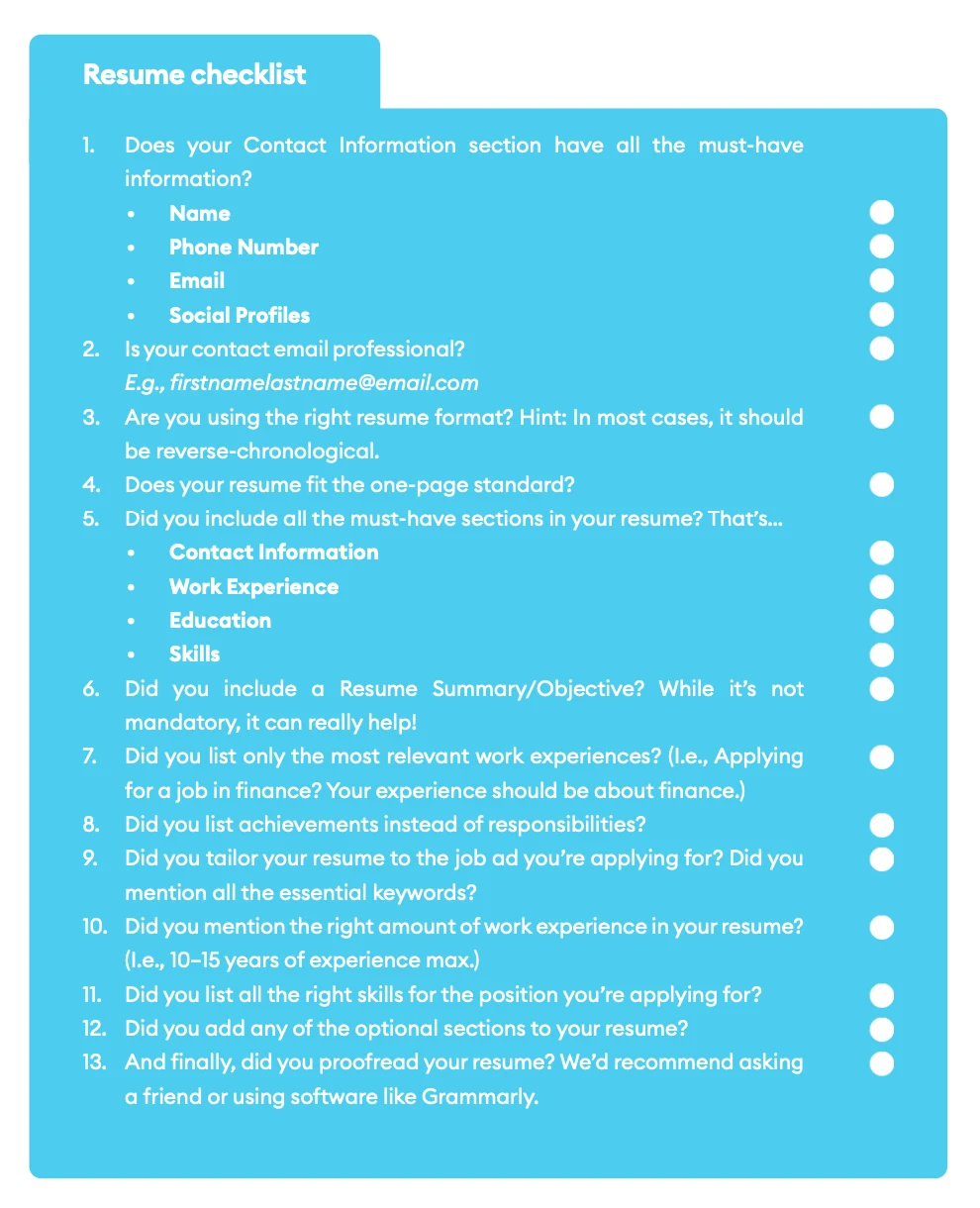
If you missed some points, just go through your resume one more time and perfect it.
And if you ☑’d everything—congrats! You’ve learned all there is to know about writing a resume, and you’re good to go with your job search.
Need to write a CV instead of a resume? Check out our step-by-step guide on how to write a CV with dozens of examples!
9 Resume Templates for Different Industries
Looking to create an effective resume without dealing with the formatting hassle? Just choose one of the templates below.
#1. Traditional Resume Template
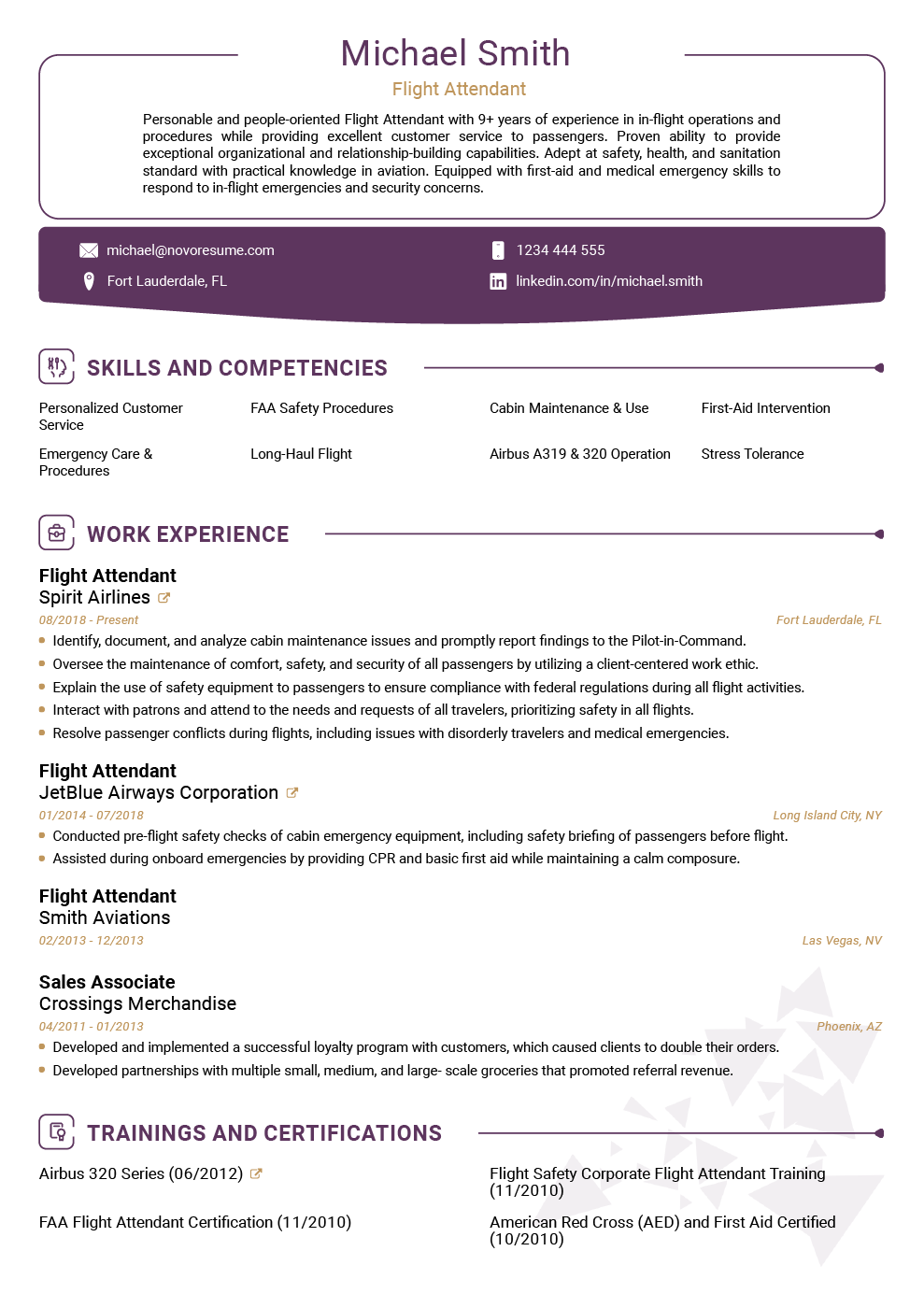
Good for traditional industries like finance, banking, law, and manufacturing.
#2. Modern Resume Template
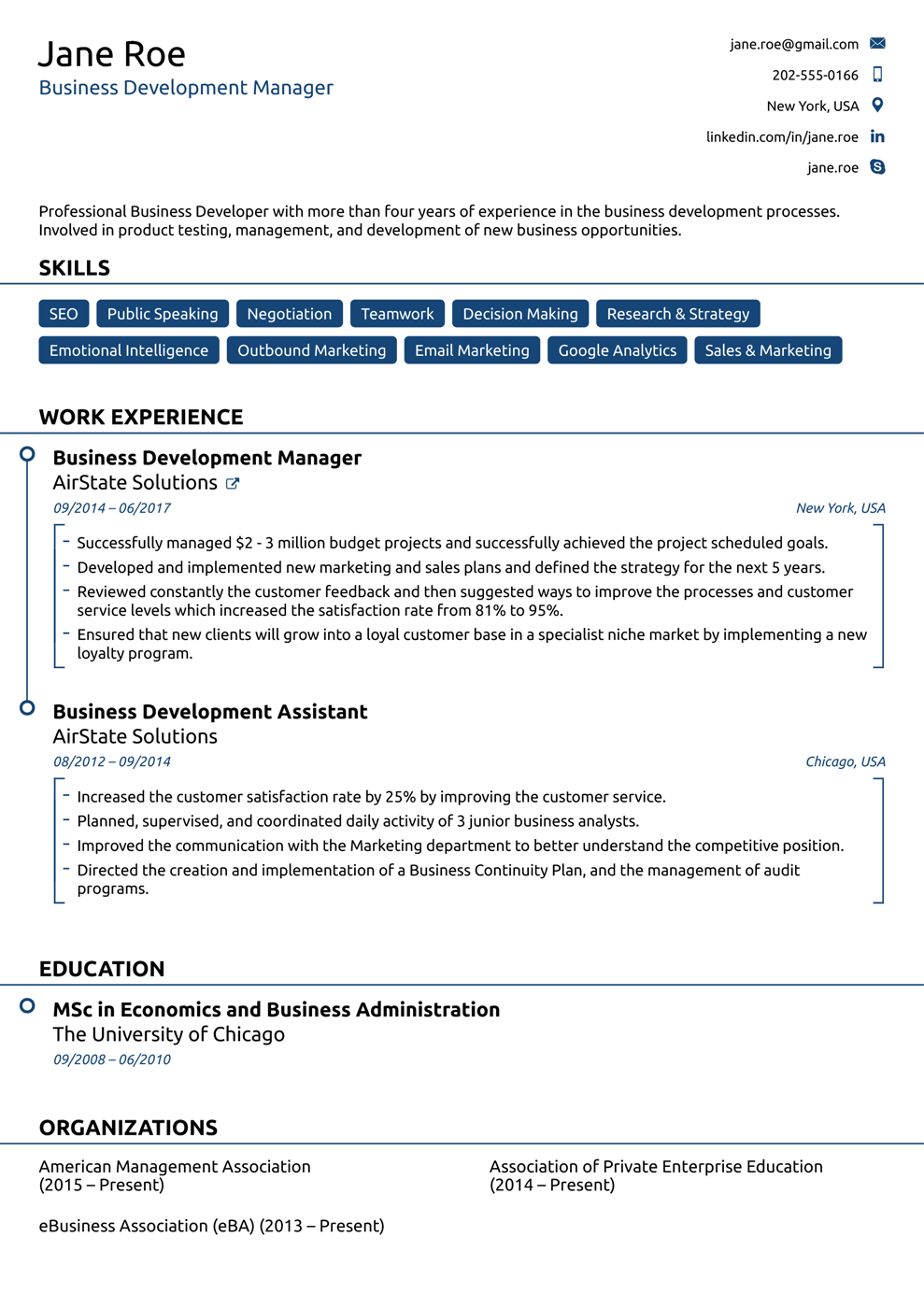
Good for both contemporary and forward-looking industries, including entrepreneurship, medical technology, and engineering.
#3. Creative Resume Template
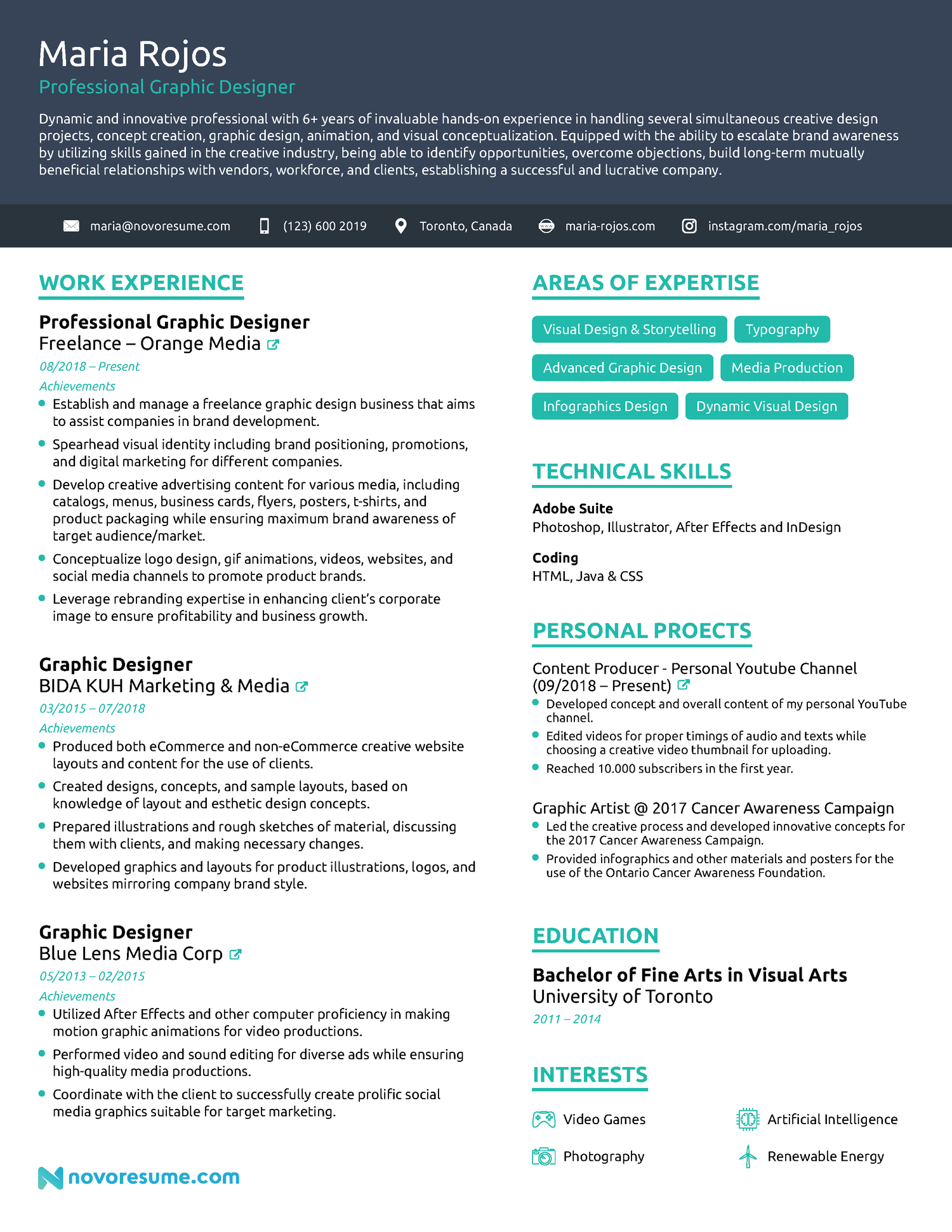
Good for creative industries, including entertainment, design, and architecture.
#4. Minimalistic Resume Template
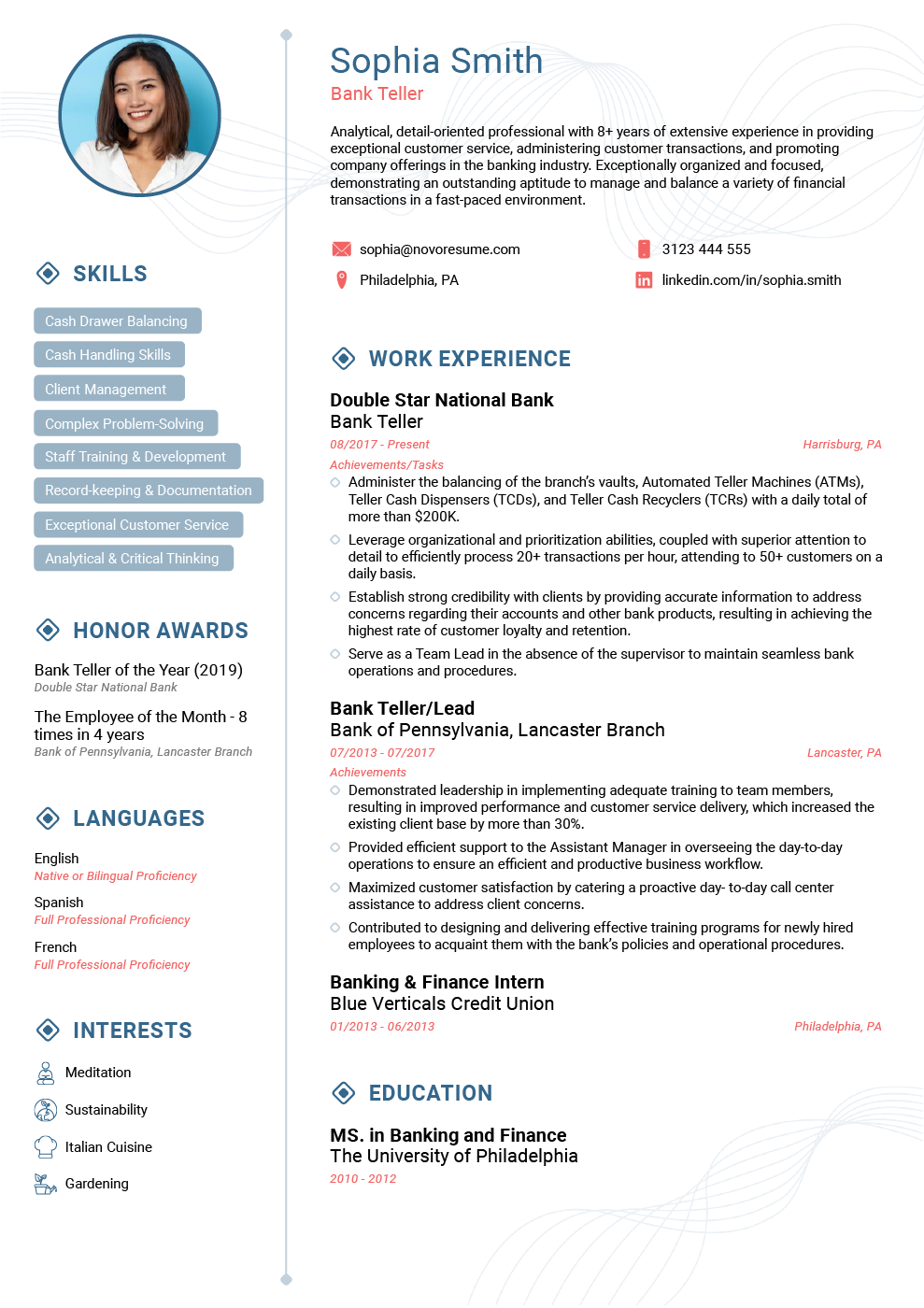
Good for experienced professionals in basically any industry who want to let their achievements do the talking.
#5. IT Resume Template
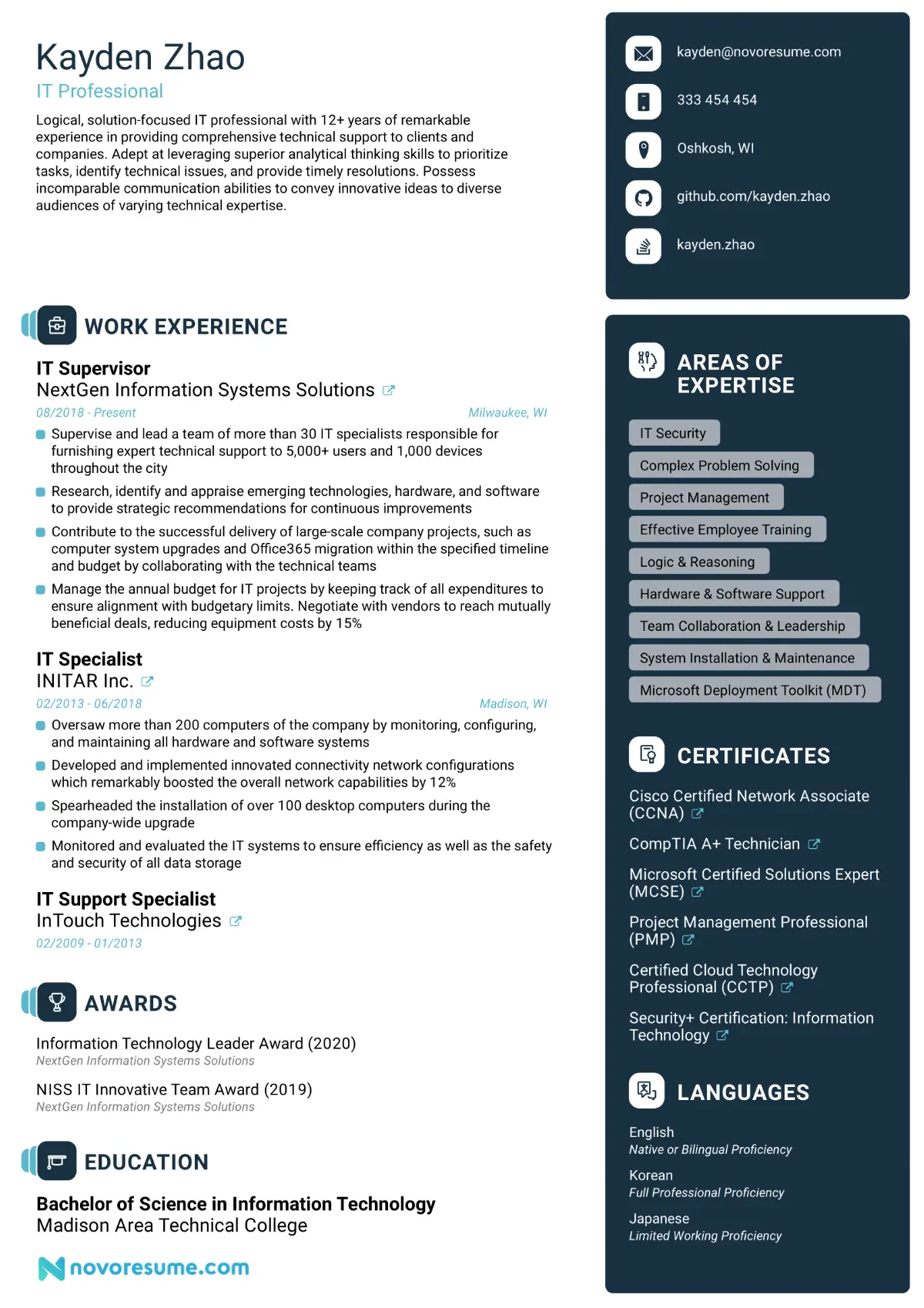
Good for any IT-related profession like software development, cyber security, and DevOps engineering.
#6. Tech Resume Template
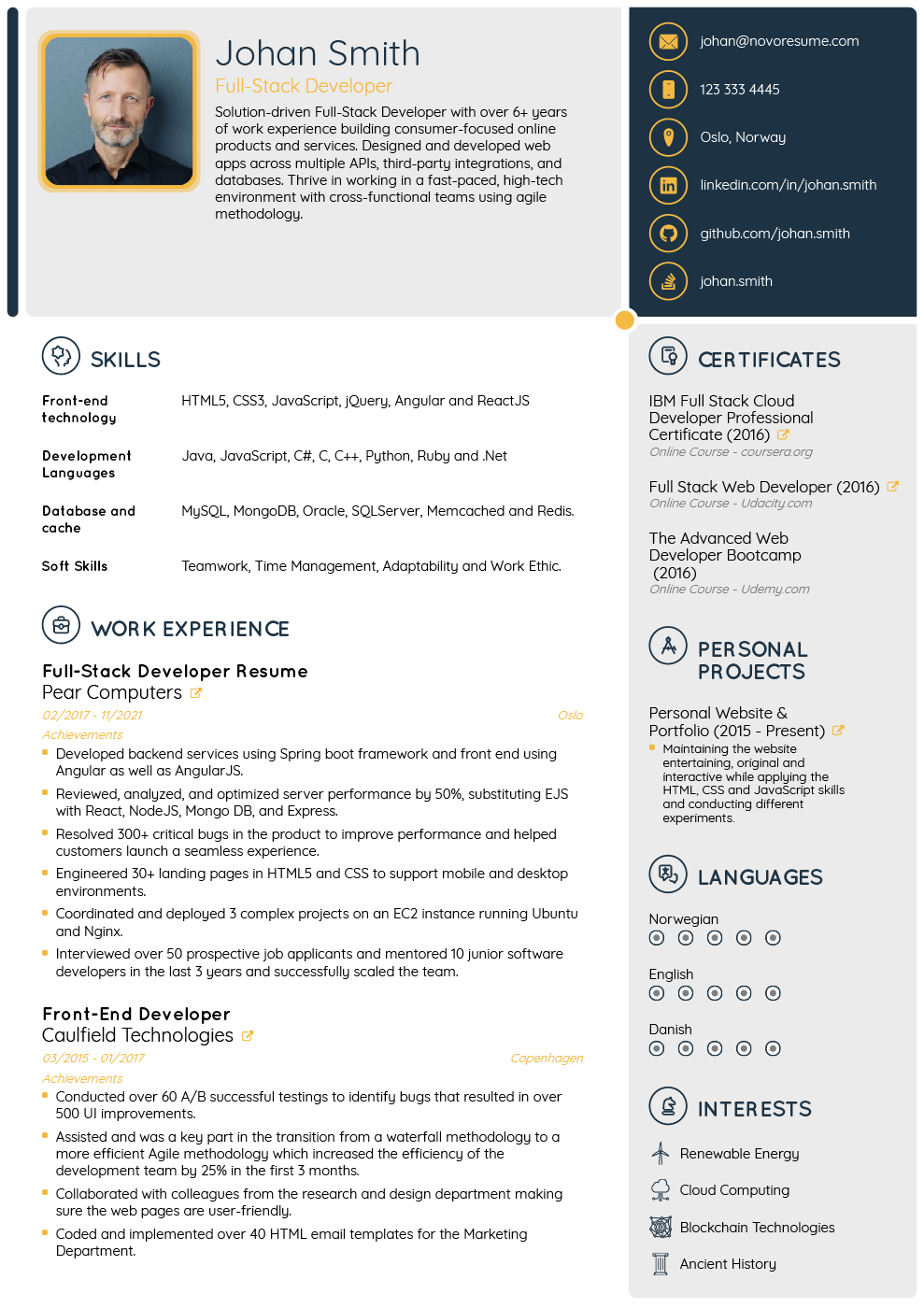
Good for the tech industry and everything it encompasses.
#7. College Resume Template
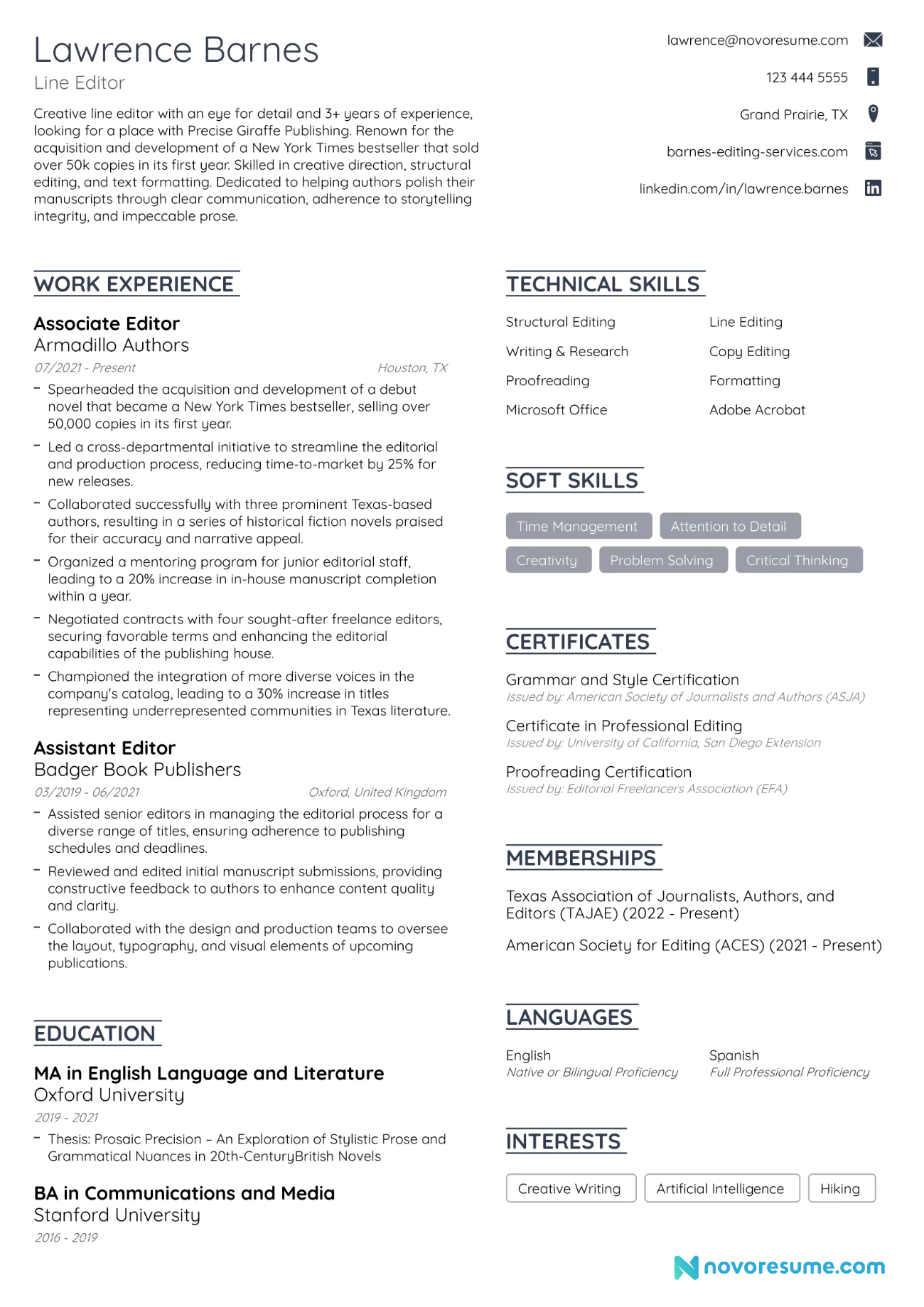
Good for college students and recent graduates alike.
#8. General Resume Template
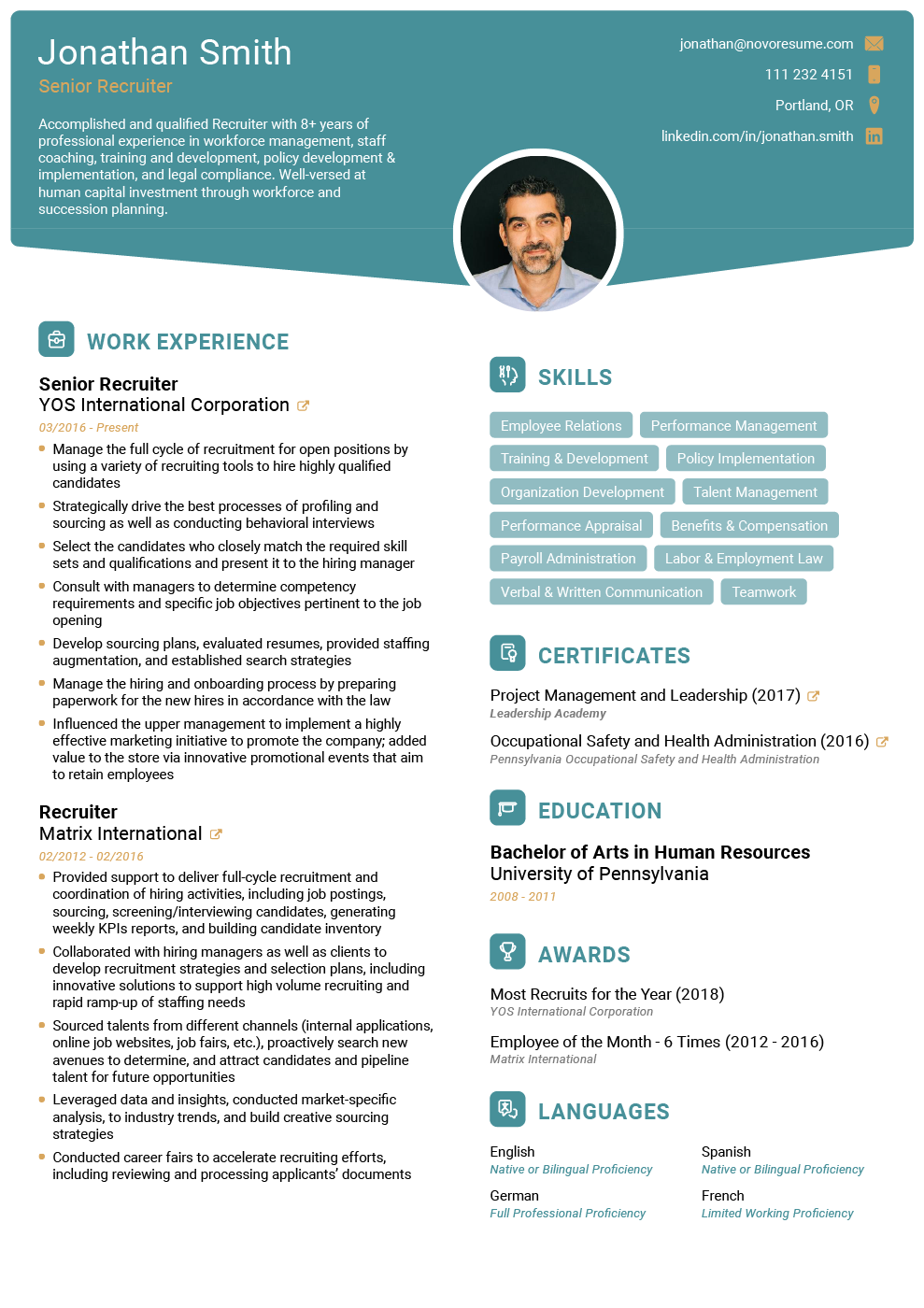
Good for multiple industries, including HR, education, and customer service.
#9. Executive Resume Template
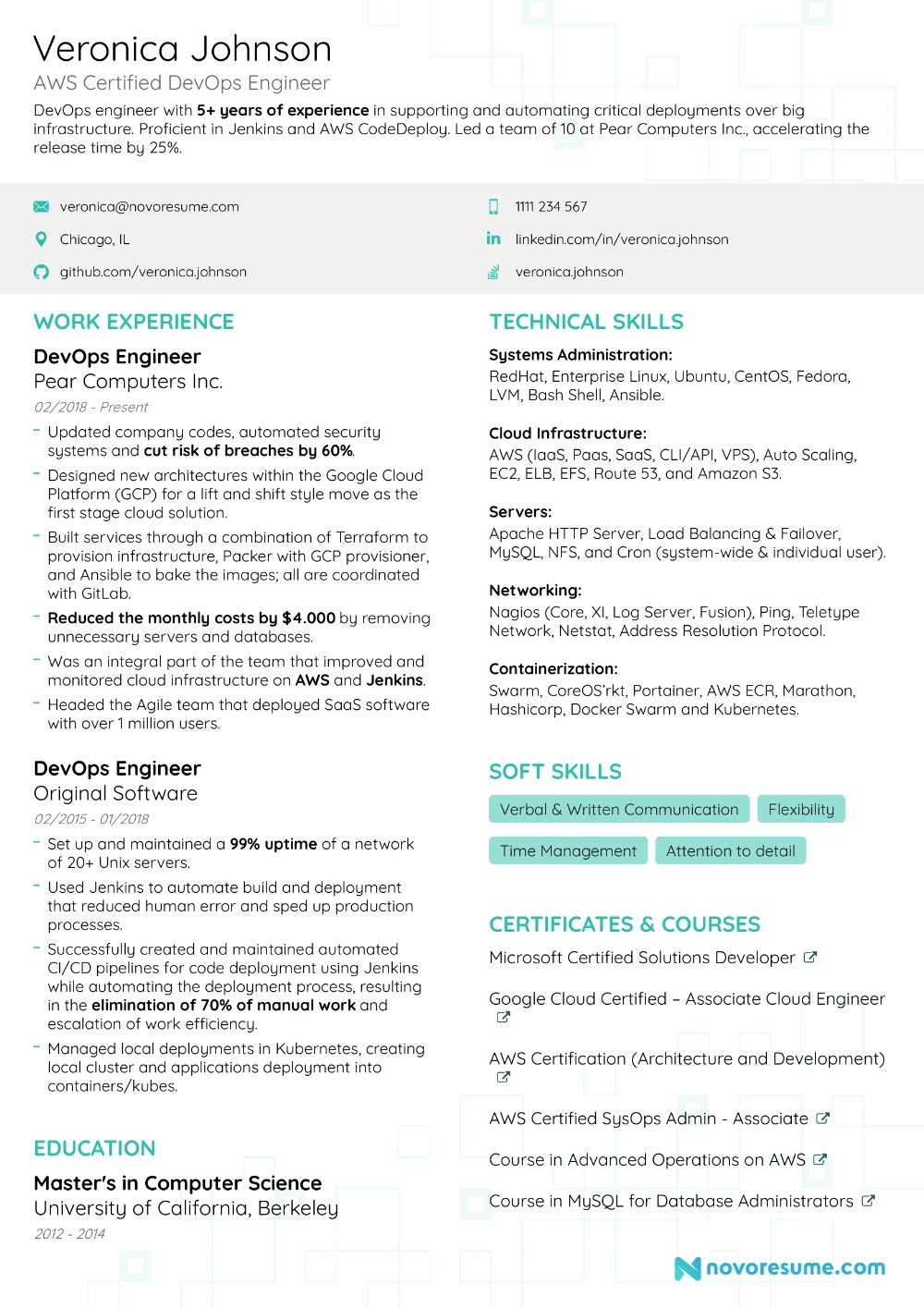
Good for senior professionals across different industries, including hospitality, marketing, and logistics.
17+ Resumes for Different Jobs
Knowing how to write a resume is one thing, but making a resume that stands out is something entirely different. Without inspiration, even top career experts might stumble on a roadblock or two.
Check out the following effective resume examples for specific jobs to get a better sense of what a good resume looks like:
#1. Nurse Practitioner Resume Example
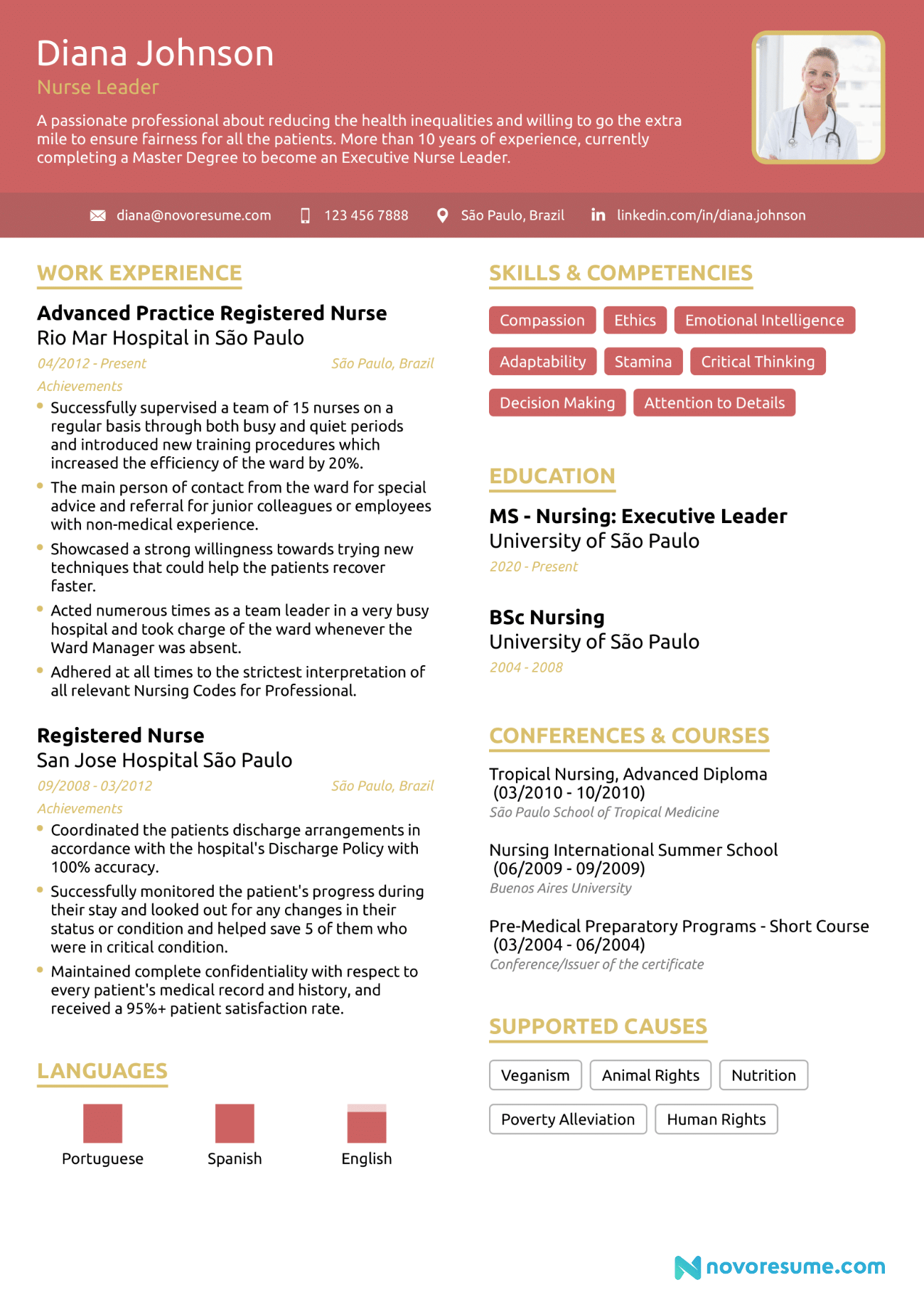
Check out our full guide to writing a nurse resume here.
#2. Data Scientist Resume Example
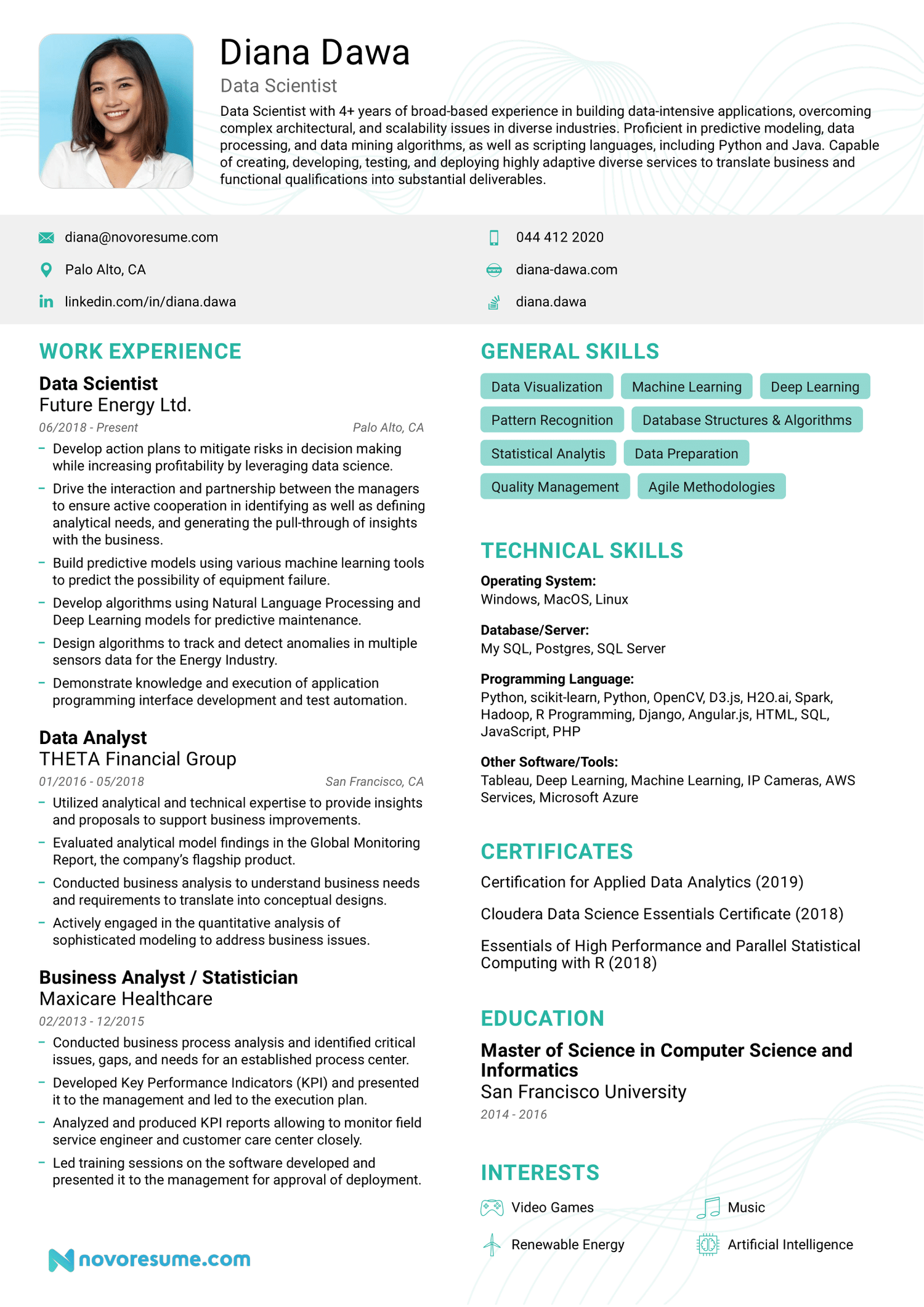
Check out our full guide to writing a data scientist resume here.
#3. Business Analyst Resume Example
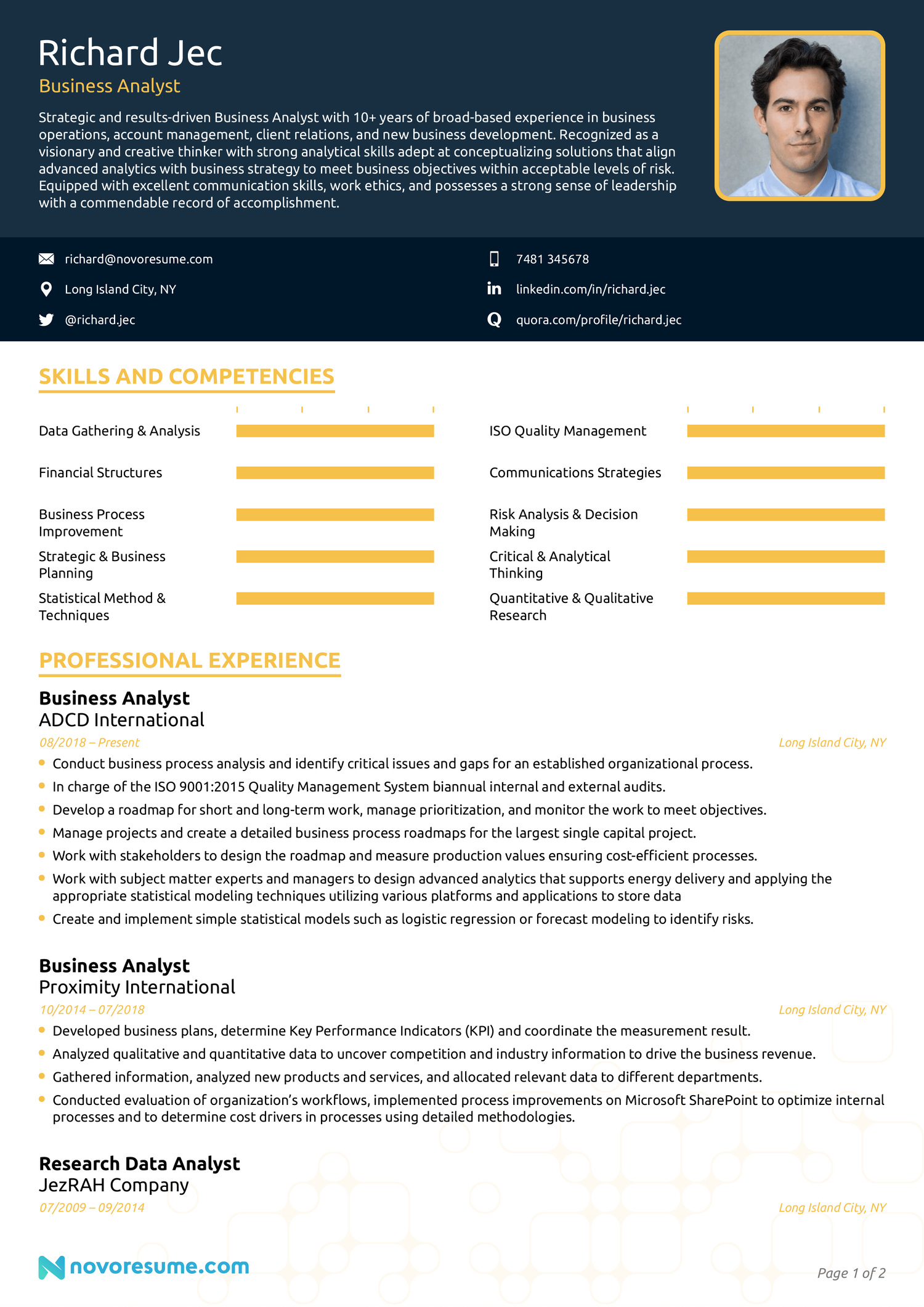
Check out our full guide to writing a business analyst resume here.
#4. Digital Marketing Resume Example
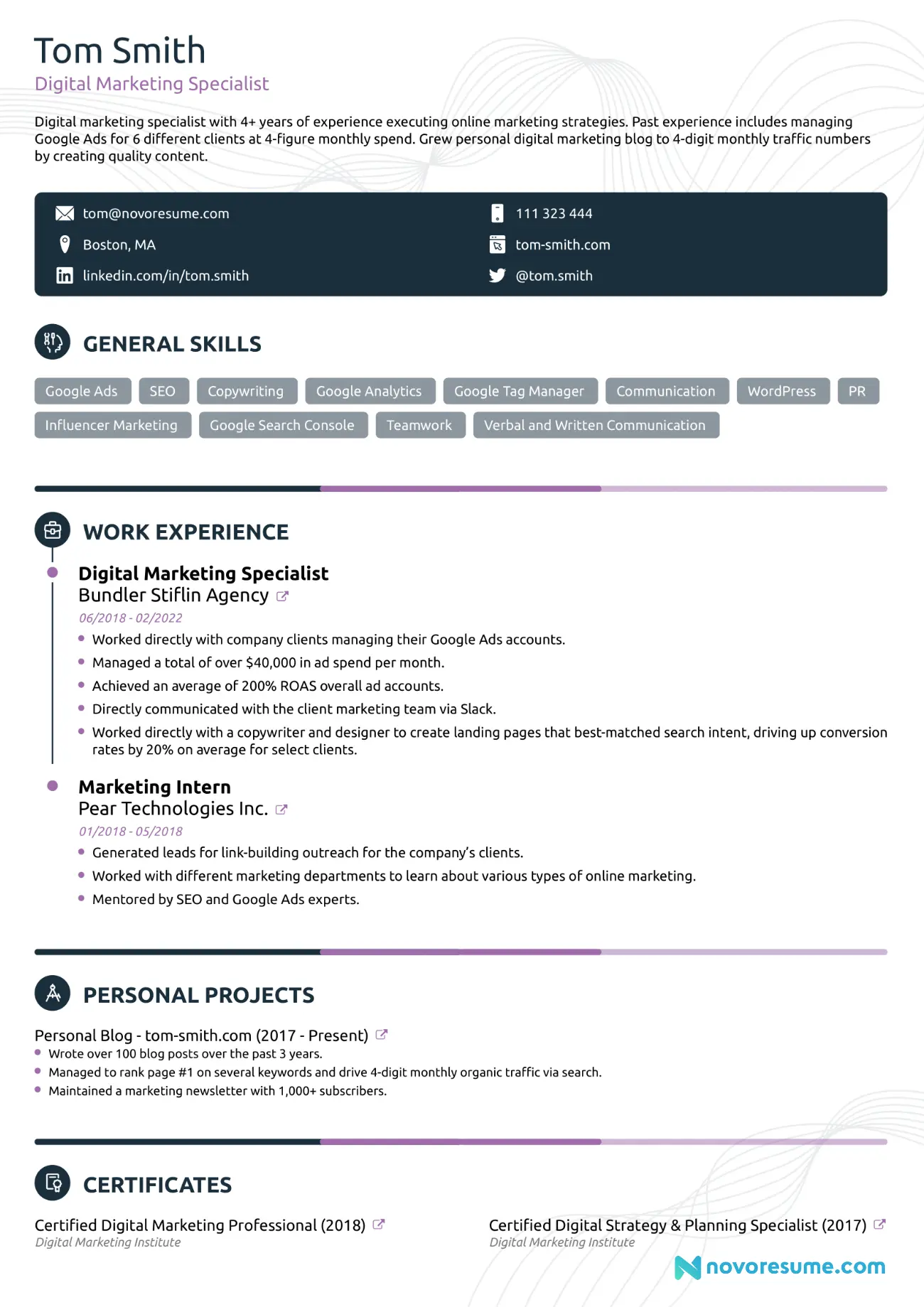
Check out our full guide to writing a digital marketing resume here.
#5. Software Engineer Resume Example
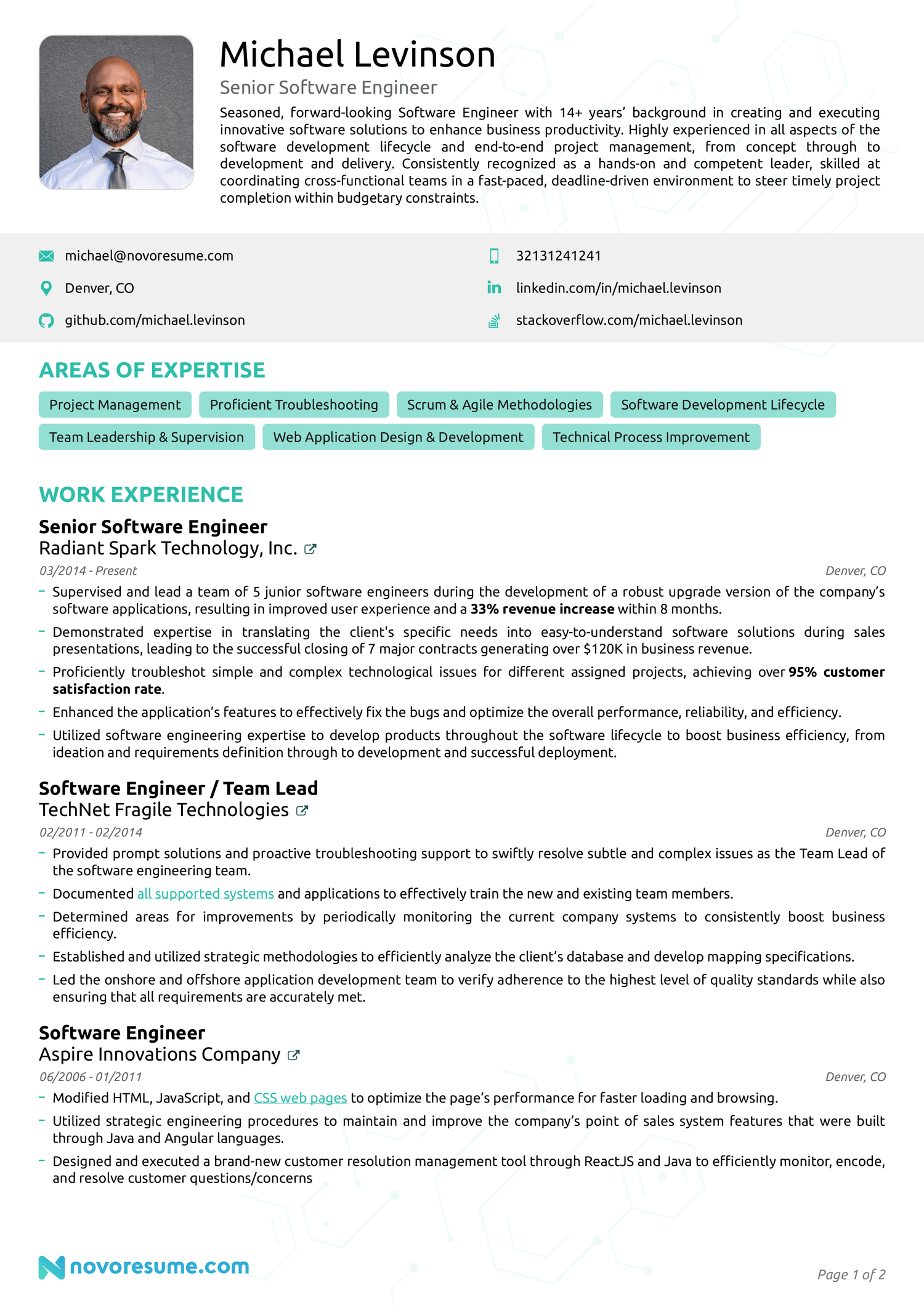
Check out our full guide to writing a software engineer resume here.
#6. Construction Project Manager Resume Example
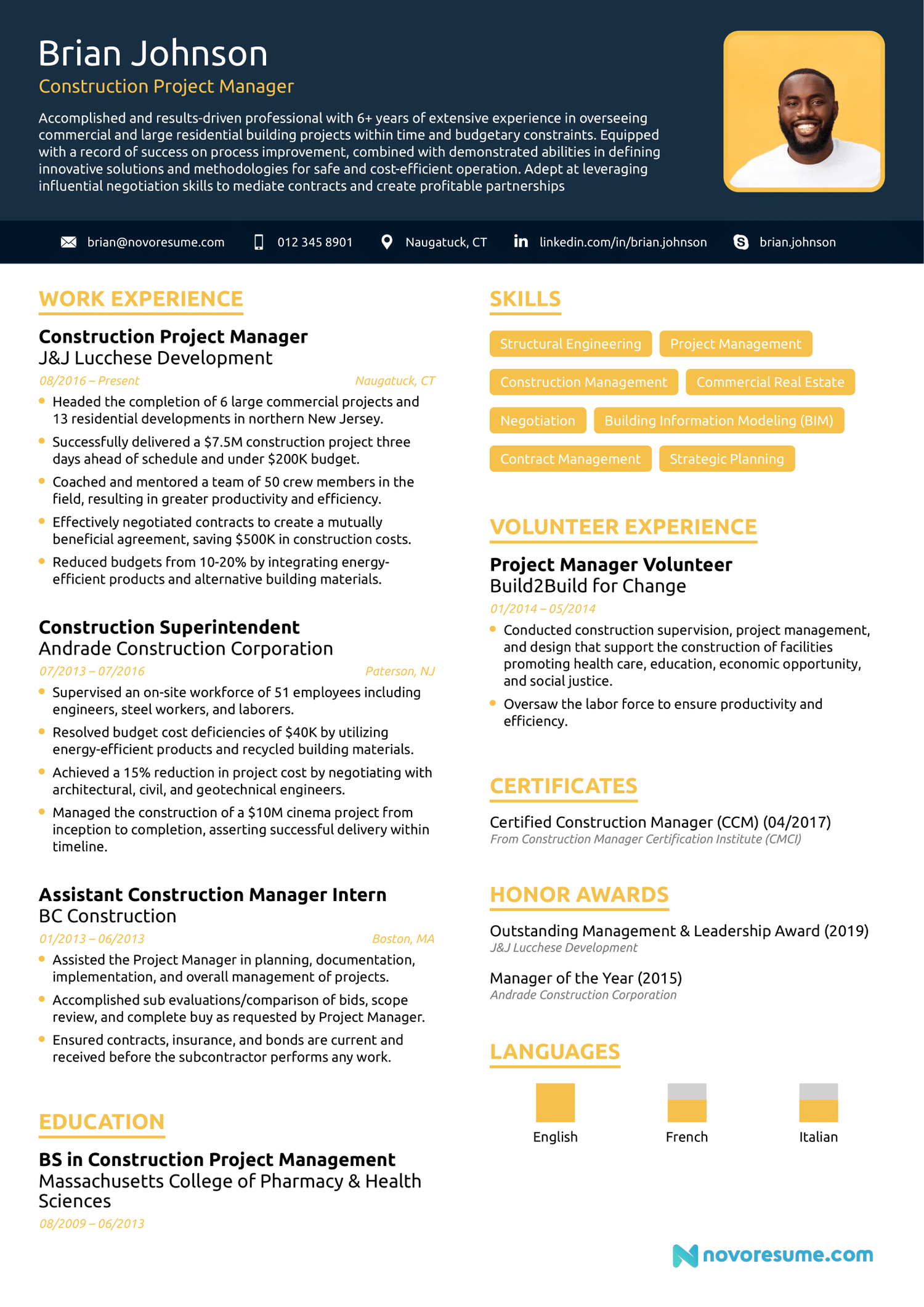
Check out our full guide to writing a construction project manager resume here.
#7. Customer Service Resume Example
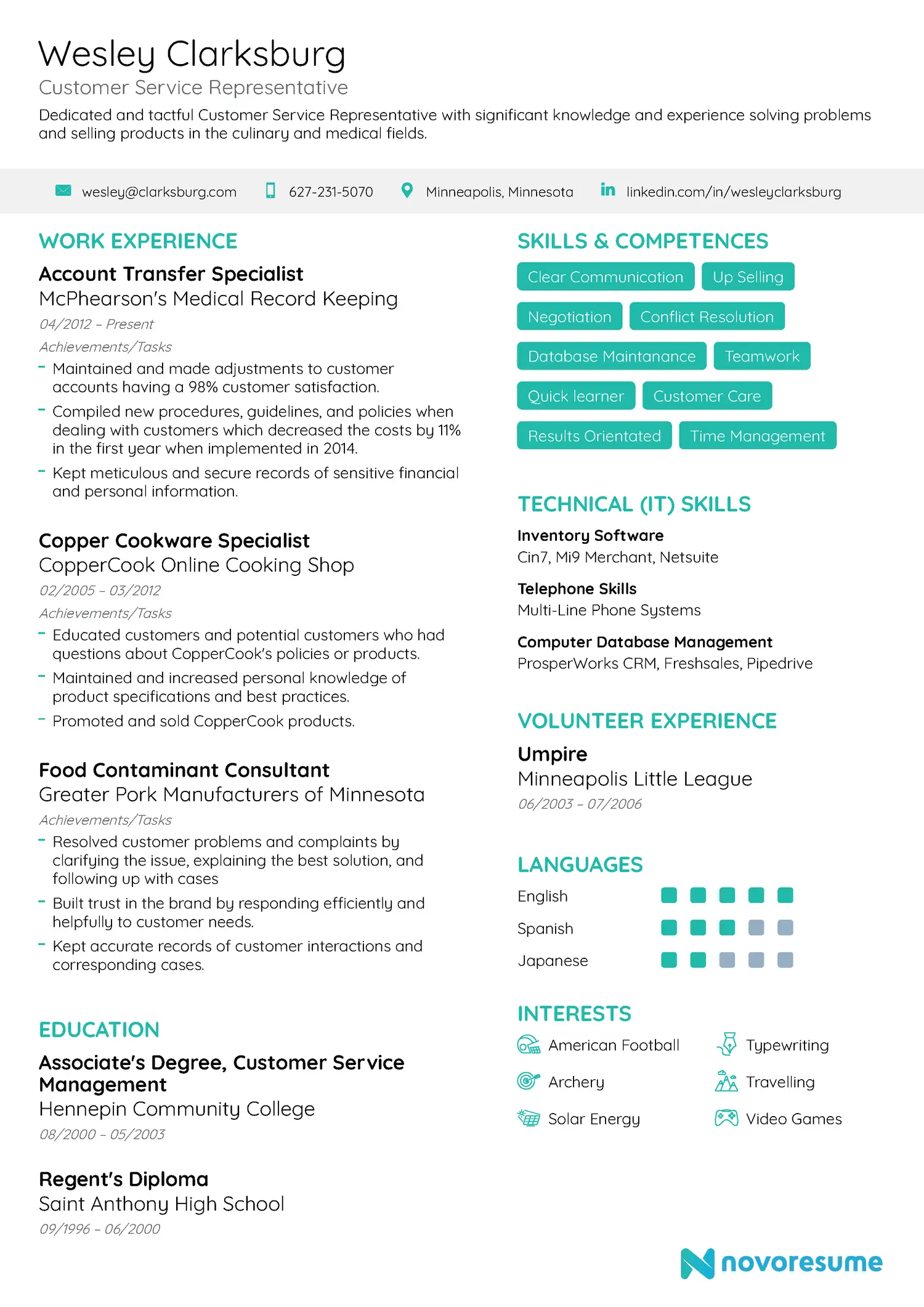
Check out our full guide to writing a customer service resume here.
#8. High School Resume Example
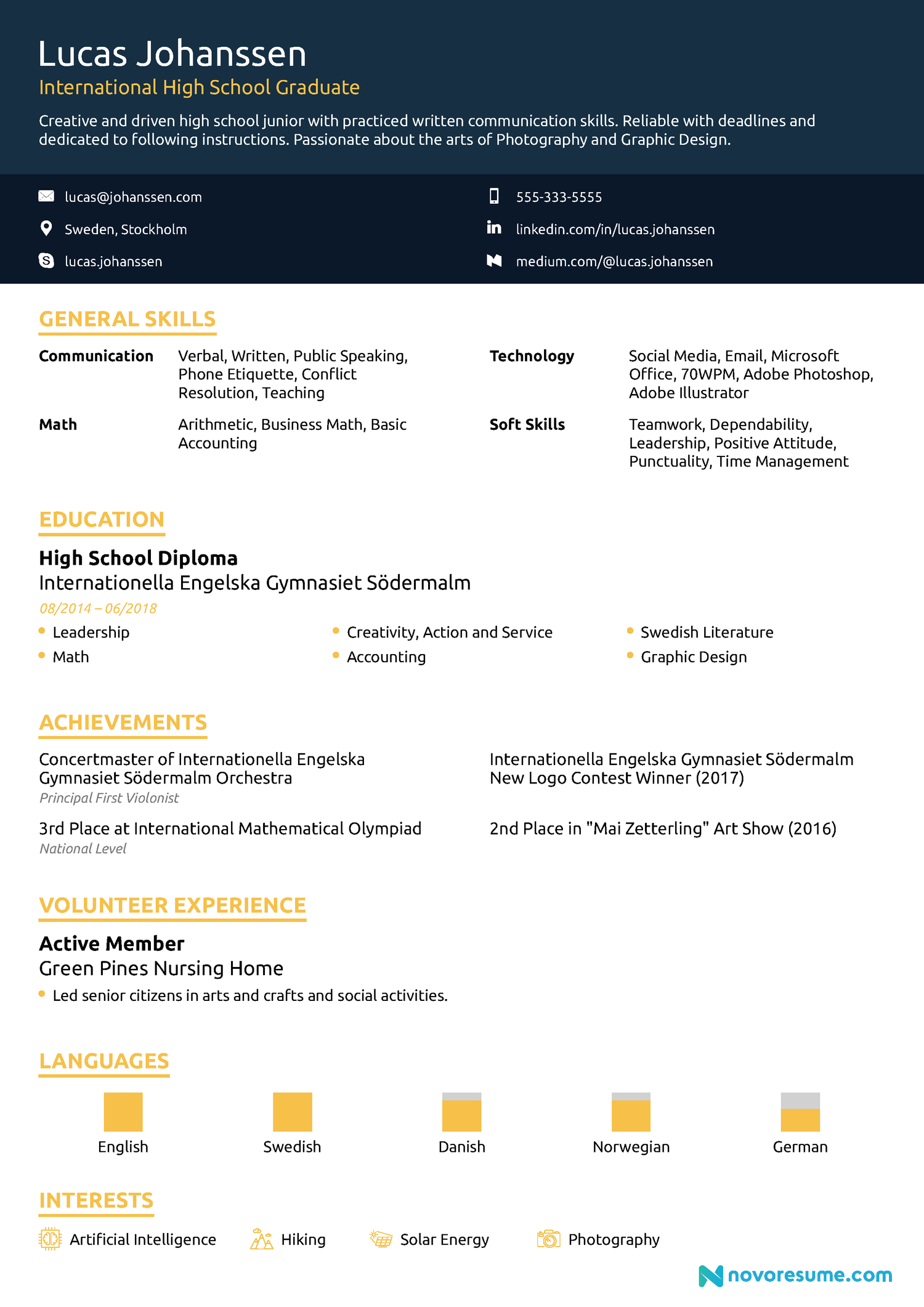
Check out our full guide to writing a high school resume here.
#9. Student Resume Example
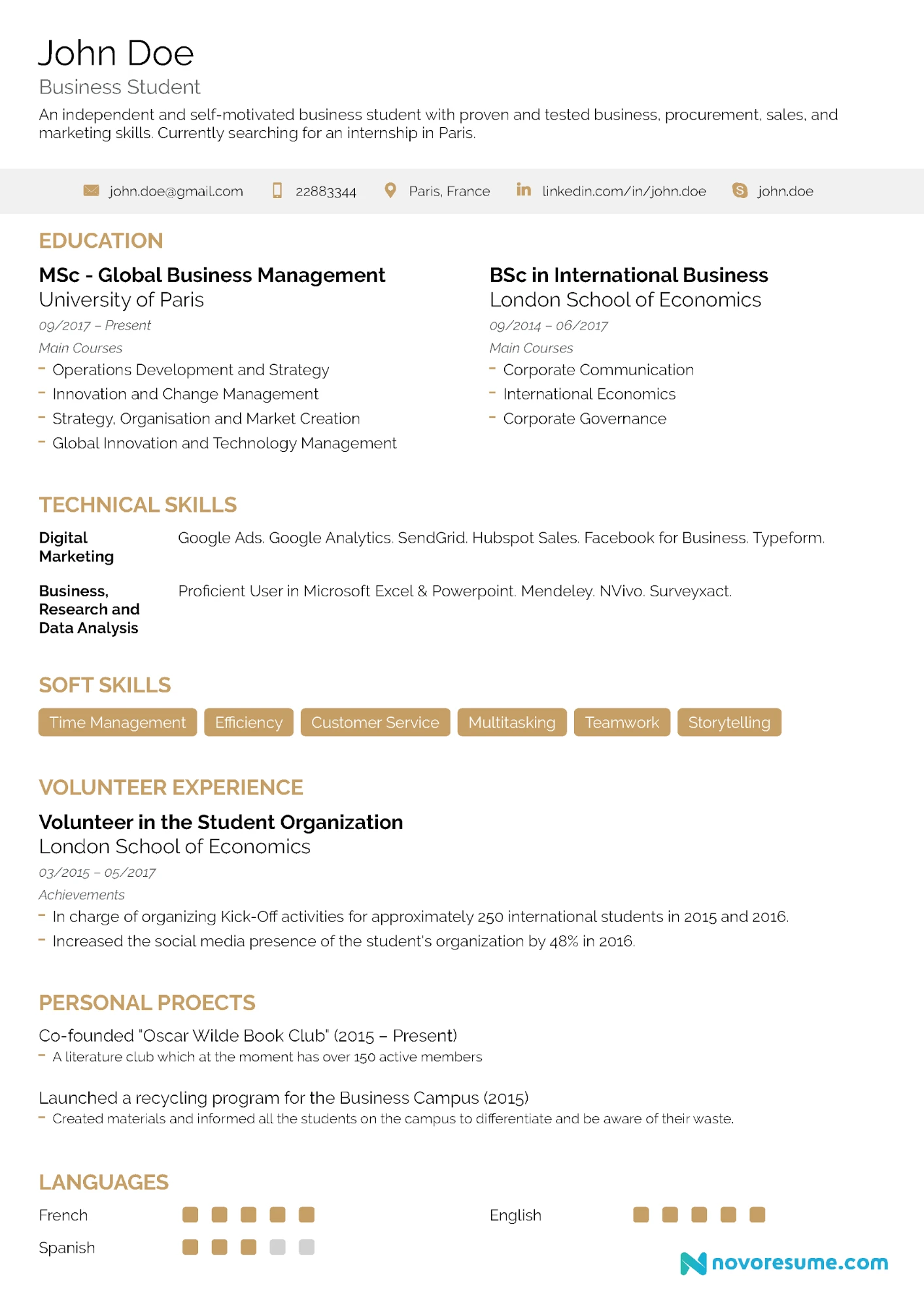
Check out our full guide to writing a student resume here.
#10. Server Resume Example
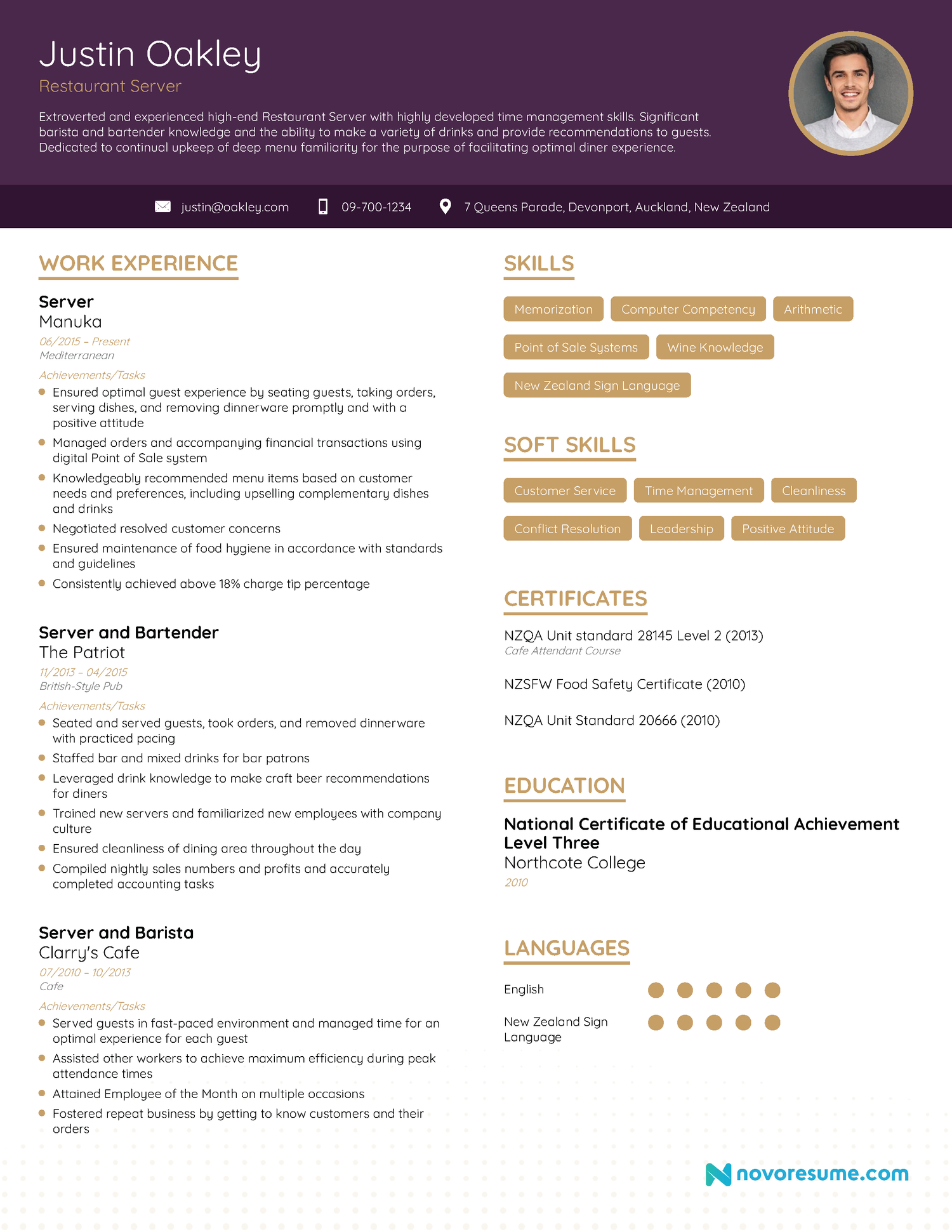
Check out our full guide to writing a server resume here.
#11. Actor Resume Example
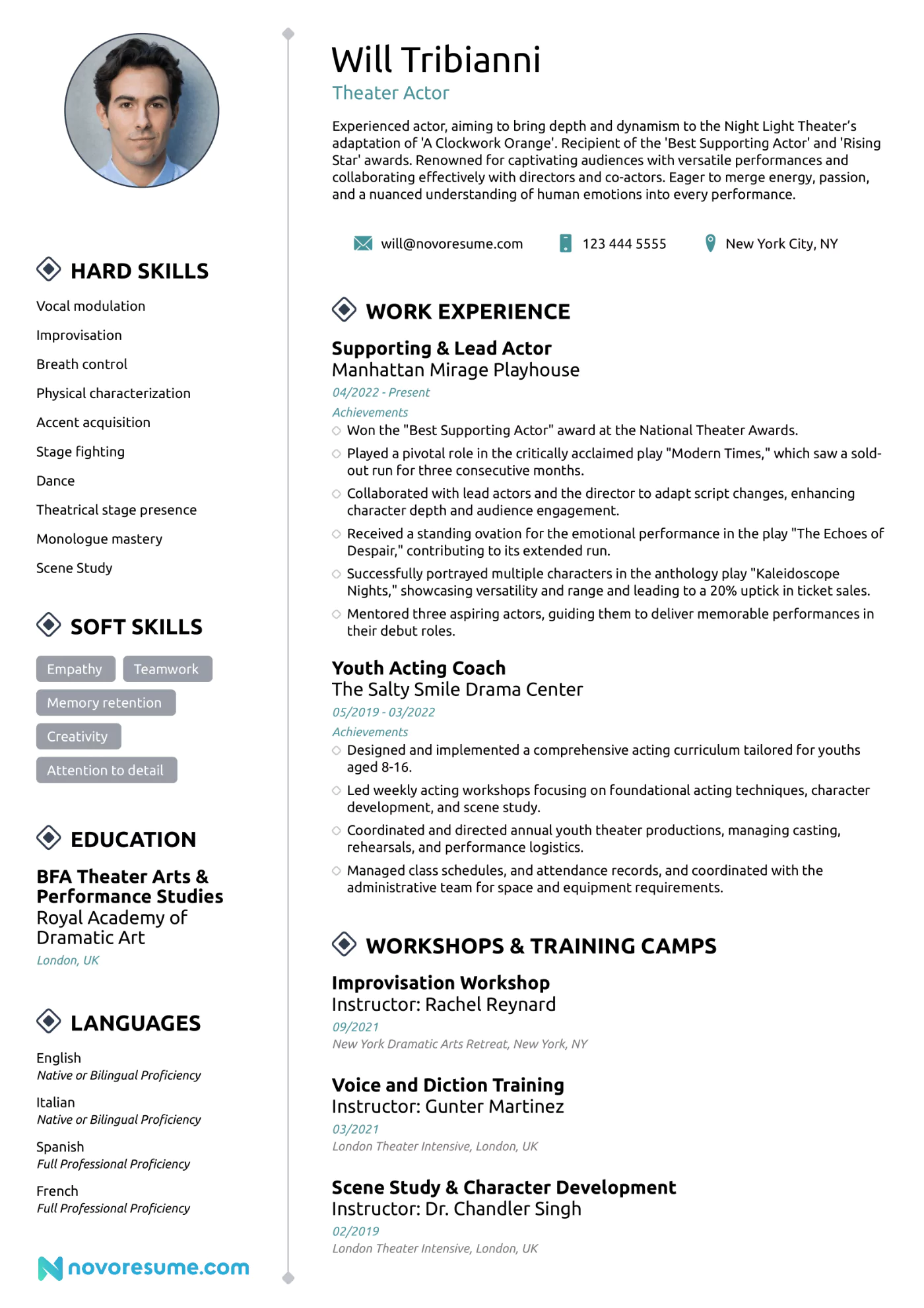
Check out our full guide to writing an actor resume here.
#12. Web Developer Resume Example
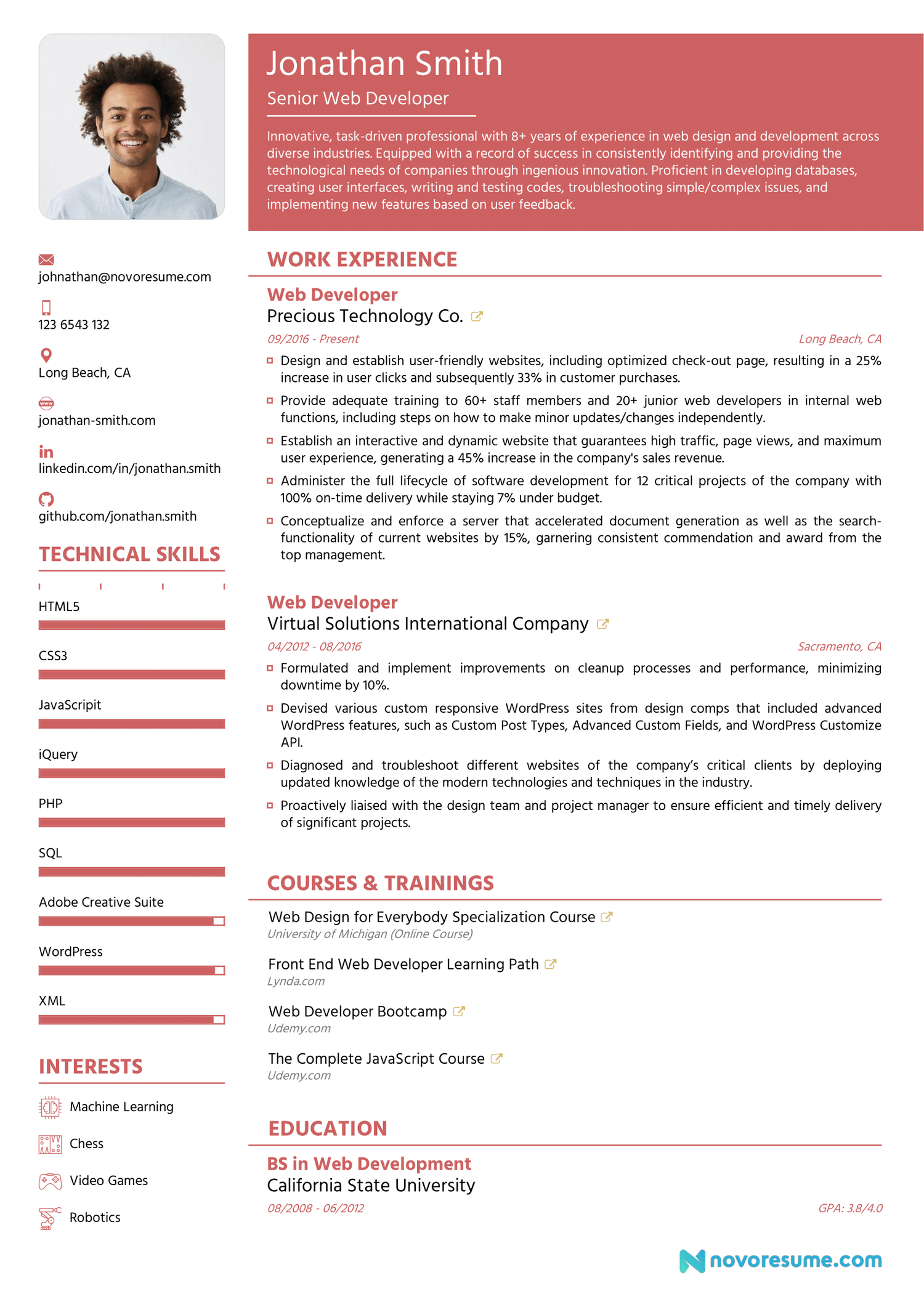
Check out our full guide to writing a web developer resume here.
#13. Engineering Resume Example
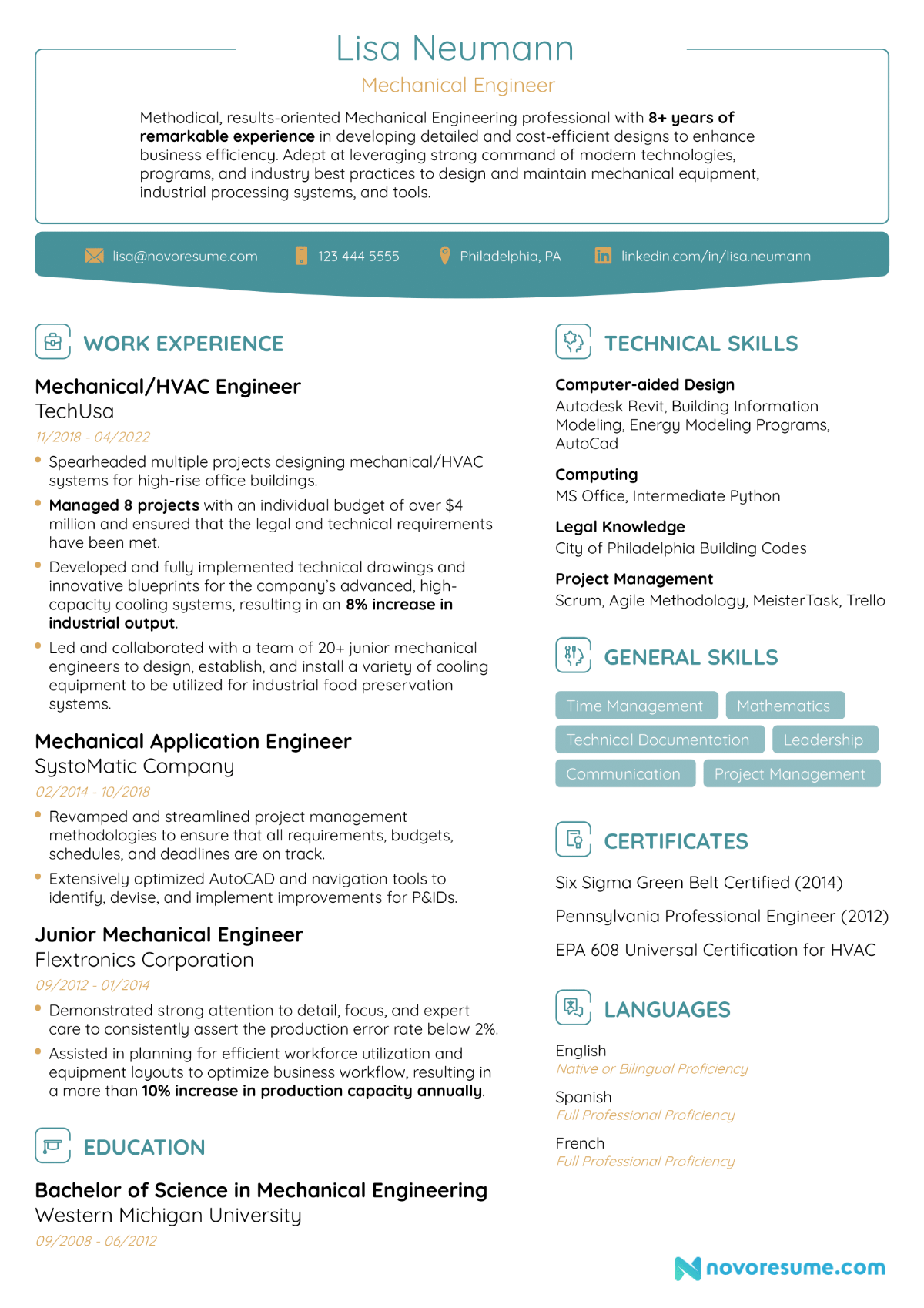
Check out our full guide to writing an engineering resume here.
#14. Computer Science Resume Example
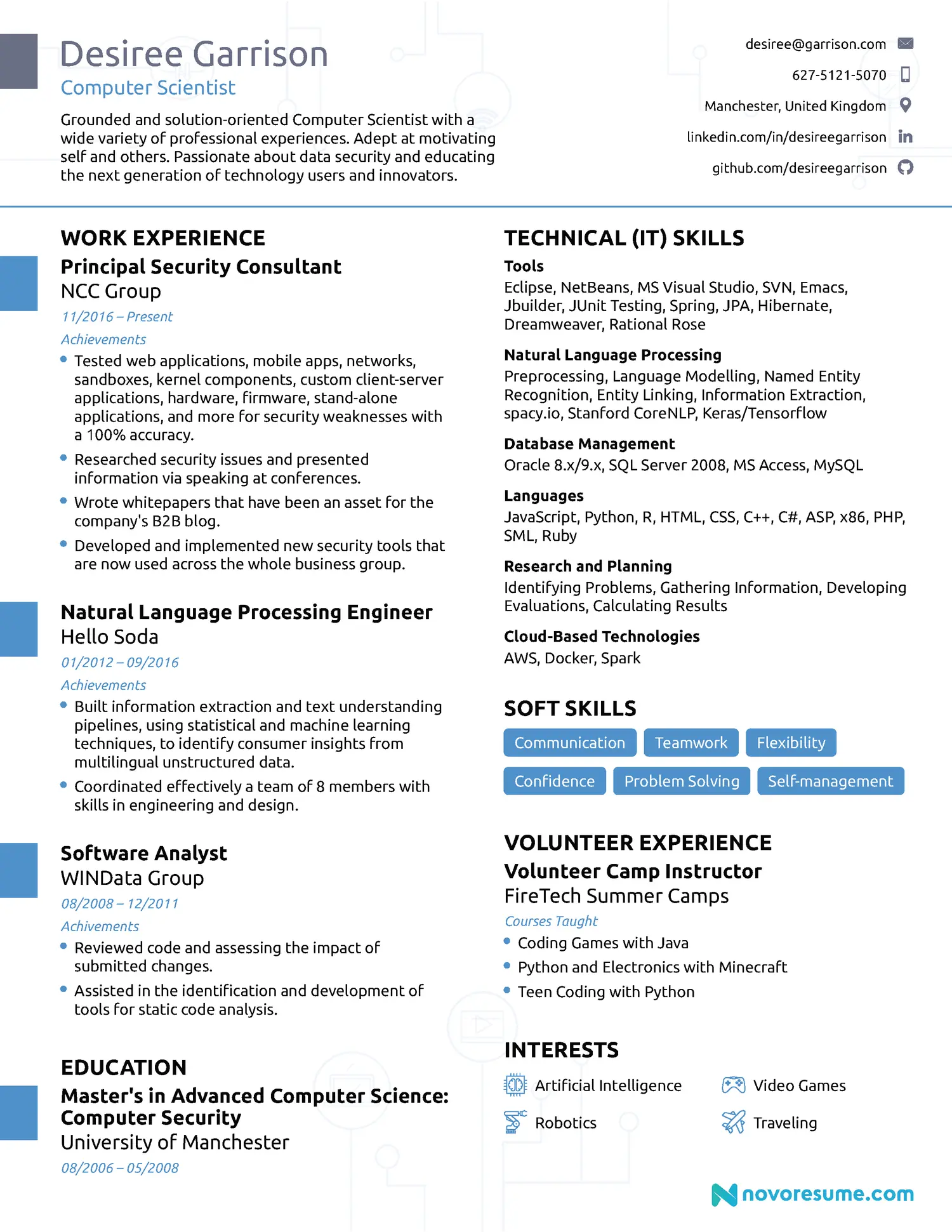
Check out our full guide to writing a computer science resume here.
#15. Architect Resume Example
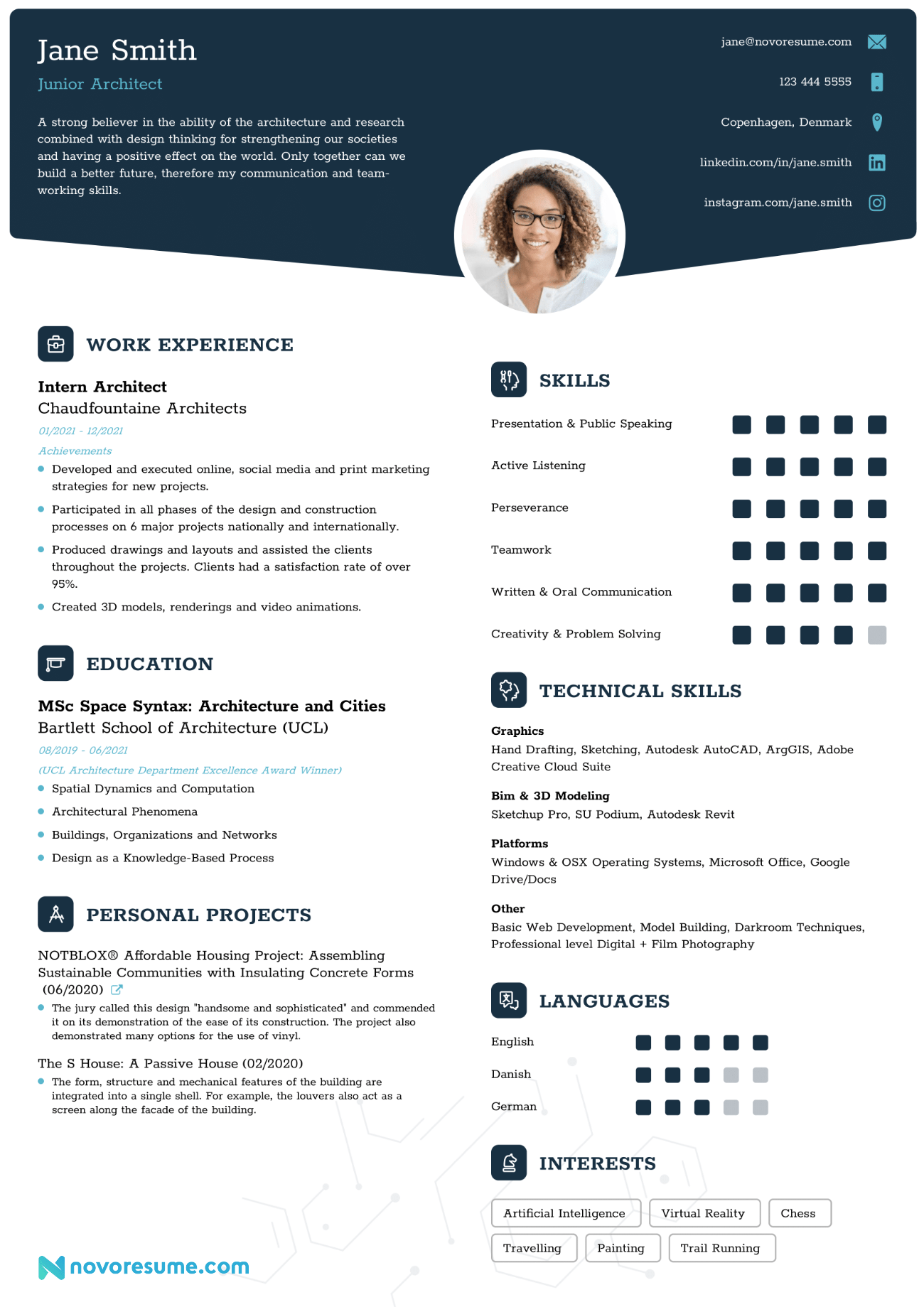
Check out our full guide to writing a data analyst resume here.
#17. Remote Job Resume Example
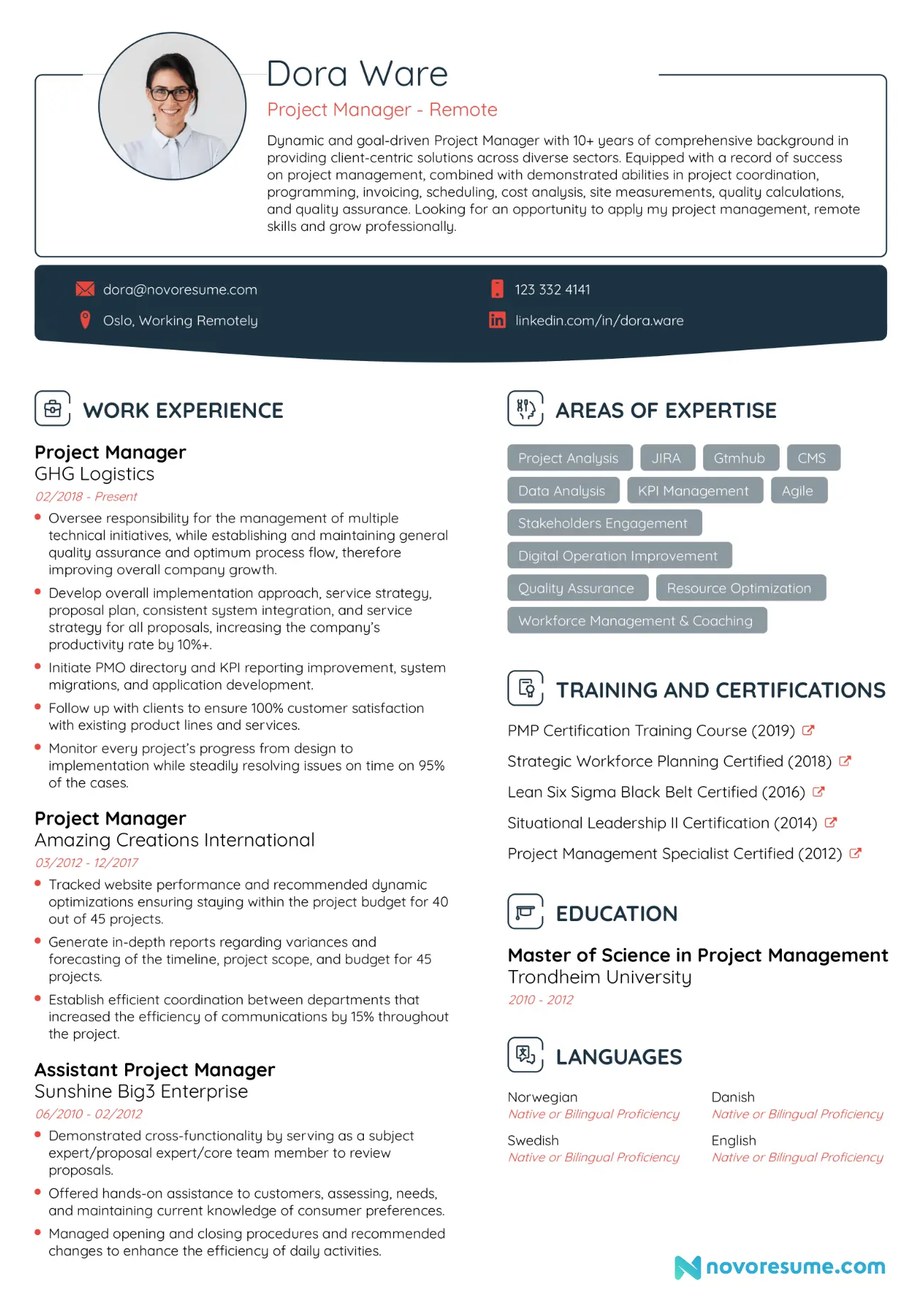
Check out our full guide to writing a remote job resume here.
#18. Sales Associate Resume Example
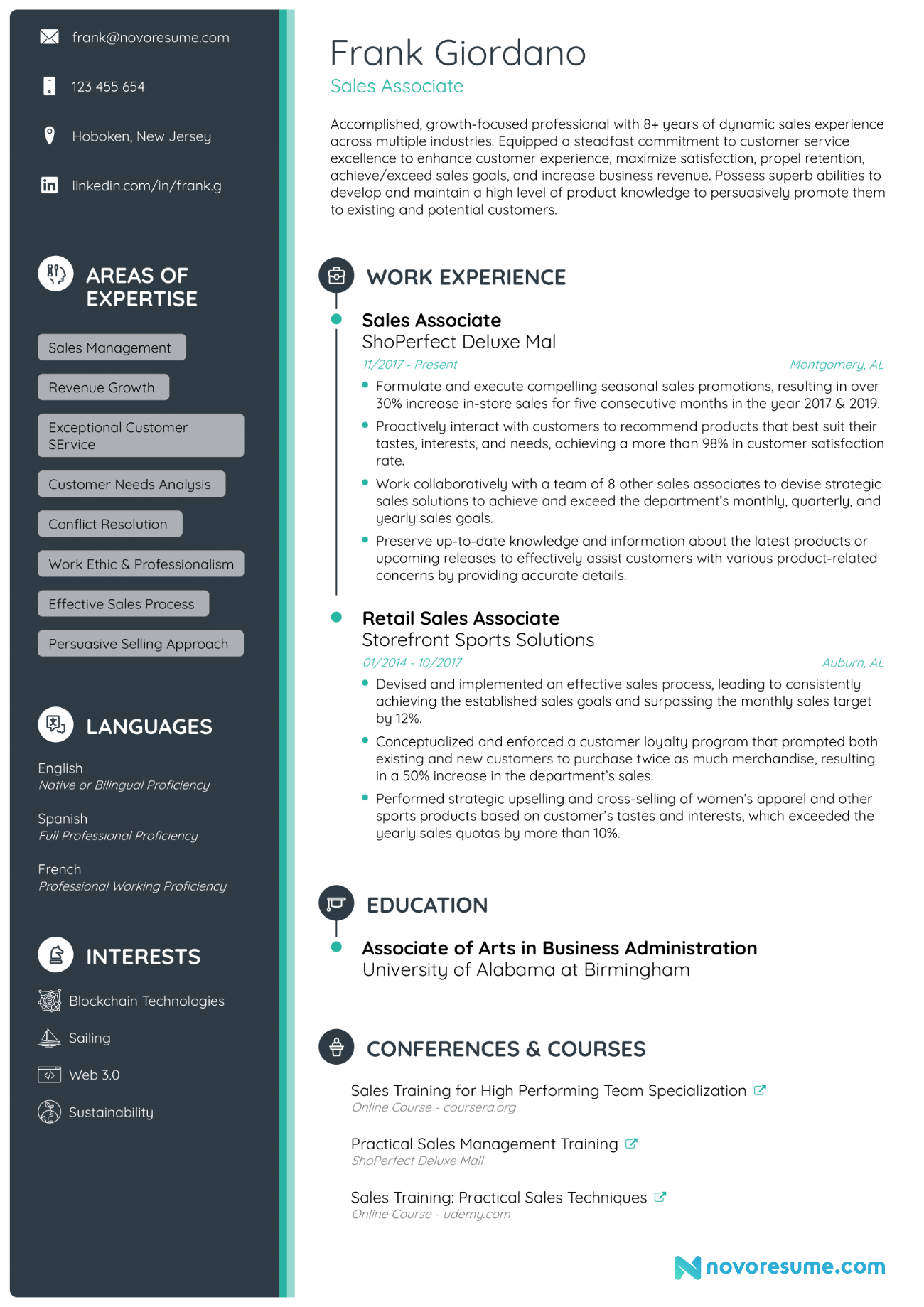
Check out our full guide to writing a sales associate resume here.
#19. Receptionist Resume Example
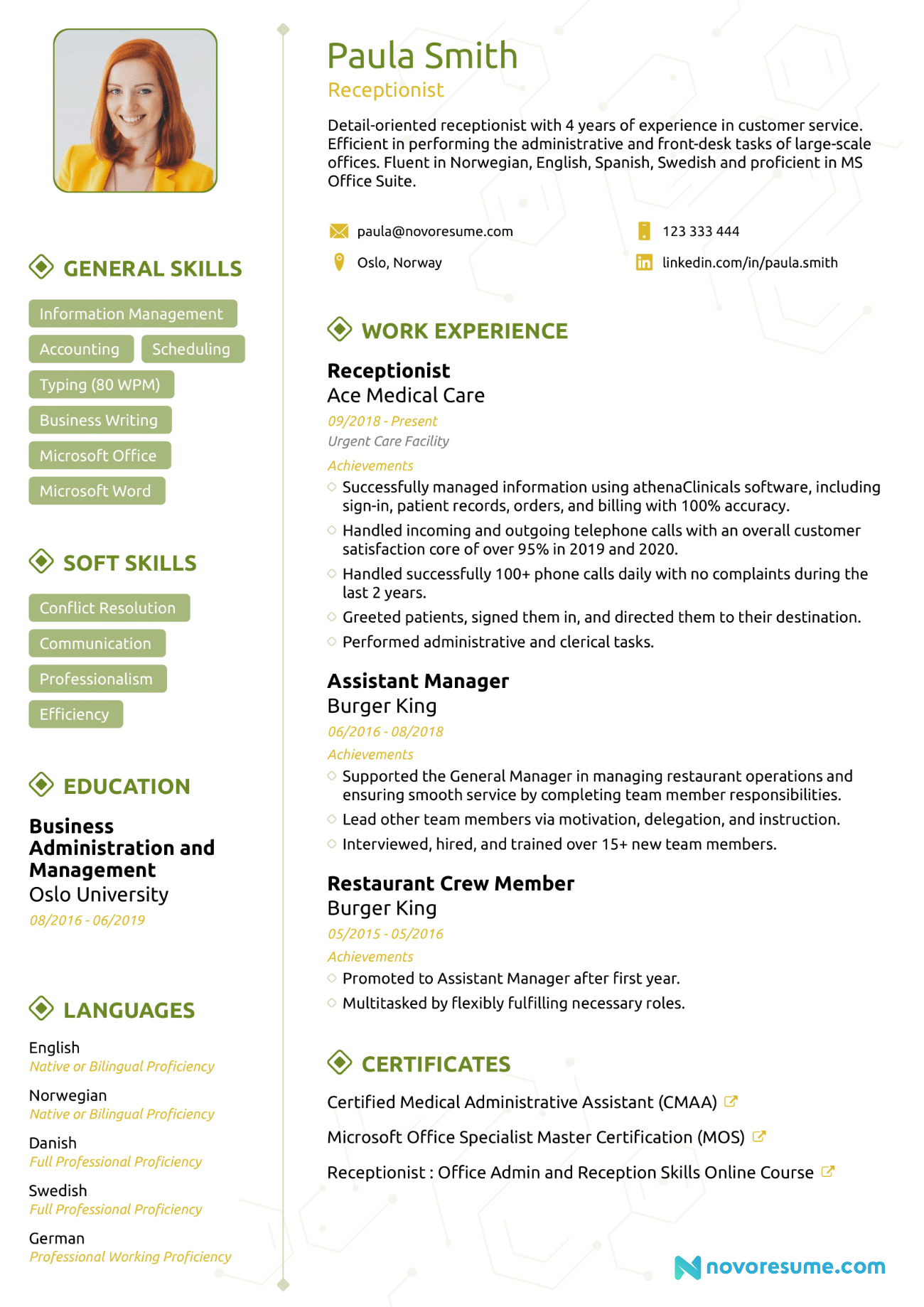
Check out our full guide to writing a receptionist resume here.
Want to see more examples? Check out our compilation of 80+ resume examples for different fields .
- Administrative Assistant Resume
- Bartender Resume
- DevOps Engineer Resume
- Executive Assistant Resume
- Flight Attendant Resume
- Graphic Designer Resume
- Paralegal Resume
- Pharmacist Resume
- Recruiter Resume
- Supervisor Resume
Next Steps After Your Resume
Now that we’ve covered everything you need to know about how to make a resume, it’s time to talk about the rest of your job application.
After all, your resume is only the first step in your job search. To land the job you deserve, you also need to write a captivating cover letter and ace that upcoming interview. Here’s how:
#1. How to Write a Convincing Cover Letter
The companion piece to every resume is the cover letter.
Most job-seekers flinch when they hear that they have to write a cover letter. What do you even mention in a cover letter, anyway? If you were good at writing cover letters, you’d be applying for a job as a writer !
In reality, though, writing a cover letter is very simple once you know its purpose.
Think of your cover letter as a direct message to the hiring manager. It’s your chance to briefly explain why you’re such an awesome fit for the position. And with a few cover letter tips to point you in the right direction, you’ll write the perfect cover letter for your job application.
Just follow this structure:
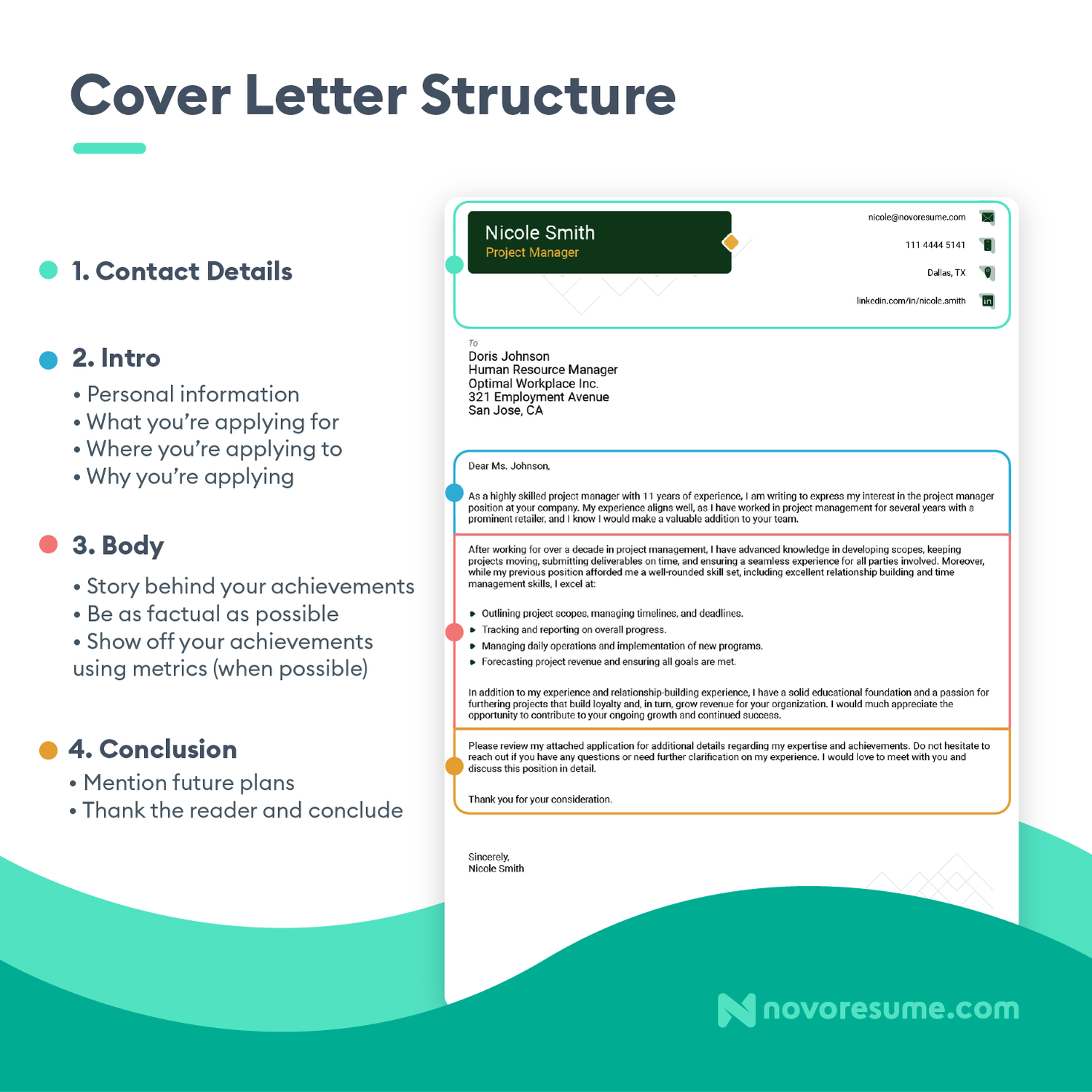
- Add the contact details. Include the same contact information as on your resume, plus additional contact details for the hiring manager, including their name, job title, the company’s name, and location.
- Introduce yourself. Start your cover letter by mentioning who you are, what your work experience is, and why you’re interested in the position. Mention a standout achievement or two, relevant skills, and what you’d like to do for the company you’re applying for.
- Explain why you’d excel at the job. Find the requirements in the job ad that you meet, and elaborate on how you fulfill the most important ones. Research the company so you know what you like about it, and mention it in your cover letter. Make sure to convey your enthusiasm for the job and confidence that you’ll be a great fit for their team.
- Wrap it up politely. Conclude your cover letter by recapping your key selling points and thanking the hiring manager for their time. Then add a call to action, such as “Please don’t hesitate to reach out to me at the provided phone number so that we can discuss my application in greater detail.” Then, add a closing line and follow it with your full name.
Sounds easy, right? Here’s a real-life example to drive the point home:
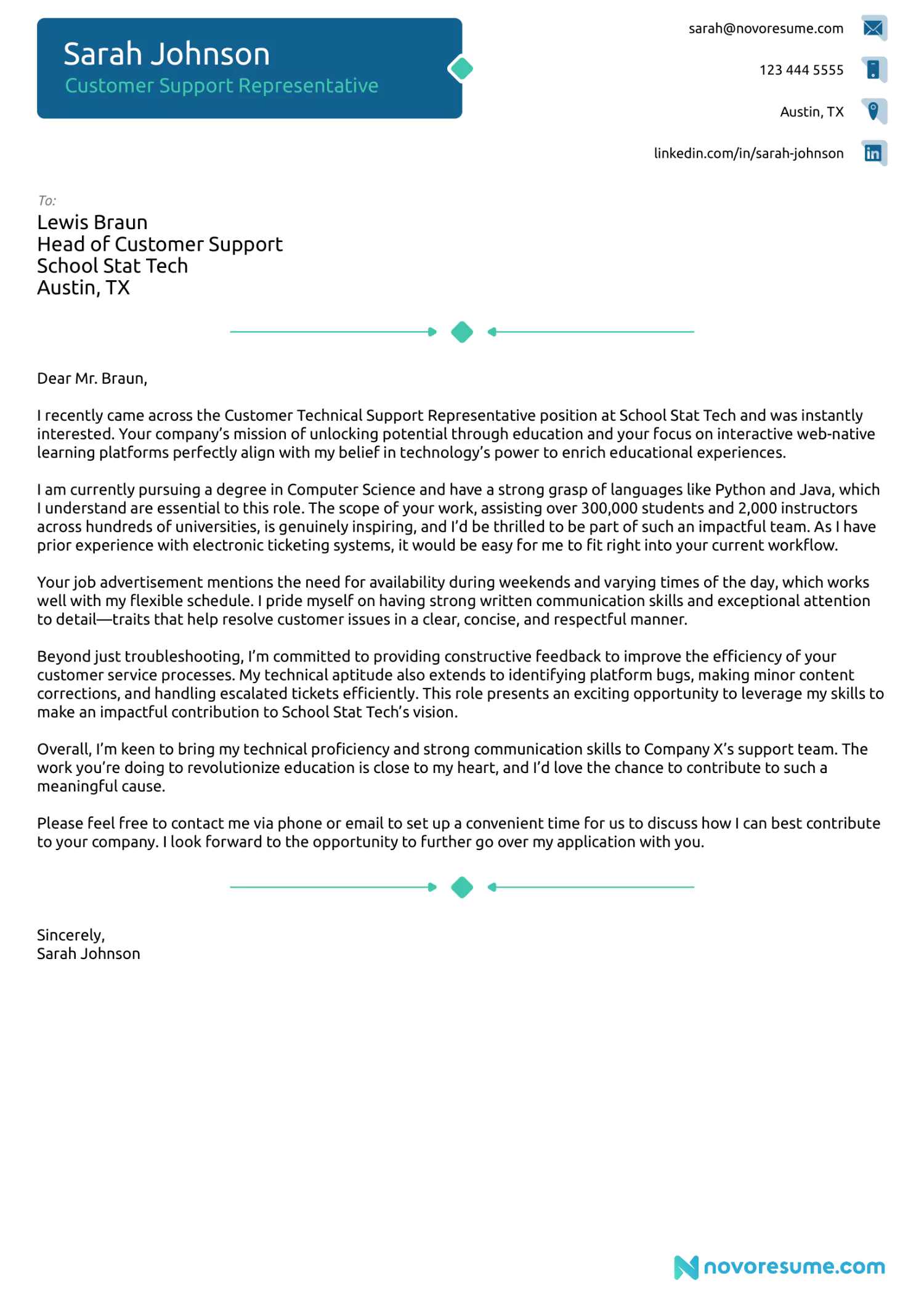
Do you need more help perfecting your cover letter? Learn what the most common cover letter mistakes are and check out cover letter examples for all professions here.
#2. How to Ace Your Next Interview
Once you’ve perfected both your resume and cover letter, there’s only one thing left.
It’s time for the final step—the dreaded job interview.
Whether you’re an extrovert or an introvert, you probably hate the interviewing process. No matter how experienced you are, it can be nerve-wracking. Sitting there while someone’s prodding into your past experiences and judging you isn’t fun.
But did you know that most interviewers ask the same questions?
That’s right—all you have to do is learn how to answer some of the most common interview questions, and you’ll be an interview away from landing your dream job!
Just check out our complete guide to the 35+ Job Interview Questions and Answers and learn how to ace your next interview.
FAQs on How to Make a Resume
Do you still have some questions about making a resume? Check out the answers to the most frequently asked questions below!
#1. What does a good resume look like in 2024?
For your resume to look good in 2024, make sure it’s organized and clean and isn’t longer than one page.
Be sure to include information that adds value to your application—leave out the focus on your relevant work experience and skills that you can back up, and list as many achievements as possible.
If you’re using a resume template, choose one based on your industry. Conservative industries like law, banking, and business require more traditional resume templates. But if you’re going for an industry like design, architecture, or marketing, you can go for a creative resume template .
Remote work is also big in 2024, so if that’s what you’re after, tailor your resume to match the job you want.
#2. How do you make a resume in Word?
The best way to create a resume in Word is to use a pre-designed Microsoft Word template. To access them, you should:
- Open MS Word
- Click “file” from the menu bar
- Select “new”
- Type “resume templates” in the search bar
That said, Word resume templates are generic, hard to personalize, and overall not very stylish.
Want a resume that looks good and is extremely easy to make? Check out resume templates to get started!
#3. How do I write a resume for my first job?
If you’re writing your first-ever resume for an entry-level position, the hiring manager won’t expect you to have any work experience.
However, you can make up for your lack of experience with your skills and academic achievements.
For example, you can take advantage of extracurricular activities, internships, volunteering experiences, and other non-professional experiences. You can use them to highlight the skills you’ve gained and what you’ve achieved so far.
So, your first job resume should have a resume objective, emphasize your education, and replace your work experience with any internships, volunteering, independent projects, or other experiences.
#4. How to make a resume on Google Docs?
You can make a resume on Google Docs by choosing one of their templates and filling it in on the go.
All you have to do is go to your Google Drive’s template gallery, choose your preferred template, fill in your information, and your Google Docs resume is ready to go!
That said, Google Docs templates aren’t the most user-friendly choice. You don’t have much flexibility with the layout and formatting isn’t that easy. For example, you tweak a section to the slightest, and the whole resume becomes a mess.
If you want an easier option, check out our resume builder !
#5. What kind of resume do employers prefer?
Typically, employers prefer one-page-long resumes that follow the reverse chronological format.
Hiring managers receive hundreds of resumes every day, so they don't have the time to read three-page resumes. Try one of our one-page resume templates so you don’t go over the recommended resume length.
Meanwhile, the reverse-chronological format is the most popular because it draws attention to your most recent jobs and professional achievements, which is the #1 most important thing hiring managers look at when evaluating a resume.
#6. How many jobs should you put on your resume?
You should only include relevant job positions on your resume.
This means that your work experience section should be tailored to the job you are applying for. If you’ve worked five different jobs and they can all add value to your current application, then you should include all five.
If, on the other hand, you’re applying for, say, a customer service position and some of your past jobs don’t have anything to do with customer service, you should skip them.
#7. Should I put my address on my resume?
You can put your location (city, state, or country) on your resume, but you don’t need to put your entire physical address.
Putting a physical address on a resume was the norm back when companies would contact you via mail. In today’s world, everyone communicates via email, which is why adding a correct and professional email address to your contact information section is far more important than putting your physical address.
So, just include your location or-–if you’re a remote worker—specify you prefer to work remotely by writing “working remotely from [location].”
#8. What information should I leave out of my resume?
As a general rule, you shouldn’t include your birthday or your headshot on your resume. This norm varies from country to country but it applies to the USA, Canada, and UK.
If you have plenty of achievements to list under your work experience, then you can leave your basic work responsibilities out of your resume.
In your education section, you should only include your highest and most recent degree. So, if you hold a Ph.D., you can list that and your Master’s degree and leave your Bachelor’s degree and high school diploma out.
Finally, leave out any skills that aren’t relevant to the job you’re applying for.
#9. Is a resume a CV?
Depending on where you are, a CV (Curriculum Vitae) and a resume might be completely different things.
In most of the world, though, including Europe and Asia, they are used interchangeably for the same document. Both CVs and resumes are one to two pages long, and list skills and experiences relevant to the position you’re applying for.
Sometimes more detailed resumes that go over one page are referred to as CVs. These are typically only used by senior professionals, executives, CEOs, etc.
In the USA, however, a CV is a completely different document. Typically, CVs are detailed and comprehensive documents that highlight your entire academic and professional history. They’re often used for academic, scientific, or research positions, which is why this type of CV can also be referred to as an academic CV.
You can create your CV using one of our CV templates !
#10. Should I write my own resume?
Yes, you should always write your own resume.
Your resume is your opportunity to show the hiring manager your communication, writing, and presentation skills . Employers also evaluate you based on how effectively you can convey information about yourself, and there’s no one that can represent you better than yourself.
Writing your own resume lets you introduce yourself authentically. You have the best understanding of your skills and experiences, and you can personalize them to make your resume stand out.
And, as a bonus, the experience of writing your resume yourself can be reflective and insightful, so it might help you understand your professional journey and career goals better.
#11. Can a resume be two pages?
Generally, we strongly recommend that your resume stick to one page.
Hiring managers go through hundreds of resumes every day, and keeping your resume to one page increases the odds that they’ll see your qualifications faster.
In some cases, like when you have a lot of relevant experience, your resume can go over two pages. But this exception is reserved for senior professionals with over a decade of relevant experience and tons of skills and achievements that simply can’t fit on one page.
#12. Is a simple resume okay?
Absolutely, a simple resume is often more than okay—it's preferable.
Before your resume even gets to the hiring manager, a complicated layout could get it rejected by the applicant tracking system (ATS). A simple resume template can help get your application straight to the hiring manager.
A clean layout can also make sure that your resume is easily readable and looks professional. This can focus the hiring manager's attention on your work experience and skills without excessive clutter or flashy colors to distract them.
Key Takeaways
And that’s a wrap!
If you’ve followed all of our advice until now, congrats! You’re probably an expert on how to make a resume.
To recap, let’s go through some of the most important lessons we’ve learned so far...
- Use the right resume builder to make the process as smooth as possible. You don’t want to mess around with formatting for hours before even starting to work on your resume!
- Focus on your achievements over responsibilities. This can help you stand out from all the other applicants, especially if you back your claims up with data.
- Include all the must-have sections, like the resume summary, work experience, education, and skills. Then leverage optional sections if you have leftover space.
- Tailor your resume for the job you’re applying for. Everything listed on your resume should be relevant to the specific job you’re applying for, and you should write a new resume for every new job application.
- Take the time to perfect your cover letter. It’s just as important as your resume, so make sure you pay as much attention to it!

To provide a safer experience, the best content and great communication, we use cookies. Learn how we use them for non-authenticated users.
Your Step-by-Step Guide to Making the Perfect Resume (With Examples!)

Your resume is arguably the most valuable piece of paper for your career. But this document can be daunting for many. Maybe you’re not sure how to fit in all your information onto one page. Maybe you’re not sure about the right way to format and write your resume. Maybe you don’t even know what the heck a resume is!
Whatever your concern, we’ll break down everything you need to know about making the perfect resume, from scratch.
What Is a Resume?
What are employers looking for in a resume.
- Pick Your Format
- Start With Your Basic Information
- Add in Your Work Experience
- Consider Including Volunteer Work or Other Experience
- Don’t Forget Your Education
- Top It Off With Some Skills and Interests
- Write a Resume Summary Statement (if Relevant)
- Tailor It to the Job (and the ATS)
- Edit and Refine It
What Are Some Examples of a Good Resume?
A resume is a summary of your career, whether yours is just getting started or has been going on for years. Coming in at around one page in length (two only under specific circumstances), it showcases the jobs you’ve held and currently hold, the responsibilities you’ve taken on, the skills you’ve developed, and the qualities you bring to the table as an employee. Together, those things make it super easy for any hiring manager to see your qualifications and fit for a role.
For all the work you may put into writing one, hiring managers actually spend very little time—mere seconds in many cases—looking at your resume. But despite this sad fact, it’s safe to say that creating a great resume (rather than hastily throwing one together) still matters.
“If you miss the mark, your resume may never be read. Even worse, you might be removed from the applicant pool by a computer before a human even knows you exist,” says Muse career coach Heather Yurovsky , founder of Shatter & Shine. So you want to get it right because, as she explains, isn’t the goal to “spend less time looking for a job and more time in a role you love?”
You might be wondering if you can lean on your LinkedIn profile instead of writing a resume. The answer, sadly, is no. Most hiring managers still expect you to submit a resume, even if they also look at your LinkedIn. Even if you don’t need a resume for a job you’re applying for now, you’re going to need one at some point in your career—they’re not anywhere close to going out of style. So it’s best to always have one at the ready should an opportunity pop up.
And although LinkedIn has plenty of benefits, a resume has one clear advantage: While your LinkedIn is usually a broader picture of your career trajectory, your resume gives you the opportunity to tailor your career story to a specific role or company (more on that later).
Oh, and you’ve probably heard of something called a CV? It’s slightly different from a resume , and usually more common with academics and job seekers outside the U.S.
Hiring managers look for three things on your resume, “What did you do? Why did you do it? And what was the result?” says Muse career coach Martin McGovern , owner of Career Therapy. “If you can answer all three of these questions in...your resume bullet points, you’re going to be on the right track.”
Clear, easy-to-understand language is key. “The truth is that most resumes make no sense. They are stuffed with jargon, they are too technical, and they are filled with redundancies. Try to read a resume that isn’t yours and you will quickly realize that it feels like an alien wrote it,” McGovern adds. Put yourself in the shoes of a recruiter who has no idea how your role works—how can you make your resume accessible to them?
The hiring manager also cares about more than just you and you alone—they care about you in relation to them. “Hiring managers want to see if a candidate matches the requirements” of the role they’re hiring for, Yurovsky explains. “Your resume should paint this picture so the hiring manager not only knows what day-to-day responsibilities you can handle, but why you, above other[s], bring value to their organization.”
How Do You Write a Resume?
Whether you’re someone who’s never written a resume in your life, or you need a nice, thorough refresher on the process of creating one, follow these steps to go from a blank page to a complete—and dare I say beautiful—document.
Related: This Free Worksheet Makes It Easy to Create (or Update) Your Resume
1. Pick Your Format
Before you start typing one single thing, you have to decide what you want the overall resume to look like.
Resume builders can be helpful for this step—they’ll take all your basic information and organize it for you, eliminating some of the legwork. You can also use a pre-made outline, such as one of these free Google Docs templates .
But it’s often safest to start with a clean slate all on your own and eventually upgrade to a more advanced layout. (If you'd still like a place to write all the relevant information before you get started, check out our resume outline .) This allows you to course correct, edit and re-edit, and choose a resume format that best fits your particular situation (after all, not everyone has a career trajectory that’s easy to compartmentalize).
In general, you’re most likely to cover and/or include sections on the following:
- Your work experience
- Your non-work experience, including professional organizations, community involvement, or side projects
- Your education and certifications
- Your skills (specifically hard skills) and interests
So how do you format and organize all of that information?
By far the most common (and safest, if you’re not sure which route to take) option is reverse chronological order . This means you organize your experiences from most recent to least recent. So your work experiences would go above your education, and your current role would go above previous roles you’ve held. This of course has its exceptions—maybe you went back to grad school between jobs, or your most recent role is irrelevant to the job you’re applying for. So the whole page may not be exactly in reverse chronological order depending on your situation. It’s just a guideline.
There’s also something called a functional or skills-based resume . This is used pretty rarely, mainly with career changers and those with limited or complicated work histories. It gets its name because it’s primarily about listing your skills rather than experiences, and showcases them above your work history and education.
You can also opt for a combination resume , which is a mix between a reverse chronological resume and skills-based resume. It highlights your skills at the top, but allows just as much room below to cover your job and school experience.
Use caution when choosing these two formats: “Combo and skills-based [resumes] can be hard to follow, because [they force] the reader to hunt for connections between your skills and experience, and [don’t] provide the full context of your work,” says Muse Career Coach Angela Smith , founder of Loft Consulting. “I’ve also heard a lot of recruiters say that they automatically discount skill-based resumes because they feel the candidate is trying to hide something. I don’t necessarily believe that, but I think it’s important for job-seekers to know that perception is out there.”
2. Start With Your Basic Information
Your contact information should always go at the top of your resume. In this header you’ll want to include anything that could be helpful for a recruiter to get in touch with you. Usually, this means adding in:
- Your full name (preferably the name you use across the web)
- Your phone number
- Your personal email address
You might also choose to include other basic information, such as your LinkedIn or personal website URL, your GitHub (for technical roles), your social media profiles (if relevant to the job), or your address. If you’re looking to move for a job, you may choose to leave out your address or write “open to relocating” to better your chances of getting an interview.
The key is to make this part as clear as possible. If a hiring manager can’t reach you, there’s no point in perfecting the rest of your resume.
3. Add in Your Work Experience
This section will most likely be the bulk of your resume. Even if you’re changing careers, employers still want to see where you’ve worked, what you’ve done, and the impact of that work to get a sense of your background and expertise.
Your “Work Experience” might be one entire category, or you might choose to break it up into “Relevant Experience” and “Additional Experience” to highlight the jobs that are most important for hiring managers to focus on. Either way, you’ll almost always want to have your most recent experience at the top and your older experience down below.
Within your work experience, you’ll want to include each official job title, the company (and possibly its location), and the years you worked there. Below that, you’ll add in two to four bullet points explaining what you did in that job, the skills you built and exercised, the tools you used, and the results of what you did. If you accomplished a lot during your time there, focus on the responsibilities that made the most impact or you’re the most proud of, as well as the ones that best align you with the job you’re applying for (more on that in the following sections). It’s key here to list, if relevant, quantitative as well as qualitative accomplishments.
For example, you might write:
Associate Accountant, Finances and Co., Ann Arbor, MI September 2017 – Present
- Manage billing and invoicing for more than 50 clients, ensuring the deadlines and needs of our enterprise partners, including Big Company and Super Star Org, are met
- Collaborate closely with sales, account management, and project management teams on project setup, maintenance, and invoice management
- Assist in the streamlining of invoicing guidelines and procedures through documentation and the implementation of new software, resulting in an average two-week decrease in total time spent per client
Your resume bullets should be in past tense if you’re referring to past jobs and present tense if you’re talking about your current roles. In addition, your bullets should always start with a strong action verb that best describes what you did. And if you have examples of your work, consider hyperlinking them here as well.
If you have a ton of experience and this category is starting to run long (read: over one page), consider kicking out your oldest jobs unless they’re super relevant to the job you’re applying for, or extra impressive for your field.
Not sure where to start? “It’s helpful to do a brain dump and create a document that has everything and anything you consider as experience or an achievement,” says Yurovsky. From there, she explains, you can start to whittle down what is and isn’t important. And you can refer to this document later if you ever decide to update your resume for a specific role.
Need more specific advice on listing your work experience on your resume? Check out these additional resources:
- When you’ve held multiple jobs at the same company: 2 Jobs, 1 Company: How to Show Multiple Positions on Your Resume
- When you’re not sure what your accomplishments are or how to explain them: Resume Revamp: How to Turn Your Duties Into Accomplishments
- When you want to spruce up a boring or insignificant job: How to Make Your Most Boring Jobs Sound More Interesting on Your Resume
- When you’re considering fudging a job title: The Answer to “Can I Change My Job Title on My Resume to Make It More Accurate?”
- When you’ve had a bunch of short-term gigs: How to List Temporary Jobs on Your Resume
4. Consider Including Volunteer Work or Other Experience
Anything you’ve done that’s not work experience—your side gig, volunteer work, special projects—can be hosted under clearly-labeled sections (“Volunteer Experience” or “Activities,” for example). Depending on how robust your work experience is, these things may be worth including, particularly if they’ve helped you level up your skill set or better align you with your dream job. Plus, they make you look that much more well-rounded, passionate, and hardworking.
If you’re a recent grad, you might also build out a section for on-campus activities, such as clubs, organizations, or leadership experience. This can be a great supplement if you’re lacking in the jobs department. You can frame these just as you would professional jobs—including your title, the organization’s name, and bullets describing what your role was and what you accomplished.
Read More: This Is Exactly How to List Volunteer Work on Your Resume
5. Don’t Forget Your Education
If you’re still in school or just graduated, your education can go at the top of your resume, but for pretty much everyone else, this goes near the bottom. Most people include their school, graduation year (for folks less up to about a decade out of school), major, and degree. Brand-new grads might also write in their GPA, honors and awards, study abroad, thesis, or other notable achievements. But keep this section super simple, as you don’t want it to take up too much space over your work experience.
It’s possible you have unique education experience, such as taking an online course or certification. If you did this specifically as a way to boost yourself within your industry, definitely include it. Again, list everything more or less reverse chronologically—so a grad school degree would go above an undergrad degree, and a more recent relevant online course would go above that.
Learn more about the ins and outs of listing your education on your resume:
- How to (and How Not to) List Education on Your Resume
- How to List Online Courses on Your Resume the Right Way (Because Yes, There Is a Wrong Way)
6. Top It Off With Some Skills and Interests
The skills section of a resume gets a bad rap, but it’s just as important as the rest of the stuff you include. It’s a quick list a recruiter can scan to see if your skill set aligns with what they’re hiring for. And it’s super ATS-friendly (ATS stands for “applicant tracking system,” the robot that in some cases reads your resume before a human does) because it allows you to add in keywords the machine is scanning for.
Usually this section goes at the bottom of your resume, but in special cases—such as a skills-based resume or when someone’s switching fields—you may place it further up.
What exactly do you throw in here? You’ll want to list any hard skills and applications you’re familiar with (Photoshop, SEO, JavaScript, to name a few examples), and, if relevant, your level of expertise. Avoid including soft skills here, like time management or public speaking—save those for your bullet points instead.
Be strategic when filling in your skills. Don’t list things you actually couldn’t do at a high competence level (I’m looking at those of you who say you’re “great” at Excel), and maybe nix skills that are completely irrelevant to the job you want. For example, you may not even need to include Excel if you’re applying for say, a design position, unless it’s listed as a job requirement.
Maybe you’re thinking, I’m a really good volleyball player, but that’s not a “skill,” right? No, it’s not, but it is a hobby. Adding in a hobby section at the bottom of your resume is underrated, and frequently a smart choice. It can be a great conversation starter with a hiring manager, and it can show that you’re a good culture fit—or a culture add—for the company. Also, it’s just a nice way to add in some of your personality. So tack on a bullet point listing out some of your interests, such as hiking, rowing, or crafting (no more than five to seven work-appropriate verbs), and you’re all set here.
7. Write a Resume Summary Statement (if Relevant)
You may have heard of a resume summary statement . They’re not super common, but they can be useful to include near the top of your resume if you’re looking to add clarity or context to your resume. If you’re a career changer, you might find a summary statement helpful in explaining your leap and tying your experience to your new path. Or if you’re a more experienced professional, you can use a summary statement to highlight a theme that brings your career trajectory together.
Overall, you probably won’t need a summary statement if your career is pretty linear and your bullet points do a great job of emphasizing what you have to offer in terms of skills and experience. But if you think it makes sense to include one, “Take the time to think about what the person reading your summary wants to know before you write it,” says McGovern. “Good summaries explain why you do what you do and how it can help. For instance: Merging a background in ABC, I help companies improve XYZ through 123. Summaries shouldn’t be any more complicated than that.”
So, taking McGovern’s example, you might say:
Merging a background in social media marketing and PR with seven years in the consumer tech space, I help companies improve their internal and external communication and brand awareness through data-driven, quality content and strategies that align with the modern trends of the space.
Yurovsky adds that “you don’t want your summary statement to be a dense paragraph with too much information. You want it to be easy to read, concise, and memorable. Almost like a tagline.”
Read More: 3 Resume Summary Examples That’ll Make Writing Your Own Easier
8. Tailor It to the Job (and the ATS)
Once you have your resume written out—you’ve broken down your work experience, tagged on some activities and additional experiences, and listed out your skills—it’s important to go back to the job description (or multiple job descriptions, if you’re applying to several similar jobs) and make sure that what your resume says matches up with the kind of candidate the employers are looking for. In other words, tailor it .
Let’s explain further. You’ll want to begin by tackling the ATS . This means combing the job description to see if individual words and phrases line up. What skills are they asking for, and have you listed them (so long as you actually have them)? What words are they using to describe their ideal hire, and do you use similar language in your resume?
Next, take a bird’s-eye view. If you were the hiring manager for the role, where on your resume would your eyes be drawn to? And what would you be looking for? Whatever you think will be most important for the recruiter, make sure it’s near the top of your resume, or otherwise emphasized.
Finally, dig into the role and responsibilities of the job. Does your resume reflect similar experience? If not, is there a way you can spin it so that it’s clear you’re capable of doing the job (and doing it well)?
These articles can help you if the word “tailoring” makes you start to sweat:
- What It Really Means to “Tailor Your Resume”
- Your Guide to Making Unrelated Experience Look Relevant on Your Resume
- A Cool Trick: How to Spin 1 Resume Bullet 5 Different Ways
9. Edit and Refine It
Please, please don’t just write your resume and shoot it out without giving it a second glance. Hiring managers may not spend hours browsing it, but if there’s one thing that sticks out more than anything else it’s a glaring typo.
The best approach? Write a rough draft, then leave and come back to it later with fresh eyes to give it an edit.
Cover the basics: Is your contact information correct and updated? Are you using the right verb tenses? Does everything look consistent and accurate in terms of spelling and grammar?
Then do some cutting if your resume’s quite long. It’s no longer a hard-and-fast rule that all resumes must be only one page—but consider it a smart guideline for most applicants, especially if you've got less than 10 years work experience. The exception is if you’re very senior or very established in your career; in this scenario, a two-page resume isn’t completely out of the question. Everyone else, read this article for advice on how to cut your resume down.
Formatting-wise, it’s key to consider a couple things. First, what font are you using , and is it legible (for a human and a robot)? When in doubt, go with one of these simple, but sleek, options: Arial, Arial Narrow, Calibri, Cambria, Garamond, or Helvetica.
Second, are you going to save it as a Word document or PDF ? Neither option is wrong, although a PDF helps ensure that your formatting is maintained, no matter what type of computer the hiring manager uses to open the document.
Third, is your resume formatted in a way that it’s skimmable? If it’s feeling crowded or overrun with words, read this: 12 Tiny Changes That Make Your Resume Easy for Recruiters to Skim .
Once you’ve given it a few good looks, it may be worth sending it to a friend or colleague (or even a career coach ) to get a second opinion. Don’t just have them edit it for spelling and grammar—they should dig into your bullets and offer feedback on whether or not your resume is showing you in the best possible light (it’s smart to also send them the job description for something to compare it to).
Here’s the thing: Your resume won’t ever look exactly like someone else’s, nor should it. How you choose to format it, organize your information, and talk about specific experiences depends not just on your career path, but on your field, the job you’re applying for, the company that job is at, and more.
So there isn’t a universal way to do a resume. But there are common themes. To give you some context as to how yours might turn out, here are three examples of different kinds of resumes.

The Most Popular: A Reverse Chronological Resume
As previously mentioned, a reverse chronological resume is preferred by many coaches and HR experts, mainly because it’s super readable. When everything’s in a clear order, it’s easy to skim and even easier to draw lines between experiences.
Who it’s good for: Just about everyone—from students applying to internships all the way up to senior-level executives (with an optional resume summary statement)
Download an Example Chronological Resume for a Software Engineer
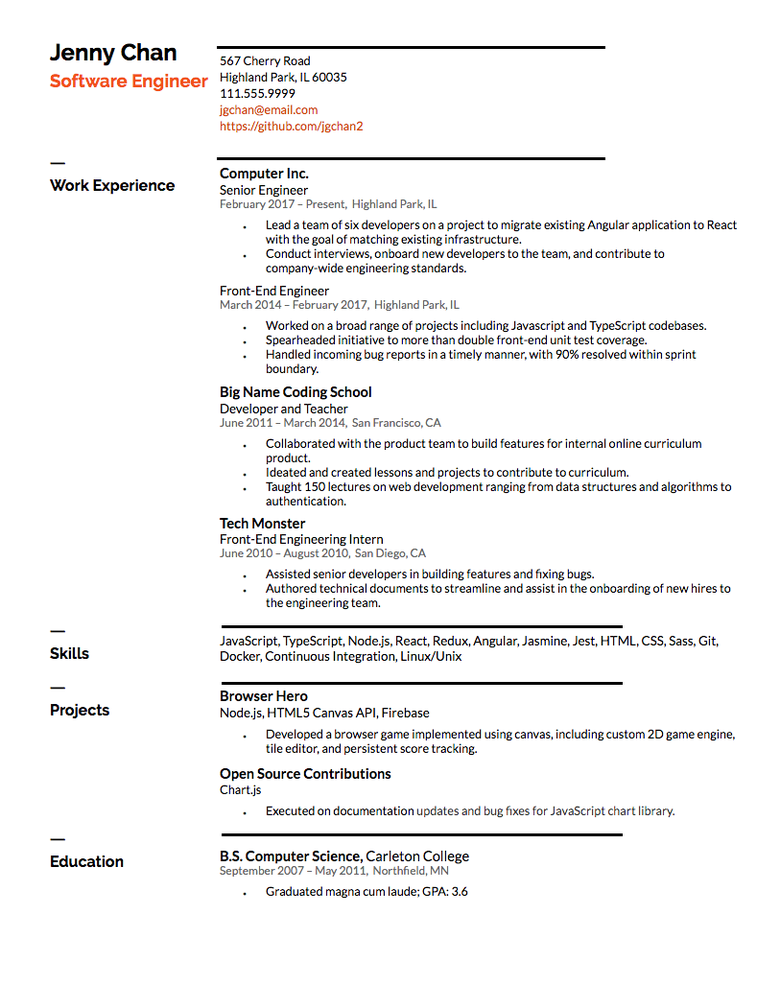
The Unorthodox Route: A Functional or Skills-Based Resume
Rather than listing out your experience in reverse chronological order, a functional or skills-based resume has bullet points that reflect how each of your skills is demonstrated by the work you’ve done over the course of your career. At the bottom, you’ll include everything else, such as your education, job history, professional achievements, community involvement, and other technical skills. This is a good option if you have a somewhat all-over-the-place work history and want to tie everything together neatly.
Who it’s good for: Career changers whose work experiences may not appear to be relevant and people with an abundance of temporary jobs or gaps in their work histories.
Download an Example Functional Resume for a Project Manager
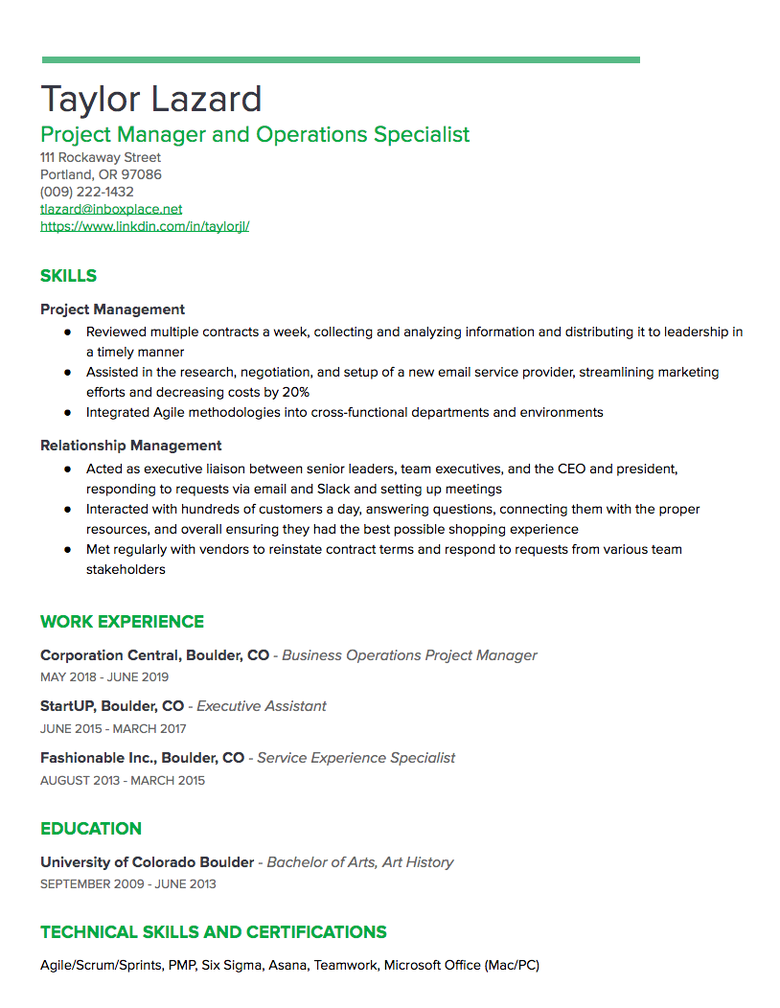
The Creative Angle: An Infographic Resume or Resume Website
This resume type is characterized by how it’s formatted visually. You may choose a reverse chronological order or skills-based style to organize your information, but also use graphics, colors, unique fonts, and even multimedia elements to help that information pop. Keep in mind that any creative resume is still likely subject to an ATS—and certain elements may be unreadable by a robot. So consider going this route only if you know a human will be reading your resume (and that said human might enjoy it).
Who it’s good for: People applying to creative roles (designers, editors, writers, marketers, video producers, for example), startups, or fun companies, or to jobs where a creative resume is encouraged, if not required.
Download an Example Infographic Resume for a Designer
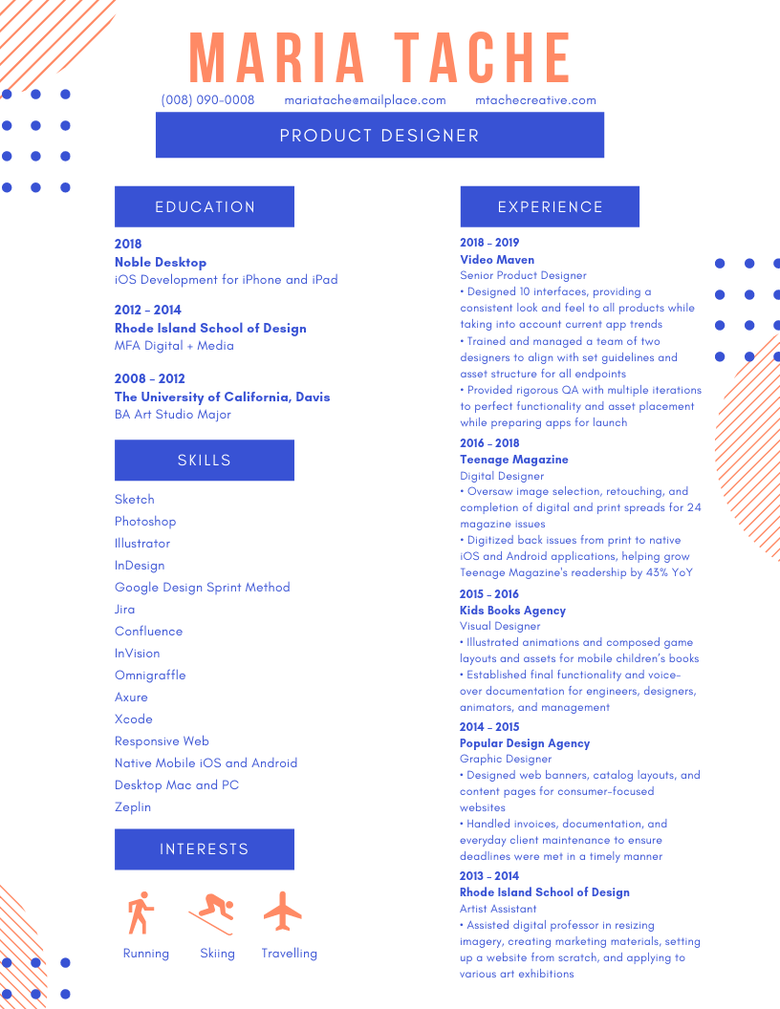
Not a designer but want your resume to look just as pretty as this example? Check out these articles:
- 5 Sites to Create an Awesome Infographic Resume (Even if You’re the Least Creative Person Ever)
- How to Build a Resume Website That Will Impress Every Hiring Manager Who Sees It
- 5 Digital Tools That Will Make Your Resume Infinitely More Beautiful
Your resume is a living, breathing document. So while you won’t go through this whole process every time you apply for a job, you should be thinking about all these things as you go to update your resume for your next career step. You might decide later on to switch up the order, or remove or add things, or even get creative and try out a whole new format. If you’re not getting the calls back you expect, you may decide to scrap it and start over —and that’s totally OK.
Regardless of where this piece of paper goes and how it grows, when you give it the care and attention it deserves, you set yourself up for success. And you’ll make it that much more likely that you’ll land an interview and get the chance to prove to the hiring manager—over the phone or in person—what you’ve got to offer.
How to Write The Perfect Resume in 2024 (With Examples)
The ultimate guide to learn how to quickly create a resume utilizing best practices to help you land your next job.

Introduction to writing a resume
We’ve all been there. You’re ready to apply for a new job or looking for a career change, and you haven’t updated your resume in quite some time. Or it’s your first job, and you’re not sure where to start. Resumes are a standard part of the job application process. Not having one - a good one - makes it very difficult to near impossible to land your dream job.
Unless you have some incredible connections that can help you bypass the interview stage, which is pretty rare, we highly recommend you give your resume a second look (or first!).
Beautiful resume templates to land your dream job

Why do you need a good resume?
Your resume is a way for you to market yourself and promote your career experience. Creating a resume lets hiring managers see how you'll bring value to their company.
It's important to know that your resume doesn't need to present all there is to know about you. It should summarize the most important aspects of your professional experience. As well as your education, interests and activities - when applicable. We recommend you tailor your resume to the position you're seeking. This means highlighting specific accomplishments and skills to the job you're applying for.
In this guide, we'll walk you through the following sections to help you craft the perfect resume:
- Understanding the basics of creating a resume
- Breaking down the resume layout and formats
- Maximizing information on your resume to provide the most value
What tools should you use to build your resume?
Tip: Use an online resume builder . Don't use Microsoft Word. Always use an online resume builder. You'll never have to worry about finding files and you can export your resume as a PDF.
So you’re ready to get started on your resume. The most obvious of choices is to open up Microsoft Word, create a new document and get writing. If you haven’t already done this before, formatting in Microsoft Word is a painful experience.
You'll end up with an ugly resume template that has poor legibility and incorrect margins. Or due to the lack of design options, you’ll end up with a resume that looks standard and boring. In both cases, the chances of potential employers overlooking your resume are pretty high!
Crazy isn’t it? You've spent years building job experience but have to use Microsoft Word to tell that story. And if you can’t navigate around complicated tools, it'll lead to poor results. You might miss the opportunity to land your dream job. That doesn’t sound fair, and it isn’t.
Why should you use a resume builder?
Luckily, there are other options that exist. We’ve created the fastest and easiest resume builder available online. With a variety of pre-existing templates that are professional and field-tested. And there’s no messing around with font sizes, margins or colors. We’ve taken care of all that for you.
The benefits of using an online resume builder like the one we’ve created are much higher. Here are some of the top reasons to use a resume builder:
- Hosting your resume online (in the cloud)
- This means you can access your resume at any time and anywhere. Your resume will always be available through our website. You'll never worry about having the right computer programs installed. Or finding files on a messy desktop.
- Creating unlimited resumes at no cost
- We manage it for you and make finding your resumes super easy, so you never have to worry about things getting lost. Go ahead and create unlimited versions of your resumes!
- High-quality resume designs
- This is where we specialize. Our design team has tested the exact elements required for perfecting resume templates. We sweat the details so you never have to. We’ve spent countless hours choosing the most appropriate font and color combinations. Including ones that pass the stress tests of relentless Applicant Tracking Systems (ATS).
The other benefits of using Easy Resume’s online resume builder are:
- Download your resume as a PDF. We recommend this file format so your resume always looks consistent.
- Share a direct link to your resume. We’ll even host it for you at no cost.
- Get exclusive access to guides, tutorials, and tips from career and industry professionals.
Understanding the 3 types of resume formats
Let’s break down the different types of resumes that employers generally look for.
- Reverse Chronological
- Combination
Tip: When in doubt, use a reverse chronological resume format. - About 95% of resumes use the reverse chronological format. Hiring managers are used to this as it lets employers see how your career has progressed.
1. Reverse Chronological Format
The most common is the Reverse Chronological format. It’s the most used and formatted to tell the story of your work experience in a chronological way. Employers prefer this format, as it gives them a historical overview of your career. Including the different job titles and responsibilities that you’ve had.
When should you use a reverse chronological resume template?
- You have had a lot of prior work experience. This means either the number of jobs or the amount of work experience you’ve had.
- You want to show how your career has progressed. For example, if you started as an associate and worked your way up to a senior-level position. The reverse-chronological format is a great way of showing your progression.
What if you have gaps between your work experience?
This is a very common question that we often receive. It’s usually in the form of:
“I’ve been out of work for 6-7 years after a certain life situation (i.e. having kids). The last job I had was in 2012, but recently I'm starting to apply for jobs again in 2019. What’s the right resume format for someone like me?”
First of all, no worries. This is a very common situation and happens with many people. As a hiring manager, having a gap like this can lead to questions and uncertainty about your resume. Which is why we recommend that you use a combination format.
2. Functional Format
The second type of resume format is the Functional or Skills-Based resume. This can be common for students and recent graduates starting to apply for their first job.
When should you use a functional / skills-based resume template?
- You’re a student or recent graduate applying for jobs for the first time with no prior work experience.
- You’re looking to make a career change.
Reasons why this is common for students and recent grads is due to their lack of prior experience. Given the fact that they’re starting to enter the workforce and apply for their first job. It’s well understood amongst employers that students won’t have a huge depth of work experience. There are other ways to let them know what you can help bring to the role you’re applying for by showcase the list of skills that you excel at.
It usually depends on the role you’re applying for. But there are some common ones that you can try to focus on like: Communication, Organization, Customer Driven, Effective Listener, Teamwork, etc.
What else can you add to your resume besides skills?
We recommend adding some extra activities for your career. Even if you haven’t attained any professional work experience yet. The few ways you can do that as a student is:
- Find internships
- Help volunteer at student-led or non-profit organizations
- Participate in extracurricular activities
- Take on side-projects
Not only will you have more examples of experience to show on your resume. You can show employers how much initiative and leadership you’ve performed on your own. This helps you stand out much better than a candidate who only lists generic skills.
For example, instead of only listing skills like:
- Communication
- Collaborative
An employer might prefer to move forward with a resume that looks like this:
- Summer Intern at XYZ
- Volunteered for non-profit at XYZ
- Ran student organization for XYZ
What if you’re unable to get any kind of experience?
Fear not, your chances towards landing your first job can still be within grasp. We recommend taking an approach that explains the skills you’ve acquired. And how you’ve applied them in real-world settings.
Here’s an example of adding depth to your skill sets:
- Demonstrated effective teamwork and leadership in various class projects by taking the initiative to organize group’s goals, objectives, and tasks.
- Received consistent praise and admiration from course professors and team members as being highly collaborative, an effective communicator and group leader with clear presentation skills and abilities.
- Organization
- Meticulous about even the smallest of details. Always taking the extra effort towards making sure that filenames, folder hierarchy and labeling are descriptive, versioned, tagged and easily discoverable.
- Received constant praise from past and present team members who were able to jump into any collaborative project and accurately trace back previous versions to see how decisions were made.
Do you see how this can be more effective than listing out a set of skills? Taking this approach will let employers know that you’re not only listing skills. But have also demonstrated how you were able to apply these skills and put them into action.
3. Combination Format
The final type of resume that we mentioned earlier is the Combination or Hybrid format. This combines concepts from both reverse chronological and functional/skills-based formats.
We recommend this format for jobs that expect relevant experience and technical skills. An example might be a Graphic Designer who has experience working in design agencies. As well as necessary skills like Branding, Sketching, Illustration, and Adobe Creative Suite.
Take a look at our in-depth guide on how to select the right resume format .

Choosing the best resume template
Now that we know which software to use and the most common resume formats, let’s break down the actual template. This is the make-or-break deal. Picking the right resume template can be the deciding factor if a hiring manager gives you a call. Or if they skip past your resume and never bother to read it.
Our mission here at Easy Resume is to make sure that never happens to you! We’re working hard to make sure your resume is high quality and presented in a way that will impress recruiters.
When speaking with hiring managers, we found that 78% of the time they skip your resume is because of the design. Again, we don’t think that’s fair.
Here’s a checklist to use for your resume
We always use this checklist whenever creating any new resume template.
Use a clear heading structure
Incorrect : Don’t make all headings and body copy the same size.
Correct: Do use typographic hierarchy by using varying heading sizes and font weights.
Use legible, friendly and professional font combinations
Incorrect : Don’t use quirky and eccentric fonts like comic sans or papyrus.
Correct : Do use professional fonts that are easy to read and familiar. Fonts like Georgia, Helvetica, Calibri, and Cambia.
Use an ample amount of spacing
Incorrect : Don’t go overboard with spacing. Using a lot of white-space might spark joy, but not when your resume becomes three pages long because of it.
Correct: Do keep your margins tight but spaced even enough that your text isn’t hugging the borders of the page.
Incorrect : Don’t try to write your entire life story with every single job responsibility you’ve ever had. Recruiters on average spend about 7-8 seconds skimming through resumes. If it's two pages, the chances of them not spending even more than 2-3 seconds reading the second page is pretty low.
Correct: Do keep your information brief, relevant, and clear. If you REALLY need another page, make sure it’s valuable information. Otherwise, choose the right template that can fit the most words on a single page.
Use bullet points
Incorrect : Don’t write very long paragraphs about your work experience. Remember, your resume is a summary and a brief overview of your career. Your resume is not an autobiography of everything you’ve ever done.
Correct: Do use 3-4 bullet points to briefly describe your responsibilities. Feel free to add more bullet points if you have worked at only one or two jobs to fill up some more space.
Overview for writing a resume
Whew, that was a lot of information. Let's quickly summarize what we've learned.
1) Always use an online resume builder, instead of Microsoft Word
- It’s always better to use an online tool instead of Microsoft Word.
- Creating a resume template on Easy Resume will allow you to access your resume at any time. And access to unlimited resumes and a great selection of professional design templates.
2) There are 3 types of resume formats
- Reverse Chronological -This is the most common. Use it if you have a lot of work experience and want to show your career progression over the years.
- Functional - If you lack work experience, use this format to emphasize your skill set. It’s great for students or recent graduates entering the workforce for the first time.
- Combination - If you have a lot of experience and a diverse skill set that is relevant to your job, use this advanced technique. For example, a web developer who has worked at a few technology startups. And has programming skills in languages like Python, PHP, and Javascript.
3) Follow our resume design guidelines
- Utilize clear heading hierarchy, don’t make all fonts the same size. This will help your resume be easy to parse. Remember, recruiters spend an average of 6 seconds scanning your resume. Highlight the most important sections!
- Use legible fonts that are easy to read . Using professional fonts will make your resume more legible. Choose from fonts like Georgia, Calibri, Garamond, Arial, Helvetica, Cambria, Times New Roman, Verdana, Trebuchet, Gill Sans, and Tahoma
- Use white-space conservatively . If you rely too much on white-space, you might end up with a 2-3 page resume. Keep your margins tight but spaced evenly to make it easy on the eyes for the reader.
- Use 1 page . As previously mentioned, hiring managers and recruiters spend an average of 6 seconds. They might look at hundreds of resumes and applications every week. The chances of them reading every single page from top to bottom is pretty slim.
- Use limited amount of color depending on your industry. Hiring managers need to notice the right parts of your resume. Using the right amount of color on your resume can help.
- se bullet points . As previously mentioned, hiring managers and recruiters spend an average of 6 seconds. They might look at hundreds of resumes and applications every week. The chances of them reading every single page from top to bottom is pretty slim.
Resume sections and details
Let’s take a closer look at the resume itself now. Resumes are typically broken down into the common sections:
Common sections to add on your resume
Resumes tend to have some common sections that employers are used to seeing. Here's a list of what's generally expected as best practice:
- Heading / Name
- Additional Contact Info
- Your Objective
- Your Education
- York Work Experiences
- Your Skills
Of course not all people are alike. There’s no one-size-fits-all model for resumes. Depending on your job, you might want to include more unique sections. Remember any information you include on your resume should have valuable insight into your experience. Employers want to know why you would be a great hire.
Other sections to include on your resume
If you don't have enough information for the sections described above, you can try to add some of these sections below. Keep in mind that you should only add it if it's relevant to the position you're applying for.
- Volunteering
- Achievements
- Organizations
- Certificates
- Publications
As you can see, there are many sections to add depth to your resume. So don’t be alarmed if you’re lacking skills or experiences, there are other ways to let employers learn of your potential.
Tip: Only add information that’s relevant to the job you’re applying for. As a best practice, always remember that the most valuable details is the information that recruiters are specifically looking for in the job description that you’re applying to.
Let’s break down each of these sections and how to add the most value to them.
Adding contact information
Information about yourself is a critical element for your resume. It provides a brief description of who you are, where you're based and how to get in touch with you.
The most necessary contact information to add on your resume
There are quite a few ways to add your contact details, but here's what's most necessary.
- Your First & Last Name . You may use a preferred name if that's what you'd rather go by. So for example, someone named "Robert" might prefer to go by a nickname like "Bob". You may also optionally include your middle name or initial.
- Your Email Address. Your email address is necessary if employers want to be able to reach you. Email is generally the most common way that recruiters use to get in contact with applicants.
Always use a professional email address.
Incorrect : Don't use an email address that sounds like you're still in grade school. Something like [email protected] will not look professional on your resume.
Correct : If you don't already have one, create a professional email address with your name on a service like Gmail. An email like [email protected] sounds much more professional.
- Your Phone Number. Adding a phone number will let recruiters know that they can also reach you via phone call if that proves to be more convenient for them. If possible, use your work or cellphone number instead of your home number.
- Your Location. Adding your location lets employers know that you'll be able to physically make it to work. It's preferred that you list your city and state. Some people like to add their full mailing address. However, based on our research, we learned that it's not always important to add in your entire street address.
Let employers know where you're based, not your exact address.
Incorrect : Don't list your entire mailing address like 305 Main St, Apt#25. It's not always necessary. If an employer needs to know your mailing address, ask them and only provide if required.
Correct : You can simply list your city state and sometimes zip code, for example: New York, NY 10010. This will let employers know that you live and work in this geographic location. If you need a work visa or are looking to relocate, be sure to call that out.
Secondary contact information to add on your resume
- Your Website or Blog. If you have a website or a blog, feel free to add it on your resume. Having a website can add to the professionalism of your experience.
Unnecessary contact information for your resume
- Your Photo or Headshot. Adding a photo to your resume is a bit of a controversial topic. While it's not always recommended, and most ATS (Applicant Tracking Systems) will ignore it - some countries like South Korea may prefer it. However, in most cases, it's not necessary.
- Your Date of Birth. To avoid any kind of age-based discrimination, it's best to leave your birthday out of your resume.
Adding social media profiles
If you have accounts on social networks, you might want to include them depending on how relevant it is. This will let employers know that you're active and knowledgeable about commonly used platforms online.
- Linkedin is the most popular platform for networking amongst professionals. We recommend that you create a Linkedin profile if you don't already have one.
- If you use Twitter for professional reasons, adding your Twitter handle can be a good way to show off your personality and interests for topics that you like to talk about. However, if you use it purely for personal reasons, you shouldn't add it.
Tip: Only add social media profiles if they showcase your professional experience. Normally, you shouldn't add your personal social media profiles on your resume. Unless you're using social media networks like Facebook, Instagram, Pinterest to demonstrate your expertise and interests, there's no reason to include them on your resume. For example, if you're a web developer, you might want to include your Github or if you're a designer, you can include a link to your Behance portfolio.
Writing the perfect resume objective
Your resume summary or objective gives employers a very brief overview of your goal and what kind of position you're looking for. It should always be at the very top of the resume. Usually placed directly below your name and contact information. It's always important to leave a great first impression. Remember, hiring managers are spending only 6 seconds scanning your resume.
Here are the key pieces of information that your resume objective should include:
- Your Job Title = e.g. Server
- Your Experience (in years) = e.g. 10+ Years
- Your Achievements = e.g. Managed parties and events upwards of 250+ guests and maintained customer satisfaction rate above 98%
- Your Desired Goal = e.g. Looking for new opportunities to bring expertise to fine-dining establishments
- Your Desired Goal (Personalized) = e.g. Looking to gain new skills and further develop fine-dining expertise at an upscale establishment like Janes Riverside Restaurant
Personalizing your resume objective to the specific company you're applying for can be a great way to make a first impression. We highly recommend tailoring each resume objective to the specific job and company you're applying to.
Follow these tips to write a great resume objective
This checklist will help summarize your experience into a resume objective that leaves a good first impression.
Avoid writing your resume objective in first person.
Incorrect : I am a server and have lots of experience working in various restaurants. I love working with customers.
Correct : Dynamic and engaged server with over 10+ years of experience who loves to provide warm and friendly customer service.
Quantify your achievements.
Incorrect : I worked many catering events and parties, and provided good customer service.
Correct : Managed parties and events upwards of 250+ guests and maintained customer satisfaction rate above 98%.
Be clear about your desired goal.
Incorrect : I'm looking for a new job to get better at managing people and stores.
Correct : Looking for new opportunities to further develop hospitality and personnel management experience at fine-dining restaurants.
Putting all this together, a bad example of a resume objective might be the following:
Bad example of a Registered Nurse's objective
I am an experienced registered nurse, that has worked at large hospitals with experience taking care of patients and providing medical expertise. I'm looking for a position to help grow my nursing career.
Let's turn that into a better example of a resume objective, based on our guidelines:
Good example of a Registered Nurse's objective
Experienced and veteran RN with 12+ years of experience taking care of patient health. Skilled in providing high quality patient care in ER situations under intense pressure. Hired and trained a staff of 27 nurses and nurse assistants. Looking for a new role to bring empathetic care to the patients at Lincoln Hospital.
Take a look at our guide on how to write a killer resume summary or resume objective to learn more.

Summarizing your job experience
Your resume experience section is the most important aspect of your entire resume. It's a summary of your career experience and progression that outlines your responsibilities and achievements.
This is the section that you'll most likely spend most of your time on. It's good practice to make sure you consistently jot down any new experiences you've had, even if you're not looking for a job.
For example, if you recently landed a $200,000 deal by bringing on a new client at your firm, write that down somewhere you can remember. Over time, you'll have dozens of bullet points you can copy over to your resume when you are ready for a new job.
Here's a simple example of work experience
Server, red lobster.
November 2018 - Present • New York, NY
- Greeted incoming guests and directed them to comfortable seating.
- Memorized and informed guests of daily menu specials.
- Made recommendations about food and beverages as well as other services provided by the restaurant.
- Provided exceptional and friendly customer service by taking food and beverage orders and entering them in our PoS system.
- Job Title = e.g. Server
- Company Name = e.g. Red Lobster
- Start & End Dates = e.g. November 2018 - Present
- Location = e.g. New York, NY
- Responsibilities & Tasks = e.g. Made recommendations and answered questions about our food, beverages and other restaurant functions and services.
This is a simple example, but it can be improved by adding more detail.
Follow these guidelines to really maximize your career experience
These principles will make your resume look more professional, relevant and attractive to hiring managers. This is where most job-seekers have the toughest time when writing their resume.
We highly recommend emphasizing your experience section with these guidelines:
- Focus on achievements and outcomes. Instead of just writing about all of the tasks you did. Try your best to quantify some of the most key and impactful achievements you've made at the company. Using actionable verbs can help.
- Use keywords from the job description. If you're applying to multiple jobs, make sure you tailor each resume to the job description . A great way to tailor your resume is to use keywords from the job description itself. Not only will this feel more relevant to recruiters, but it significantly increases the chances of your resume passing an ATS which scans for common keywords.
- List only key responsibilities. Your experience section isn't meant to be a huge list of every single task you've ever done. Try to narrow your responsibilities to the ones that most relevant ones.
Here's a better example of work experience
- Implemented Happy Hour pre-dinner special that drove an extra $7,500 in weekly revenue.
- Trained and onboarded 6 servers to help increase waitstaff.
- Promoted to Team Lead after receiving exceptional feedback from repeat customers.
- Made food recommendations to customers that helped increase ordering by up to 15% for select items.
Adding skills to your resume
Showcasing skills on your resume lets employers understand the variety of your strengths. While skill sets can vary, the best approach is to use keywords from the job description to show how your skills are relevant.
In general, there are two types of skills you should consider adding to your resume.
- Soft or Transferable Skills
- Hard or Technical Skills
What are soft skills?
Soft skills (sometimes known as "transferable skills") are self-developed skills that will be valuable to employers to many different types of jobs. Some examples of these include communication, teamwork, organization and leadership. Listing soft skills is recommended if you're thinking about a career change where your skills would serve both industries.
For example, there might be a job that requires candidates to be very strong in teamwork skills. If you’ve worked in team settings, and enjoy collaborating with other group members, this is a skill that you might want to call out.
Here's a list of common soft skills:
- Taking Initiative
- Problem Solving
- Attention to Detail
- Collaboration
- Time Management
- Critical Thinking
- Decision Making
- Presentation
- Facilitation
What are hard skills?
Hard skills (also known as "technical skills") are specific skills that are learned to perform a certain task or master a craft. These skills are often completed during your job, and sometimes require specific education or training to learn and master. For example, some technical skills can include computers or hardware for jobs like a Web Developer or an IT person.
Adding technical skills to your resume will let employers know how you can solve different challenges using these skills you've acquired. We recommend using your career experience, as described above, to show real examples of how you applied your hard skills at your job. Make sure to keep them relevant to the job you're applying for.
Here's a list of hard skills for specific roles:
Web Developer
- Ruby on Rails
- HTML & CSS
- Cross Browser Testing
Graphic Designer
- Adobe Photoshop
- Adobe InDesign
- Adobe Illustrator
- Wireframing
Data Analyst
- Database Management
- Google Analytics
- Microsoft Excel
We have come up with a list of over 100 skills that you can include on your resume .

Listing your education
The education section of your resume is an important call-out for showing your school experience and the degree(s) you've received. It's important that the education section of your resume is relevant to fit the position you're applying for.
Here's an example of the information you should add for your education.
- School / University Name = e.g. Harvard University
- Degree & Major = e.g. B.F.A in Arts & Literature
- Minor = e.g. Minor in Spanish
- Years Attended = e.g. Fall 2004 to Spring 2008
- GPA ( optional ) = e.g. 3.8/4.0 GPA
- Honors ( optional ) = e.g. Magna Cum Laude
The most important information to include is your degree (multiple if you have more than one), the schools you attended and during which dates. If relevant, providing more specific pieces of information like your major and minor can also help.
Tip: Always be truthful on your resume. It's not worth lying on your resume. Employers will quickly find out whether you're telling the truth or lying during an interview if they ask specific questions that you are unable to answer. Same goes for your Education. Employers can request a transcript to verify that your school information is correct.
You'll notice we also added GPA and Honors as optional. For GPA, it's not necessary nor required, and should be generally avoided unless you have a high GPA (greater than 3.8). Adding honors and achievements is also likely to be ignored by recruiters. Only add it if you have plenty of extra space on your resume. Otherwise save that space for more important and relevant information.
Additional sections for your resume
Now that we've learned about the most important sections to add on your resume, let's explore some other ways to demonstrate your full potential to future employers.
Remember, there's no one-size-fits-all model. Every person, every situation and every job is different. Your resume should be tailored based on a variety of these circumstances.
Here are some sections you can include on your resume:
Keep in mind, that you should only add these sections if 1) you have extra space or 2) it's very relevant to the job you're applying for.
- Hobbies & Interests. This is a great way to show off your individual personality. Employers often care about maintaining company culture. Showcasing your different hobbies and interests can be a great way for them to get to know you, before even meeting you! Our advice on how to include hobbies on your resumes will be helpful.
- Languages. Do you speak multiple languages? This is a skill that can become useful, even if it isn't required for the job. When listing languages, you may also write a proficiency level (native, fluent, basic) to show how skilled you are at communicating in that language.
- Volunteering Experience. If you spend time volunteering at different organizations, this can demonstrate to future employers that you're mission-driven and passionate about solving problems for others. If you're a student, acquiring volunteer experience can be a great way to substitute (with real impact!) for any lack of work experience.
- Certifications & Awards. Have you received any certifications and awards that celebrates achievements you've made in your career? If it's relevant to the job you're applying to, then this could be a great way to level up your expertise and skills. Take a look at our guide on including achievements and awards on your resume as well as including certifications on your resumes.
Browse more resume templates that fit your role

Get inspired with more resume examples
Read our how-to guides on making your resume perfect, how to correctly list certifications on a resume in 2024 (with examples).
Follow our step-by-step guide and resume examples to learn how to correctly include certifications on your resume. Make your candidacy stand out and land the interview.
How to Write Your Resume in Reverse-Chronological Order
When setting out to write the perfect resume, choosing a format is an important decision. Reverse-chronological resumes are the standard format, so knowing how to craft one is key! This guide will teach you how to write the best reverse chronological resumes.
How to Describe Work Experience on a Resume in 2024 (Examples & Tips)
Your work experience is a summary of all your hard work, dedication and achievements over the years. Here's how to do justice to your work history.
How to Write a Resume with No Work Experience in 2024 (With Examples)
Don't worry, we've all been there. Thrown into the job world with little to none work experience and no idea how to start a resume. We're here to help.
More advice that will accelerate your career path
How to create a resume in microsoft word (step-by-step guide).
If this is your first time creating a resume in Microsoft Word, the process may seem overwhelming. Luckily, this article is here to help! In this step-by-step guide, we will cover how to create an effective resume from start to finish using Microsoft Word.
Should I Include a Photo on My Resume in 2024? (Tips & Examples)
To include or not to include (a profile photo or a selfie) — that is the question.
20+ Key Marketing Skills to List on Your Resume in 2024 (With Examples)
Being a marketer requires you to have many skills and proficiencies. In this guide, we will provide you with 20 of the best marketing skills to include on a resume. Plus, we will cover formatting and how to improve your marketing skills!
350+ Action Verbs to Make Your Resume More Effective in 2024
Bring your resume and work experience to life by making it more actionable using these powerful verbs.
Professional resume templates to help land your next dream job.
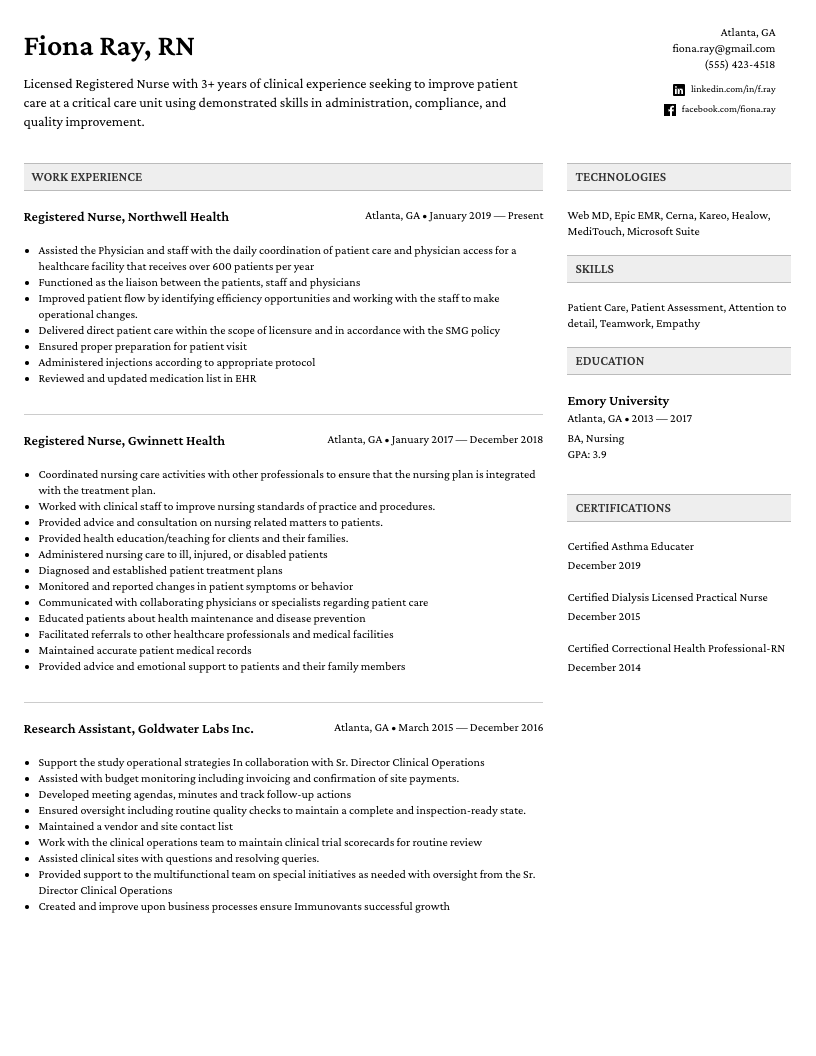
Facebook • Twitter • Linkedin • Pinterest • Crunchbase

The Best Online Resume Builder
Easily create the perfect resume for any job using our best-in-class resume builder platform.
more interviews
more likely to get a job offer
Our online resume builder offers a quick and easy way to create your professional resume from 25+ design templates. Create a resume using our AI resume builder feature, plus take advantage of expert suggestions and customizable modern and professional resume templates. Free users have access to our easy-to-use tool and TXT file downloads.
Pick one of many world-class templates and build your resume in minutes
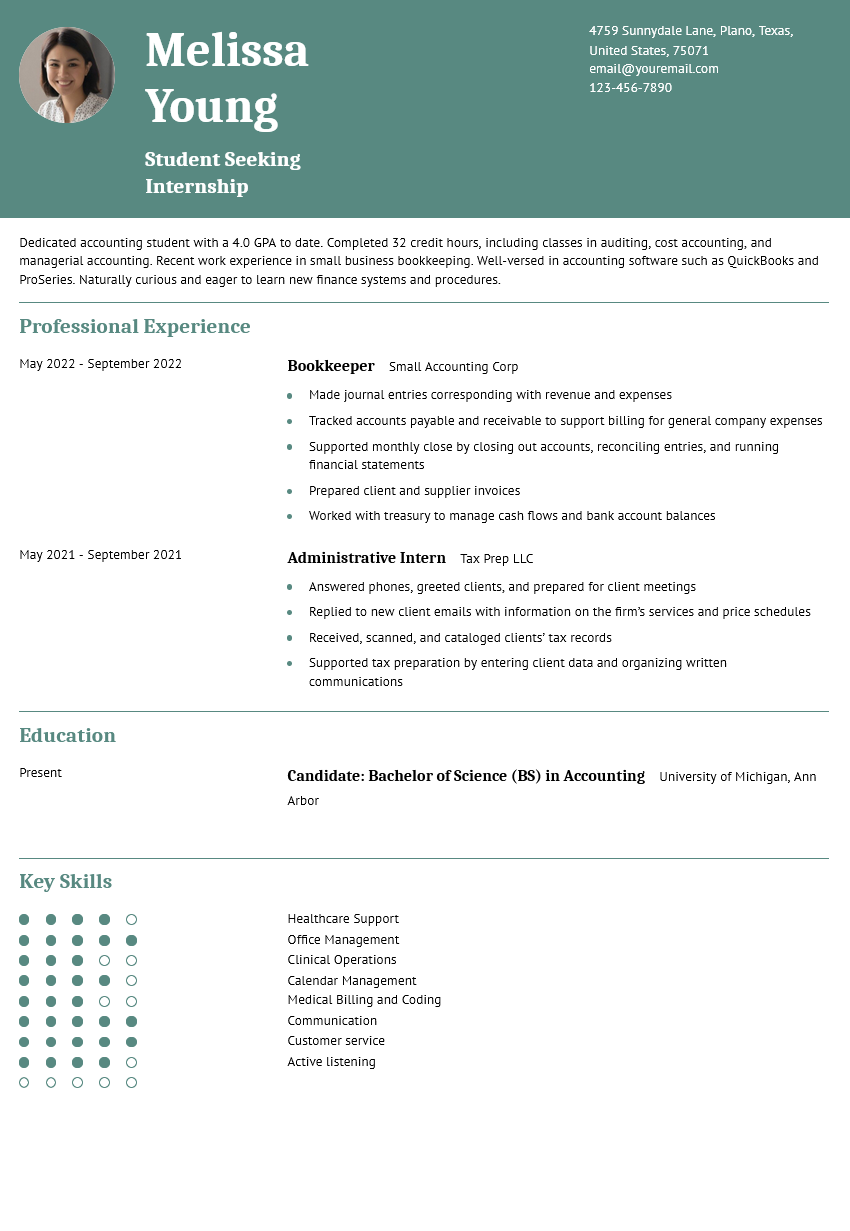
Get hired 36% faster with our feature-packed and easy-to-use resume builder app
ResumeBuilder.com is now part of Bold LLC. For more information visit our Terms of Use and Privacy Policy .
Use our potent creation tools and expert guidance to create the perfect resume for your next job application.
Choose from 25+ applicant tracking systems (ATS)-friendly modern and professional templates.
Select custom fonts and colors on any resume template.
Use our more than 500 resume examples and templates to see what a great resume looks like in your field.
Sail through applicant tracking systems with resume templates that appeal to both machines and humans.
Get help every step of the way as you build your resume with expert tips and suggested phrases.
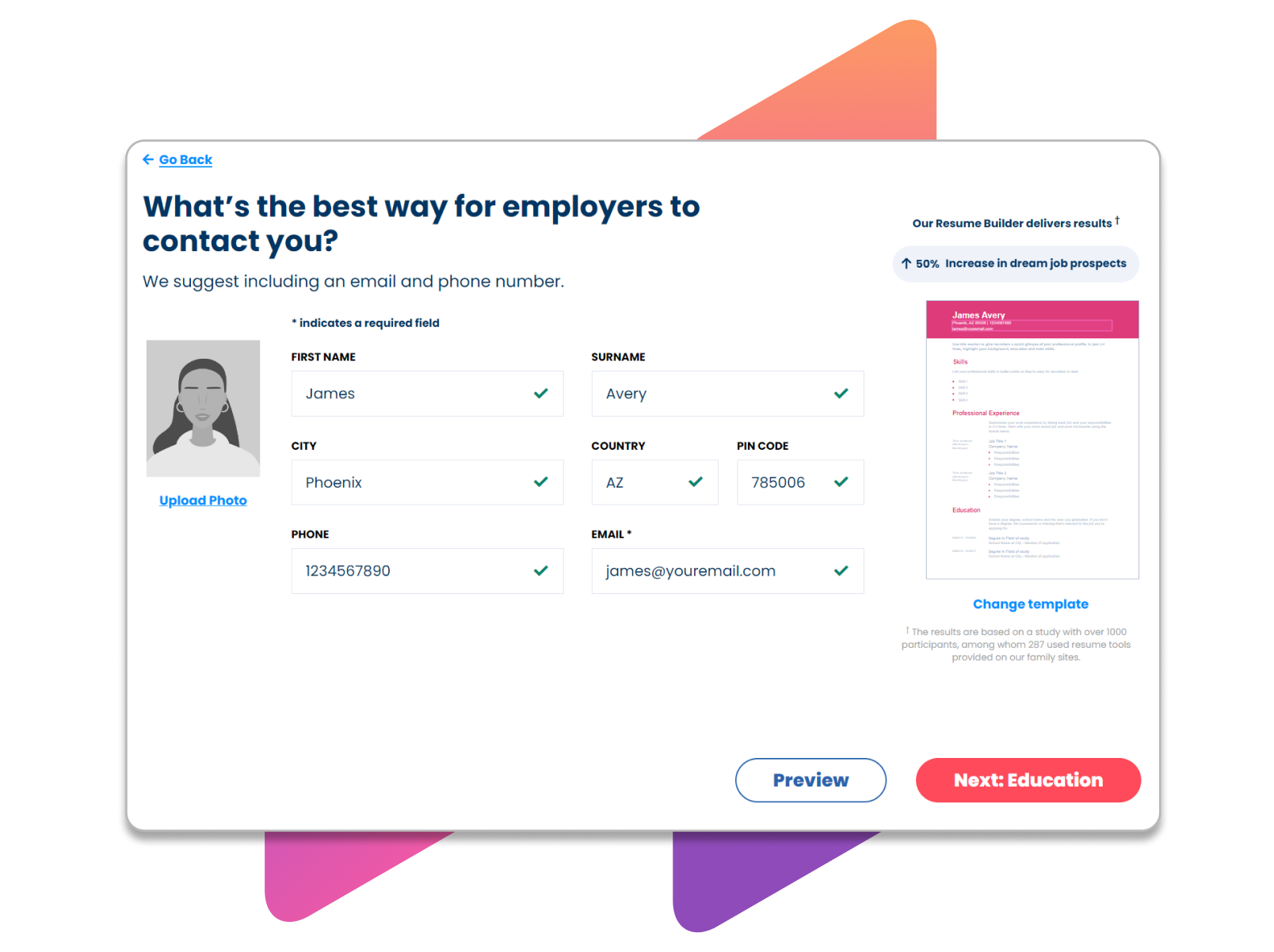
Powerful AI Resume Tool
Find the right words and automate your resume writing process with Resume Builder’s free AI resume writer. Just enter a job title or phrase, and our AI will provide suggestions that show employers you’re the best fit.
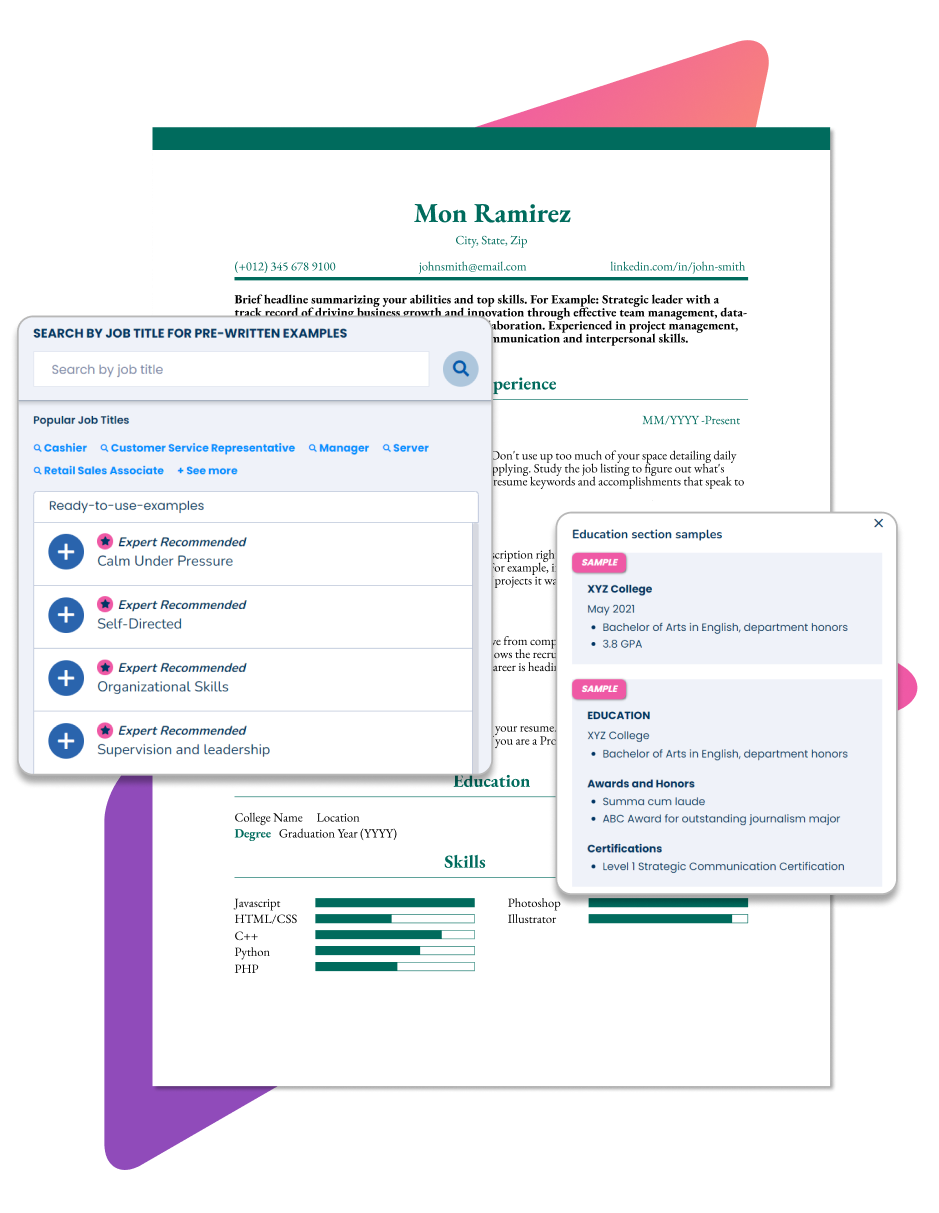
Expert Tips and Suggestions
Use Suggested Phrases to get job-specific phrases from certified resume writers that help you plug in job descriptions, career summaries, and more.
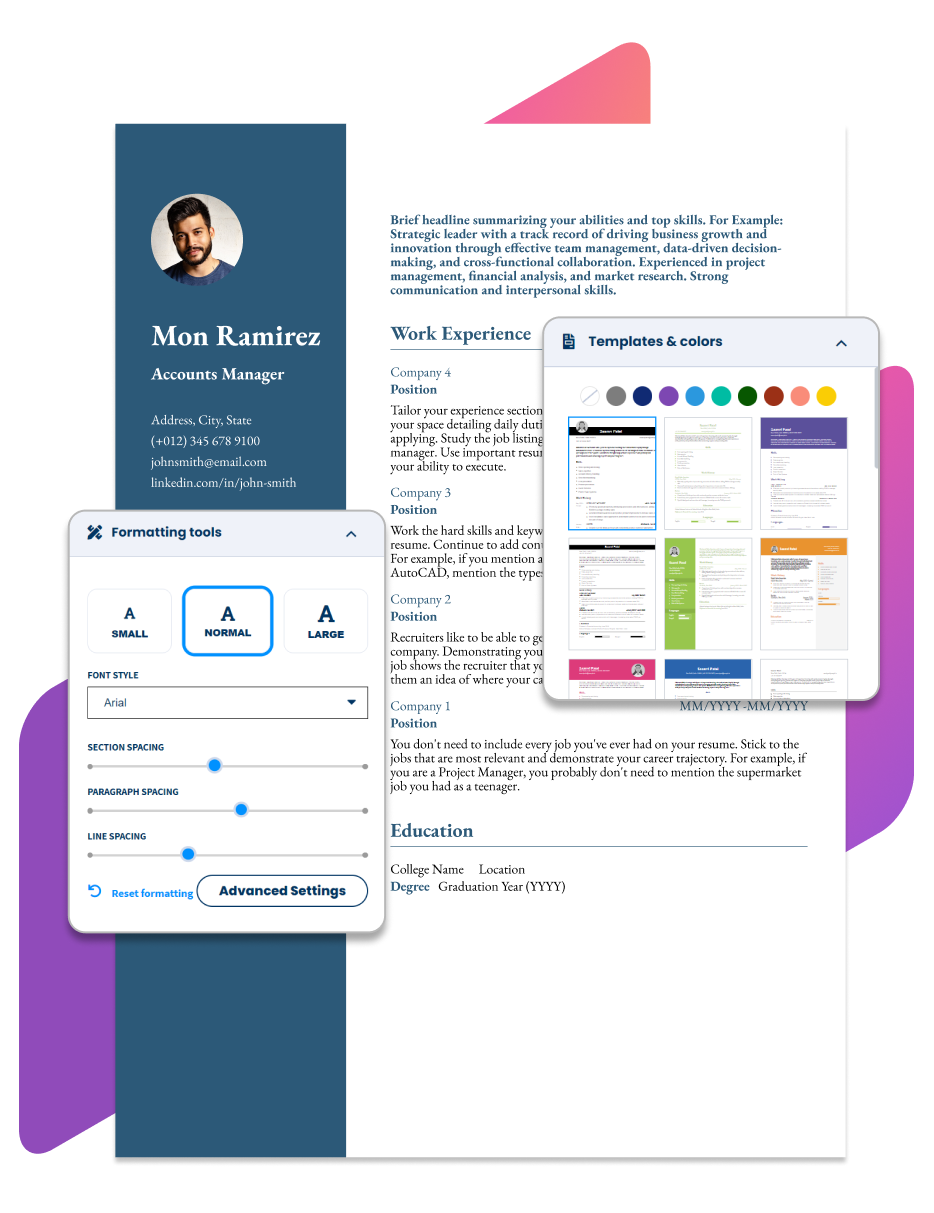
Customize Your Resume
You can change the font styles, colors, and layout of your resume to stand out from the competition.
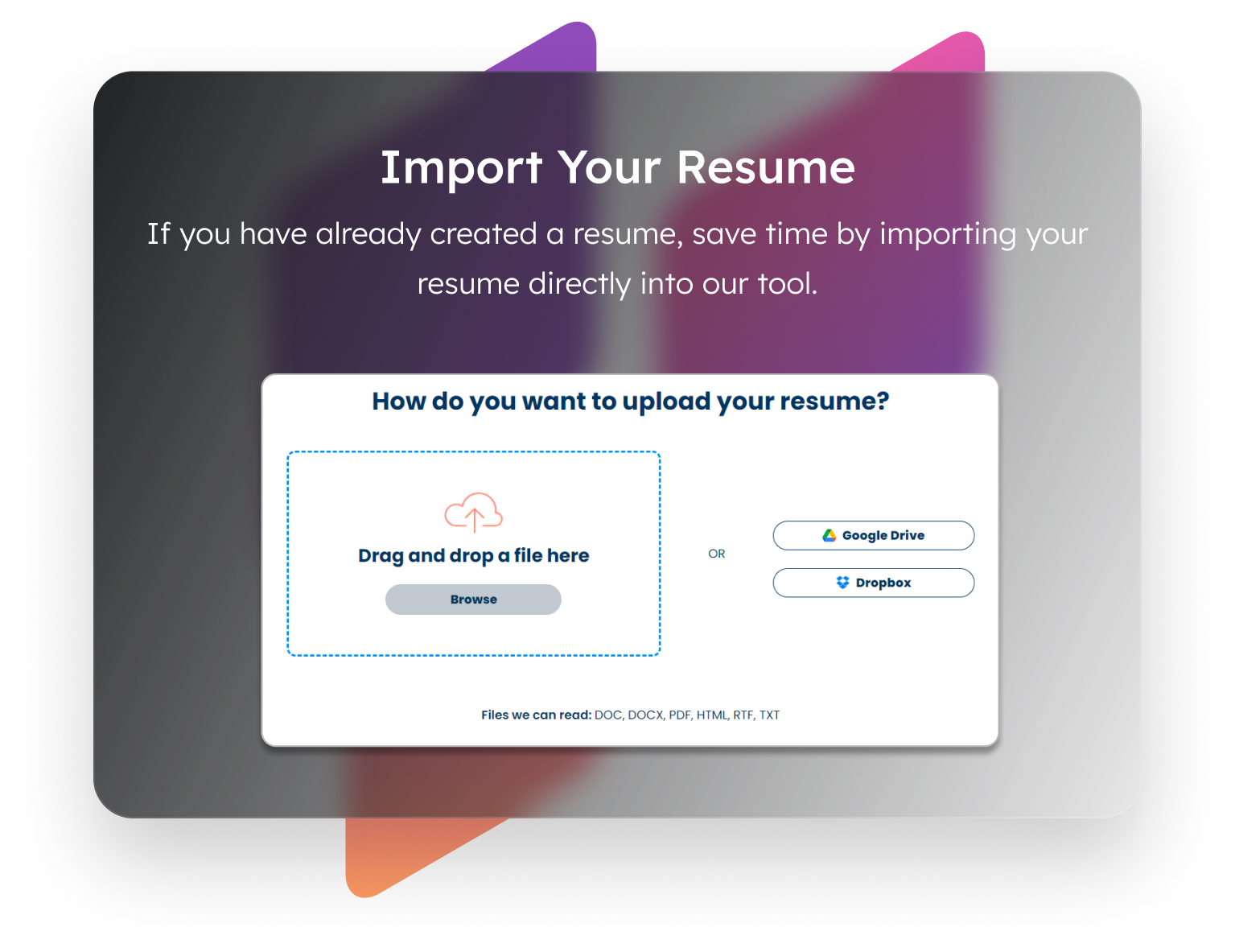
Import Your Resume
Create your resume from scratch, or you can start by uploading your own resume.
Get inspired by expertly crafted resume examples
- Engineering
- High School
- Medical Assistant
- Customer Service
- Information Technology
- New Grad Nursing
- Nursing Student
- Project Manager
- Software Developer
- Sales Associate
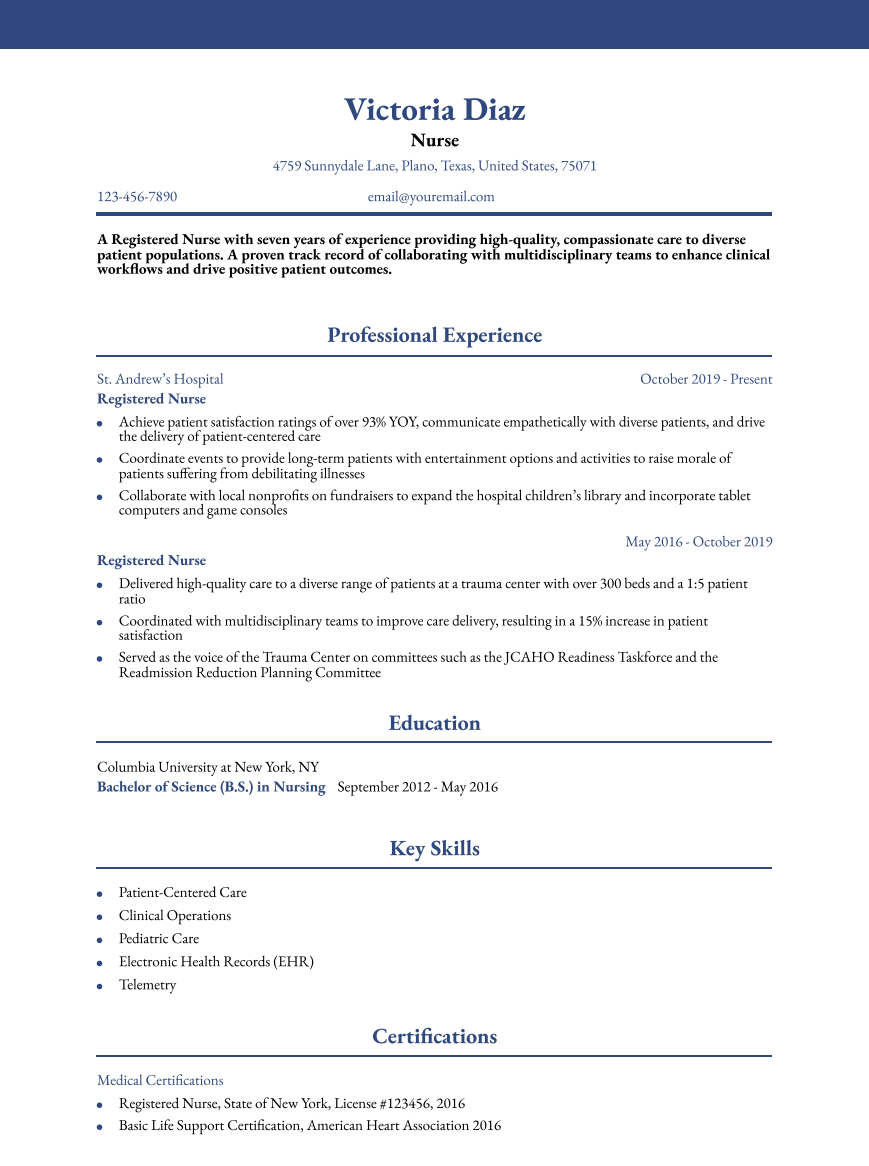
What users say about Resume Builder
Let’s land your dream job together, frequently asked questions about resume builder.
Using the Resume Builder app, you have a 30% higher chance of getting a job, and our users experience a 42% higher response rate from recruiters. You’ll get expert guidance every step of the way, with 25+ professional resume templates and AI-enabled suggestions to write a resume that gets results.
With Resume Builder, you’ll select and customize a template, then create your resume either with step-by-step guidance or by importing your current resume. You’ll add your experience, education, key skills, and more, aided by expert tips, suggested phrases, and an AI writer tool. Then, save your resume by creating a free account . You can download your TXT resume or upgrade to a paid subscription to download your professionally designed PDF resume.
Yes. Tailoring your resume is one of the best ways to get more interviews. Look at the job posting to identify what the employer is seeking. Specifically, find important words or phrases to use in your profile and key skills sections.
Yes. Resume Builder has more than 500 free resume examples and templates . Use these examples to get expert advice on what you should - and shouldn't - include in your resume, such as common key skills and action verbs for your desired job.
Our AI resume builder uses AI writing tools to help you go from a blank page to a first draft and can give you plenty of ideas for more content to include. It can help you turn a prompt like “Spanish” into “Taught Spanish language and culture classes to students of all ages and abilities” in one click. It also helps you add the right keywords so your resume performs well on applicant tracking systems (ATS).
Our AI resume builder follows best practices for resume phrasing, tone, and verb tense, ensuring you sound appropriate and professional. Using this feature gives you a better sense of that language style, so you can more easily add information to your resume later on.
We recommend downloading your resume in both PDF and text format. A professionally designed PDF resume has a visual impact, and its appearance is consistent across computer screens and systems. But you may need a text format resume for some job applications, so it's good to have both available.
With the Resume Builder app, it’s free to build, save, and download your resume in text format. With a paid subscription, you can download your resume as a PDF. Learn more about how to use Resume Builder for free .
Resume Builder offers numerous resume creation solutions for your career needs for only $2.95 during the 14-day trial period. Our application infuses AI-powered technology and writing methodologies from certified resume writers to help you build and customize your resume and cover letter.
Below, you’ll find our pricing options:
|
|
|
| : Unlimited access to all features, download your completed resume as a text-only (TXT) file | Free |
| : Unlimited access to all features, download your completed resume as a Word or PDF file | $2.95 for 14-days, then $23.95 billed every four weeks |
| : Unlimited access to all features, download your completed resume as a Word or PDF file | $7.95 ($95.40 annual billing) |
With Resume Builder’s cover letter app , you’ll select and customize a template, then create your cover letter either with step-by-step guidance or by importing info from a resume document. You’ll add your experience, education, key skills, and more, aided by expert tips, suggested phrases, and an AI writer tool. Then, save your cover letter by creating a free account. You can download your cover letter by upgrading to a paid subscription.
Yes. Tailoring your cover letter and resume is one of the best ways to get more interviews. Look at the job posting to identify what the employer is seeking. Specifically, find important words or phrases to use in your profile and key skills sections. You can get inspiration from Resume Builder's cover letter examples to get expert advice on what you should - and shouldn't - include in your cover letter, such as common key skills and action verbs for your desired job.
We recommend downloading your cover letter in both PDF and text format. A professionally designed PDF cover letter has a visual impact, and its appearance is consistent across computer screens and systems. But you may need a text format cover letter for some job applications, so it's good to have both available.
If you can’t log into your account from the log in page , please try performing one or more of the following:
- If you see an “email does not exist” error message, your email address is not located in our database. Please try using a different email address that might be associated with your account or sign up for an account.
- If you see a “Invalid Email/Password” error message, you may have entered an incorrect password. Please try again or reset your password (see instructions below).
- Clear your browser cache.
- Close all browsers and restart your PC.
- Visit the log-in page using a private or incognito window in your browser.
- Disable your browser extensions, close your browser, and reopen it to the login page.
Please contact us if you continue to have issues logging into your account.
To change your ResumeBuilder.com account password, please do the following steps:
- Go to the Resume Builder app login page .
- Click the Forgot Password? link under the blue Log In button.
- Enter the email address associated with your ResumeBuilder.com account.
- Click Reset Password.
- You will receive an email at the address you provided. Follow the instructions in the email to finish resetting your password.
Please contact us if you continue to have issues resetting your password.
Our customer service representatives are available 24 hours a day. Representatives can help with any technical difficulties, questions about your account, or any other questions you may have. See our contact info to get in touch.
*The names and logos of the companies referred to above are all trademarks of their respective holders. Unless specifically stated otherwise, such references are not intended to imply any affiliation or association with ResumeBuilder.com.
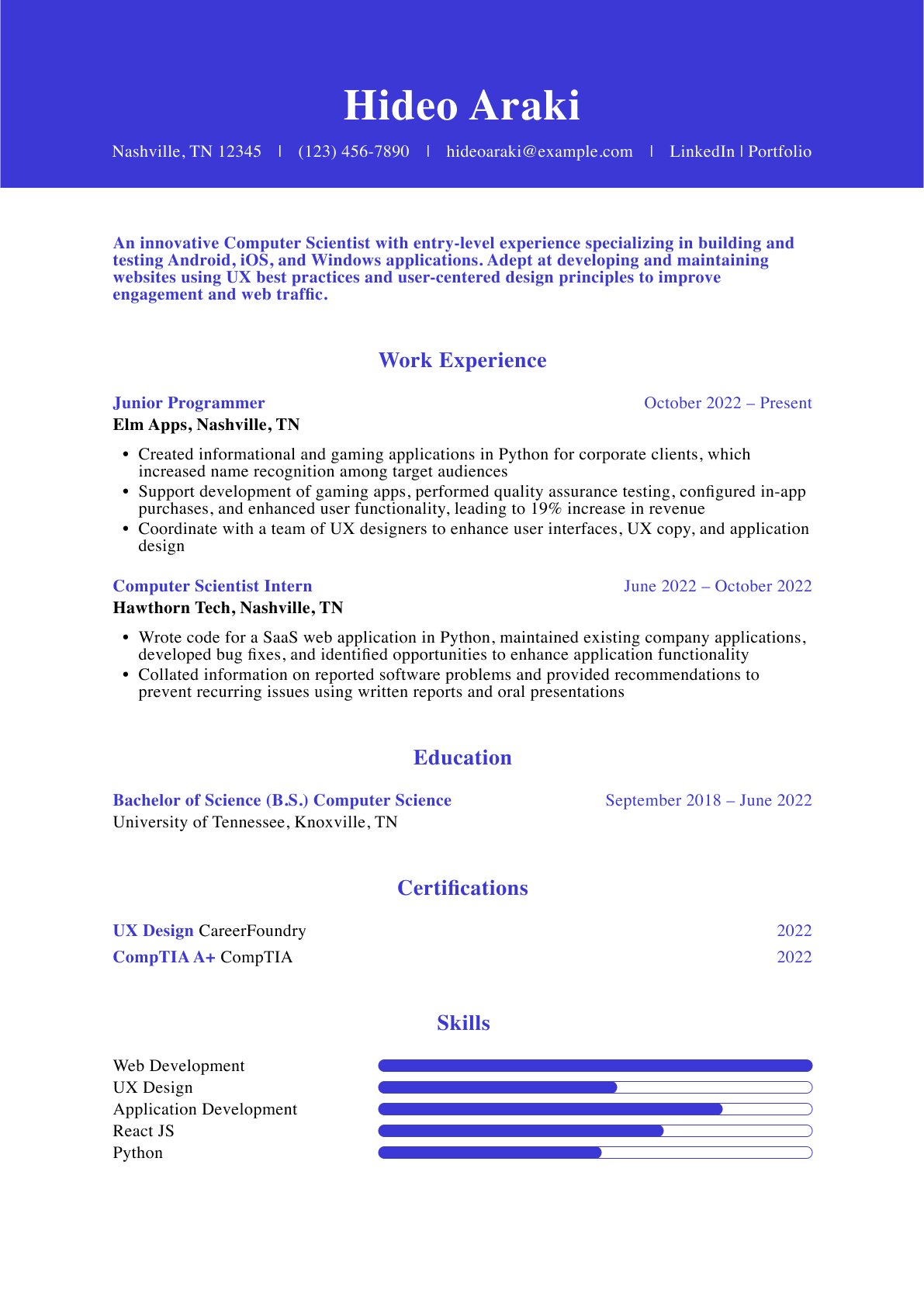
- HOME HOME HOME
- WHY PONGO? WHY PONGO? WHY PONGO? Why Choose Us? Success Stories Testimonials
- FEATURES FEATURES FEATURES Resume Builder Letter Builder Interview Tips Activity Tracker Job Search
- PLANS PLANS PLANS Memberships Professional Resumes Professional Letters
- HELP HELP HELP
- CAREER CORNER CAREER CORNER CAREER CORNER Blog Resumes Letters Interviews Job Search Work / Life

10 Ways to Describe Fast Food Experience on a Resume

- Maintained high standards of customer service during high-volume, fast-paced operations
- Communicated clearly and positively with coworkers and management
- Mastered point-of-service (POS) computer system for automated order taking
- Handled currency and credit transactions quickly and accurately
- Followed procedures for safe food preparation, assembly, and presentation
- Assisted management with inventory control and stock ordering
- Built loyal clientele through friendly interactions and consistent appreciation
- Resolved complaints promptly and professionally
- Cross-trained and coordinated scheduling with team members to ensure seamless service
- Took initiative to find extra tasks when scheduled duties were completed
It's not that you're trying to fool anyone. After all, as soon as someone sees Tastee McBurger Palace on your resume , they'll know what was in your job description. But if you describe your experience in professional terms, you'll set yourself apart by showing that you understand—and possess—the skills and traits that can make someone a valuable employee in any field.
RELATED LINKS Writing a Resume When You Have No Experience Writing a Resume When You Haven't Worked for Years What Counts as Experience on a College Grad's Resume


IMAGES
VIDEO
COMMENTS
If you can't see the templates, change your display language to English: Go to "Manage Your Google Account" → "Personal Info" → "General Preferences for the Web/Language.". Click "Edit" and select English. Choose a Google Docs resume template to build a simple resume.
Set the correct font size. As a rule of thumb, go for 11-12 pt for normal text and 14-16 pt for section titles. Use a PDF file. Always save your resume as a PDF file, unless the employer specifically requests otherwise. Word files are popular, but there's a good chance they'll mess up your resume's formatting.
Don't create your resume from scratch. Use one of our proven resume templates and kick start your search from the beginning. Build a resume with a template. Create your resume in minutes with Indeed's free resume builder. Download it to your computer or use it to apply for any job on Indeed.
Related: Resume samples and templates to inspire your next application. 2. Include your name and contact information. Your resume should begin with your name and contact information, including your professional email address and phone number. You have a choice about whether or not to include your mailing address.
4. Edit it Down. Odds are high that what you have right now exceeds the recommended one page. (Seriously, unless you're an executive with 10 or more years of experience, it shouldn't be more than one page.) So, your goal in this step is to brutally cut out anything that isn't serving a clear purpose in your resume.
One of the most convenient ways to make a resume is to download a free resume template. To get started, download the template below and fill in each section as you follow our simple writing steps. Download This Free Template. 2. Enter your contact information.
5. Don't Forget Your Education. If you're still in school or just graduated, your education can go at the top of your resume, but for pretty much everyone else, this goes near the bottom. Most people include their school, graduation year (for folks less up to about a decade out of school), major, and degree.
1) Always use an online resume builder, instead of Microsoft Word. It's always better to use an online tool instead of Microsoft Word. Creating a resume template on Easy Resume will allow you to access your resume at any time. And access to unlimited resumes and a great selection of professional design templates.
With the amount of competition for each job posted, it is crucial to customize rather than use one general resume for all jobs. Using keywords. Review the job description, identify the keywords, and check your resume for those same words. Resources such as Jobscan help you run your resume and the job description to assess how close of a match ...
Create a resume for free, easily. Pick a template, use built-in content, and download with one click. Tools. Resume Builder Create a resume in 5 minutes. Get the job you want. ... Make your resume fast. Build your resume fast and easily with our online resume builder. It's packed with professional templates and step-by-step assistance.
9. Replace your objective with a summary statement. Instead of writing a resume objective, consider using a more modern approach with a resume summary. Whereas a resume objective explains your career goals, a resume summary outlines your unique and relevant qualifications.
Set your resume margins to 1" on all sides of the page. Choose a modern and professional resume font like Arial or Georgia and set it to 12 pt. Double check if your resume sections stand out and make it easy for employers to find relevant information about your experience or skills.
Don't let your resume hold you back from getting the job you want. Our builder software helps you create a resume that highlights your qualifications and lands you more interviews. Applying for jobs is hard, but our resume builder makes it easy. Download free templates, read expert writing guides, and try our software today.
Create easier with the Adobe Express resume maker. Make, save, and share a captivating resume with the Adobe Express online editor. Depending on your needs, search for resume templates by style, industry, or aesthetic. Personalize every element in your project with our simple drag and drop online editor. Include icons, shapes, graphics, and ...
Our online resume builder offers a quick and easy way to create your professional resume from 25+ design templates. Create a resume using our AI resume builder feature, plus take advantage of expert suggestions and customizable modern and professional resume templates. Free users have access to our easy-to-use tool and TXT file downloads.
Create Your resume In Minutes - Easy and Fast #resumetemplates #resumemaking #howtomake📃 Watch related playlists- https://www.youtube.com/playlist?list=PLC...
Choose clear, legible fonts. Go for one of the standard CV typefaces: Arial, Tahoma, or Helvetica if you prefer sans-serif fonts, and Times New Roman or Bookman Old Style if serif fonts are your usual pick. Use 11 to 12 pt font size and single spacing. For your name and section titles, pick a 14 to 16-pt font size. 2.
A woman works on a laptop computer and writes on a pad of paper, with resumes floating behind her. There's also a list with the title "How To Show You Are a Quick Learner on Your Resume" and these steps: 1. Get comfortable with ways to say fast learner 2. Use adjectives like adept, capable, receptive, and versatile 3. Convey your fast learning skills throughout your resume 4.
To create a virtual environment, open a new terminal window and type in: python3 -m venv --system-site-packages yolo_object. This will create a new virtual environment called "yolo_object". You can find the folder of this virtual environment under home/pi and it will be called "yolo_object". After creating the venv, enter into it by typing in:
Here are 10 resume-worthy descriptions of fast food skills you might not have considered: Maintained high standards of customer service during high-volume, fast-paced operations. Communicated clearly and positively with coworkers and management. Mastered point-of-service (POS) computer system for automated order taking.